Title: The Alphabet of Sacred Geometry
Author: Alloya Huckfield
Description: "Explore the fundamentals of sacred geometry: the point, line, circle, triangle, and square. Discover how these basic shapes form the foundation of nature, art, and architecture."
tags:
- Point
- circle
- triangle
- square
- geometry
- Monad
- Bindu
- Pythagorean
- sacred-geometry
icon: LiAsteriskthe-alphabet-of-sacred-geometry

Understanding Sacred Geometry begins with exploring the basic shapes that form the foundation of all complex geometric patterns in nature and design. These shapes appear as perfect proportions with deep symbolic meaning throughout the natural world and in humanity's greatest architectural works. They represent a visual language that connects mathematics, nature, and spiritual understanding across diverse cultures and time periods. The point, line, triangle, square, and circle serve as the alphabet of this universal language, creating a bridge between the measurable physical world and the intangible realm of meaning and consciousness.
Sacred geometry reveals itself in the spiral of a nautilus shell, the hexagonal chambers of a honeycomb, the branching patterns of trees, and the proportions of the human body. These same fundamental patterns appear in the architecture of ancient temples, cathedrals, mosques, and pyramids worldwide, suggesting that our ancestors recognized and honoured these recurring mathematical relationships as expressions of cosmic order. By studying these basic geometric forms, we begin to see the world through a different lens—one that perceives the mathematical harmony underlying all creation.
When we observe that the same proportions appear in structures built by civilizations separated by vast distances and time, we discover a compelling mystery: how did diverse cultures arrive at the same geometric principles? Perhaps these shapes represent something fundamental about reality itself—a hidden architecture that our ancestors intuited through careful observation of natural patterns. The study of sacred geometry thus becomes an exploration not just of shapes and measurements, but of the very ordering principles that govern both the physical universe and human consciousness.
As we progress through this chapter, we will examine each foundational shape in detail, starting with the simplest element—the point—and building toward more complex forms and relationships. Each geometric form carries multiple layers of meaning: mathematical, natural, and metaphysical. By understanding these basic building blocks, we prepare ourselves to comprehend the more intricate sacred patterns that have fascinated humanity for millennia and continue to influence contemporary design, art, and architecture today.
The Point
At the heart of sacred geometry lies a profound beginning - the simple act of placing a pencil on paper to create a point. This initial gesture, seemingly mundane, contains deep significance. Before any sacred geometric pattern can emerge - whether it's flower-of-life-the-vesica-piscis, the Vesica Piscis, or the golden-spiral - there must first be this singular point of origin. The point represents the most fundamental geometric concept: position without dimension. When we place our pencil on the blank page, we are creating the first bridge between the un-manifested world of potential and the manifested world of form. This dot becomes the center point from which all other geometric forms will emerge.
From this single point, we can extend outward in all directions equally to create a circle - the first sacred form that contains all potential within it. The circle cannot exist without first establishing its center point. This relationship between point and circle mirrors many spiritual traditions that speak of creation emerging from a singular source. In metaphysical traditions, the point symbolizes unity consciousness - the state of undifferentiated oneness that precedes all creation. It represents the monad in Pythagorean philosophy, the Bindu in Hindu traditions, and the divine singularity in various mystical systems.
The Bindu (Sanskrit for "point" or "dot") represents the primordial seed from which all creation emerges. In sacred geometric understanding, the Bindu is not merely a mathematical point but a profound cosmological concept with several key dimensions: The Bindu exists in a state of infinite potential—it contains everything in un-manifested form. It represents the moment just before creation begins, holding all possibilities within its seemingly dimensionless nature. This paradox is central to understanding the Bindu: though it appears as nothing, it contains everything.
In Hindu and Tantric traditions, the Bindu sits at the center of the sri-yantra and other sacred diagrams. Shiva (consciousness) and Shakti (energy). From this perspective, the Bindu serves as the bridge between the un-manifested absolute and the manifested universe. The Bindu also relates to consciousness itself. In meditation practices, particularly within yoga traditions, practitioners focus on the Bindu as a way to access pure awareness beyond form. The third eye chakra (Ajna) is sometimes represented as a Bindu, suggesting this point as a gateway to transcendent awareness.
The point serves as both beginning and end in sacred geometric creation—it is where the compass first touches the paper to begin a circle, and it is where complex patterns ultimately lead the consciousness back to unity. This primordial point contains within it all possibilities, all potentials, all futures - yet remains perfectly still and dimensionless. The dot also symbolizes the individual consciousness - our own center of awareness from which we perceive and interact with the world. Just as the geometric point serves as the reference for all measurements and relationships in sacred geometry, our consciousness serves as the reference point for our experience of reality.
In many spiritual traditions, meditation practices focus on returning awareness to this center point - the still, quiet center within that exists beyond time and space. Like the geometric point that has position but no dimension, this center of consciousness is said to be everywhere and nowhere simultaneously. The dot also represents the present moment - the infinitesimal yet eternal "now" that exists between past and future. In sacred geometry, all forms unfold from this present moment of creation, just as all geometric forms unfold from the initial point.
When we begin our sacred geometric drawings with this simple dot, we are participating in a symbolic act of creation that mirrors the emergence of the universe itself. We are acknowledging that all complexity, all pattern, all form must begin with unity. The humility of starting with this smallest element teaches us that the grandest structures in our universe - from galaxies to DNA - emerge from singular points of energy coming into relationship. As you progress in your understanding of sacred geometry, remember that each time you place that pencil on paper to begin a new construction, you are re-enacting the primal moment of creation - bringing forth order from emptiness, form from formlessness, and multiplicity from unity.
The mathematical point shares conceptual territory with the Bindu but has its own significance within Western sacred geometric traditions: A point in sacred geometry represents the dimension zero—it has position but no extension. It serves as the fundamental building block from which all other geometric forms arise. When a point moves, it creates a line (dimension one). When a line moves perpendicular to itself, it creates a plane (dimension two). This progression reveals how complexity unfolds from simplicity. The point represents unity before differentiation.
In the Pythagorean tradition, the monad (represented by a point) symbolizes the divine source—singular, indivisible, and the origin of all numbers and forms. In Pythagorean thought, the monad—represented by a simple point—serves as the primordial element of creation. The Pythagoreans considered it to be divine for several key reasons:
First, the monad is singular—it stands alone as the first unit of existence. Unlike other numbers that can be divided or combined, the monad remains fundamentally indivisible. This quality of indivisibility was seen as a reflection of divine unity.
Second, the monad functions as the generative source of all other numbers. The Pythagoreans viewed the numerical sequence as flowing from this single point: 1 creates 2, 2 creates 3, and so forth. This generative capacity mirrors the divine act of creation. The monad's significance extends beyond simple arithmetic. For the Pythagoreans, numbers were not merely quantitative tools but embodiments of metaphysical principles.
The monad represents several important qualities. The monad symbolizes wholeness and completeness as the number one. It establishes the principle of sameness that allows things to be recognized as themselves. Though singular, it contains within itself the potential for all subsequent numbers.
The monad represents several important qualities that have profound implications in philosophical and metaphysical traditions. The monad symbolizes wholeness and completeness as the number one. This unity is not merely a mathematical concept but represents the fundamental indivisible nature from which all else emerges. In many traditions, this unitary principle serves as both the origin and ultimate destination of all existence.
The monad establishes the principle of sameness that allows things to be recognized as themselves. This quality of identity is essential for coherent reality, providing the foundation for all logical systems and rational thought. Without this principle of self-identity that the monad represents, nothing could maintain consistent properties or be differentiated from anything else.
Though singular, the monad contains within itself the potential for all subsequent numbers. This generative capacity makes it not merely a static point but a dynamic principle. The monad doesn't just precede multiplicity—it contains multiplicity in seed form. This paradoxical aspect of the monad fascinates philosophers: how can absolute simplicity give rise to complexity? The answer lies in understanding that the monad's simplicity is not emptiness but rather a concentrated fullness.
In Neoplatonic philosophy, the monad was associated with the concept of "the One" from which all reality emanates. For Pythagoras and his followers, the monad represented not just a number but a metaphysical principle—the first cause and the essential building block of reality. Later, philosophers like Leibniz developed sophisticated monadologies where monads were understood as the fundamental substances of the universe, each reflecting the entire cosmos from its unique perspective.
The monad also serves as a powerful symbol in contemplative traditions, representing the reunification of consciousness with its source. The journey from multiplicity back to unity mirrors spiritual paths across various cultures, where the fragmented self seeks integration and wholeness.
The Pythagoreans developed a rich philosophical framework around the monad, attributing to it several profound qualities that reveal its central importance in their worldview. These attributes were not merely abstract concepts but formed the foundation of their understanding of reality itself.
Within Pythagorean thought, the monad was intimately associated with the intellect, or nous. They viewed the monad as the embodiment of pure thought and consciousness—the primordial awareness that precedes all differentiation. This intellect was considered divine in nature, representing the capacity for understanding that exists prior to any specific object of knowledge. Just as the monad generates all numbers while remaining distinct from them, the intellect comprehends all forms while maintaining its unified nature. This connection between the monad and nous influenced later philosophical developments, particularly in Neoplatonism, where the One was described as a transcendent intellect from which all reality emanates.
The Pythagoreans also understood the monad as representing form rather than matter. In their metaphysical system, form provided definition, structure, and meaning to otherwise undifferentiated matter. The monad, as the principle of form, gave shape and identity to the cosmos. This distinction parallels their understanding of odd and even numbers—odd numbers (beginning with the monad) were considered limited and defined, while even numbers represented the unlimited and indefinite. Through this association with form, the monad became the organizing principle that brought order to chaos, similar to how a geometric point defines and organizes space around it.
The Pythagoreans identified the monad with the principle of good. In their axiology, goodness was associated with unity, harmony, and proportion—all qualities that flowed from the monad. They believed that just as mathematics revealed perfect proportions and harmonies derived from simple numerical relationships, so too did ethical living involve achieving harmony within oneself. The monad represented this ideal harmony, the perfect balance that constituted goodness. This association between unity and goodness later influenced Plato's conception of the Form of the Good as the highest principle in his metaphysical system.
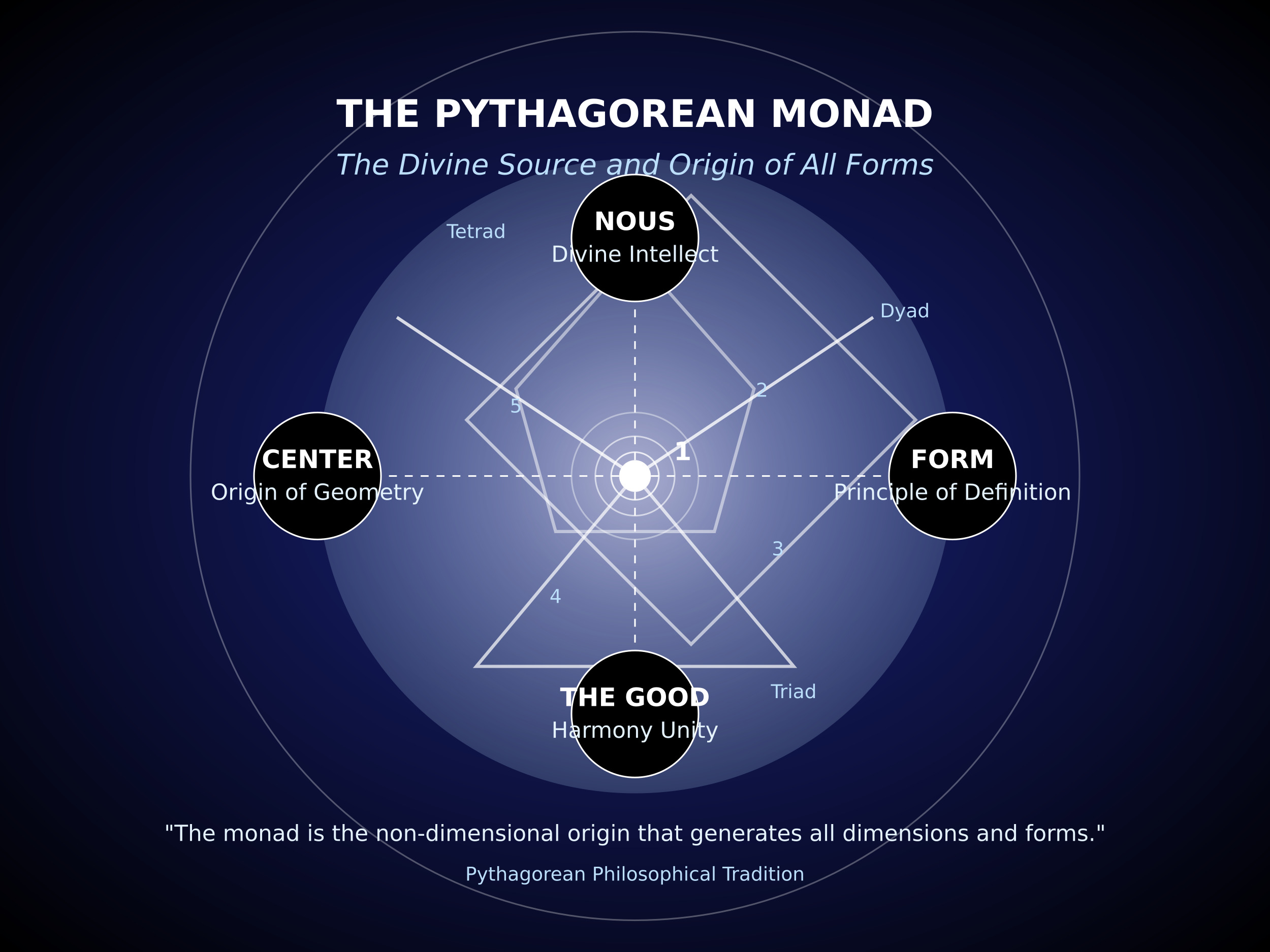
In Pythagorean geometry, the monad served as the center point from which all geometric forms emerge. They conceived of the point as having position but no dimension—a perfect representation of unity that nonetheless generates multiplicity. From this dimensionless center, lines, planes, and solids could be constructed, forming increasingly complex geometric structures. The Pythagoreans saw profound significance in this progression from simplicity to complexity, understanding it as a model for how the cosmos itself unfolds from a singular divine principle. The monad as geometric center also represented balance and equilibrium—the still point around which all motion occurs, again reinforcing its association with harmony and order.
These attributes were deeply interconnected in Pythagorean thought. The monad as intellect, form, goodness, and geometric center collectively expressed their understanding of a fundamental principle that was simultaneously mathematical, metaphysical, ethical, and cosmological. This unification of multiple domains of knowledge under a single principle reveals the holistic nature of Pythagorean philosophy, where mathematics was not separate from ethics or metaphysics but formed an integrated understanding of reality with the monad at its heart.
In Pythagorean cosmology, the monad serves as the model for the universe itself. Just as all numbers proceed from the monad, all beings proceed from a single divine source. This conception influenced later Neoplatonic ideas about emanation—the theory that all existence flows from and returns to a singular divine reality.
The geometric representation of the monad as a point also carries cosmological significance. From this dimensionless point, all other geometric forms can be derived: two points create a line, three create a triangle, and so forth. This progression mirrors the Pythagorean understanding of how complex reality emerges from simple principles.
The Pythagorean concept of the monad significantly influenced later philosophical traditions. Plato's Theory of Forms draws from these ideas about divine unity. Later, Neoplatonists like Plotinus developed the concept further, describing "The One" as the transcendent source of all being.
This mathematical-metaphysical framework established by the Pythagoreans remains influential in Western thought, providing an early model for understanding how multiplicity might emerge from unity and how abstract principles might structure physical reality.
The Circle ○

At its most basic level, the circle represents wholeness. Unlike shapes with corners or edges, the circle contains no beginning or end. Every point along its circumference exists in perfect relationship to the center. This mathematical property makes the circle a natural symbol for eternity, completion, and the absolute.
The circle, manifests abundantly in nature, from the grand celestial dance of planets and stars to the intricate, unseen worlds of cells and atoms. Water, the very essence of life, naturally forms circles in droplets and ripples on the surface of still ponds, symbolizing the unending flow and interconnectedness of al of creation. This shape is a testament to life's innate tendency towards unity and harmony.
The Pantheon in Rome stands as perhaps the most remarkable circular sacred structure in Western architecture. Its defining feature, the oculus—a perfect circular opening 30 feet in diameter at the dome's apex—creates a direct connection between earth and sky. This opening admits a concentrated beam of sunlight that traces a predictable path across the interior as the day progresses, functioning as both timekeeping device and cosmic connector. The Romans understood that this moving circle of light represented more than mere illumination—it symbolized the divine presence manifesting within human space.
This pattern of circular sacred architecture extends far beyond Rome. Consider the rotundas of Byzantine churches, where the circle represented divine perfection and eternity. The circular plans of these structures weren't merely aesthetic choices but cosmological statements—microcosms reflecting the macrocosm of creation. The dome above, often adorned with celestial imagery, represented heaven itself, with the circular base representing earth. The worshipper standing at the center occupied the The the-axis-mundi—the sacred center point connecting realms.
When we examine Byzantine rotundas and domed churches more closely, we discover a rich theological language encoded in their circular elements. Byzantine architects inherited the Roman mastery of circular construction but infused it with profound Christian cosmology. For Byzantine theologians, the circle represented divine perfection because it has no beginning or end—a perfect geometric expression of God's eternal nature. The circular plan allowed Christians to physically inhabit this theological concept, experiencing divine perfection through architectural form.
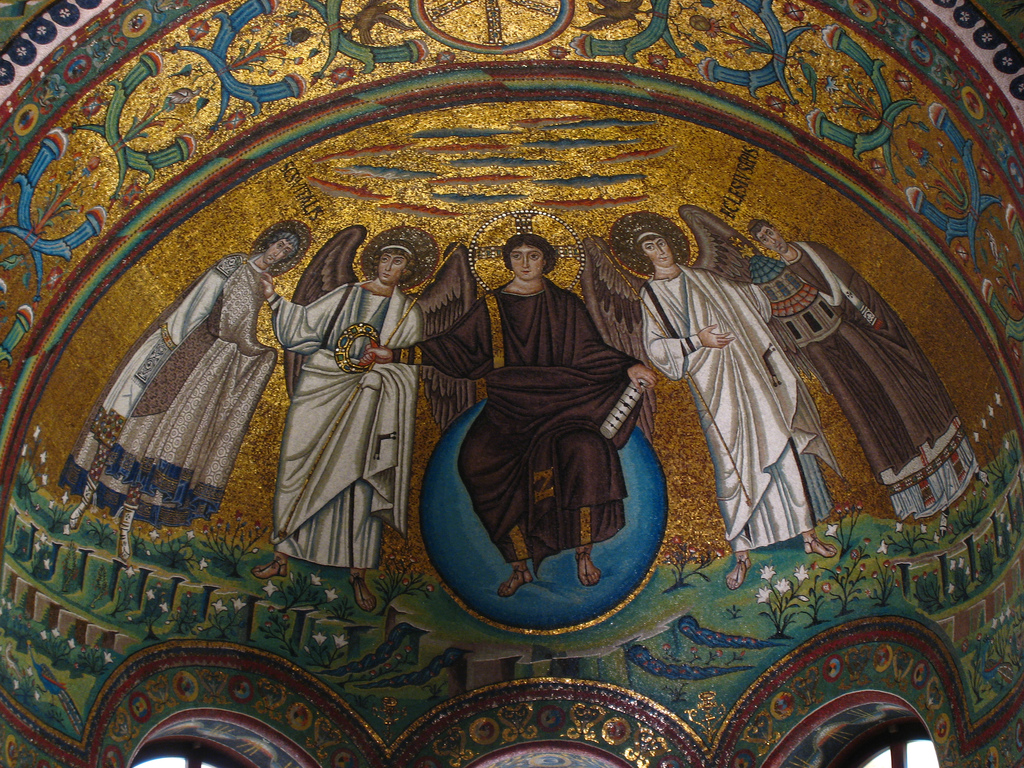
The Church of San Vitale in Ravenna offers a remarkable example. Its octagonal plan with a central circular space creates a transitional geometry—the octagon mediates between the square (representing earth) and the circle (representing heaven). As worshippers move from the square outer walls toward the circular central space, they physically participate in a journey from earthly reality toward divine perfection.
The Byzantine dome represents perhaps the most significant development of circular sacred architecture. In churches like Hagia Sophia, the dome doesn't merely cover the space—it becomes the central organizing principle for the entire structure. The dome's immense circular base (created by the ring of windows at its perimeter) seems to float mysteriously above the space, creating what contemporaries described as the impression of "heaven on earth."
Byzantine domes typically featured an image of Christ Pantocrator (the All-Ruler) at their apex, surrounded by concentric rings depicting angelic hierarchies, saints, and biblical scenes. This imagery wasn't decorative but pedagogical and theological—the dome became a cosmic map showing the divine order of creation. The worshipper looking upward could "read" this visual text, understanding their place within the greater cosmic hierarchy.
Byzantine architects employed sophisticated mathematical relationships in these circular forms. The ratio between the height of the dome and the diameter of its base often approximated divine proportions (what we now call the Golden Ratio. These mathematical harmonies weren't coincidental but intentional—they reflected the Byzantine belief that God had ordered the cosmos according to perfect mathematical relationships.
The pendentives—those triangular segments that allow a circular dome to rest on a square base—represent a remarkable geometric innovation that solved the ancient architectural problem of placing a round form atop a square one. This technical solution carried profound symbolic meaning, representing the reconciliation of heavenly perfection with earthly limitation.
Byzantine architects mastered the manipulation of light through circular forms. The ring of windows at a dome's base admitted light that seemed to emanate from heaven itself. As sunlight moves through these windows throughout the day, the interior illumination constantly changes, creating a dynamic experience that mirrors the living, breathing cosmos.
In churches like Hagia Sophia, thousands of gold tesserae (small mosaic pieces) in the dome reflect this light, creating a shimmering effect that dematerializes the massive structure. This visual phenomenon transforms solid architecture into something that appears to transcend physical laws—a perfect architectural expression of divine transcendence.
For the Byzantine worshipper, standing at the center point beneath the dome placed them at what religious historians call the axis mundi—the cosmic axis connecting heaven and earth. This positioning wasn't accidental but liturgically significant. During the Divine Liturgy, this central point became the location where heaven and earth were believed to intersect most powerfully.
The circular movement of priests and deacons around the altar during Byzantine liturgies reinforced this cosmic symbolism. Their circular processions mirrored the perceived movements of heavenly bodies and angelic beings, transforming ritual action into a participation in cosmic order.
The Byzantine approach to circular sacred architecture profoundly influenced other traditions. Russian Orthodox churches adopted and elaborated on Byzantine dome symbolism. Islamic architects, while avoiding figurative imagery, embraced and developed the cosmological dimensions of circular and spherical forms in mosque design. Even Western Gothic cathedrals, though emphasizing vertical lines and pointed arches, incorporated rose windows—massive circular openings filled with stained glass—that served as geometric expressions of divine perfection.
When we enter a Byzantine rotunda today, we experience something the original architects understood intuitively—circular architecture affects human consciousness differently than rectilinear forms. The absence of corners creates a sense of boundlessness. The perfect symmetry of the circle creates a peculiar acoustic phenomenon where sounds from different points converge at the center, creating what acousticians call "focusing effects." This sonic phenomenon reinforced the sense of the center as a place of special power and significance.
The circular plan also democratizes sacred space in a unique way. Unlike axial plans that create hierarchical distinctions between spaces closer to or further from an altar, the circle creates equal access to the sacred center from all directions. This architectural equality reflected theological concepts about equal access to divine grace—a literal concrete expression of abstract theological principles.
This sophisticated integration of theology, cosmology, mathematics, light, and human psychology within Byzantine circular architecture reveals why these forms have maintained their power to move us across centuries. They speak to something fundamental in human perception—our innate recognition of the circle as a symbol of completion, perfection, and divine order. In these sacred circular spaces, geometry becomes theology, and abstract cosmic principles become tangible, inhabitable realities.
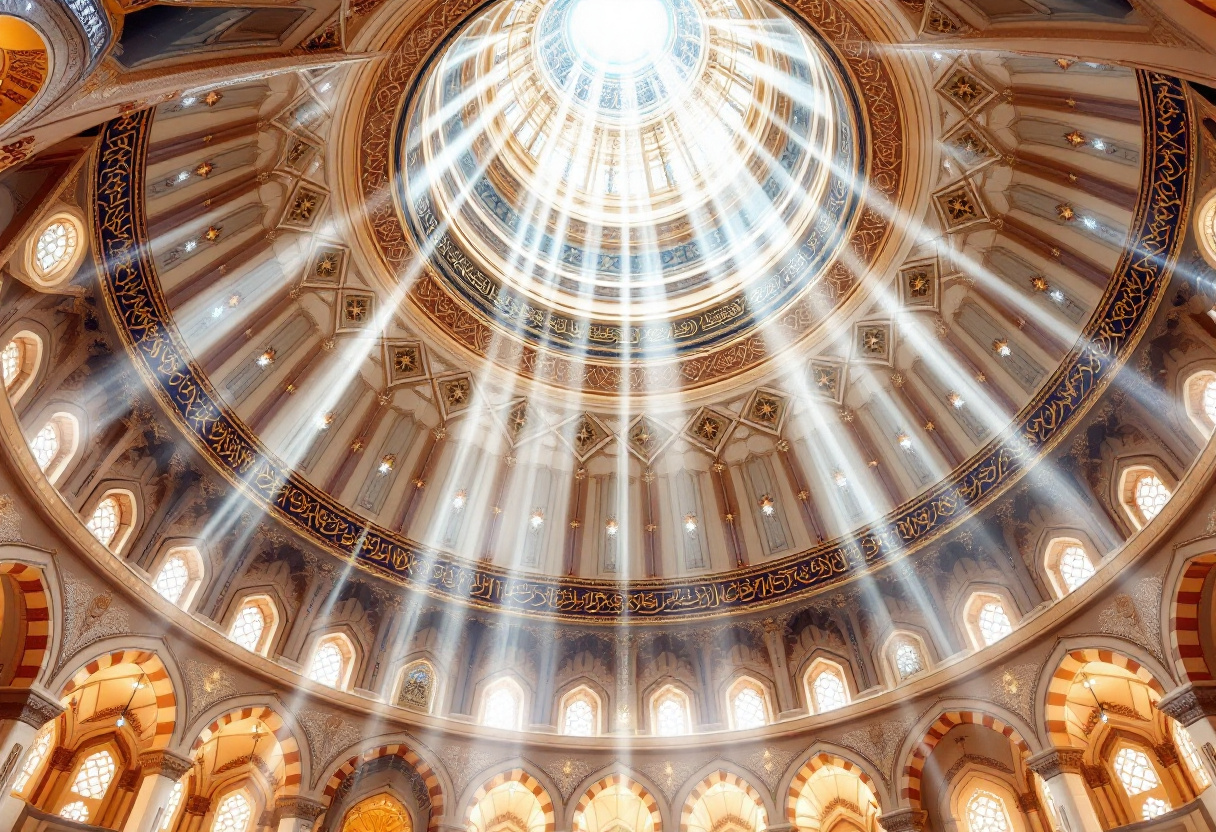
In Islamic architecture, we find the circle expressed through intricate geometric patterns and in the domes of mosques. These domes often feature concentric circular patterns radiating from a central point, visually representing the universe emanating from divine unity. The circle here becomes a meditation on tawhid—the oneness of God that stands as the cornerstone of Islamic theology.
Islamic geometric patterns frequently use the circle as their foundation. These patterns develop through precisely dividing the circle and connecting points to create intricate designs. Craftsmen use a compass to draw perfect circles as the starting point for generating complex geometric compositions. These patterns often feature six-fold and eight-fold symmetry derived from circular divisions.
The mihrab (prayer niche) in mosques often features semi-circular arches adorned with circular and radial patterns. These designs help focus the worshipper's attention toward Mecca during prayer. Similarly, the minaret—the tower from which the call to prayer is announced—frequently incorporates circular elements in its cylindrical form and spiral staircases.
The concept of tawhid (the oneness of God) finds expression through circular geometry in Islamic architecture. The circle has no beginning or end, symbolizing eternity and divine unity. All points on a circle maintain equal distance from the center, representing the equal relationship of all creation to the Creator. When circles interconnect in Islamic patterns, they create a visual meditation on the interconnectedness of all existence while maintaining the primacy of divine oneness.
The muqarnas—stalactite-like decorative vaulting used in Islamic architecture—often incorporates circular forms arranged in three-dimensional compositions. These elements create a transition between square and circular spaces, representing the harmony between earthly and celestial realms.
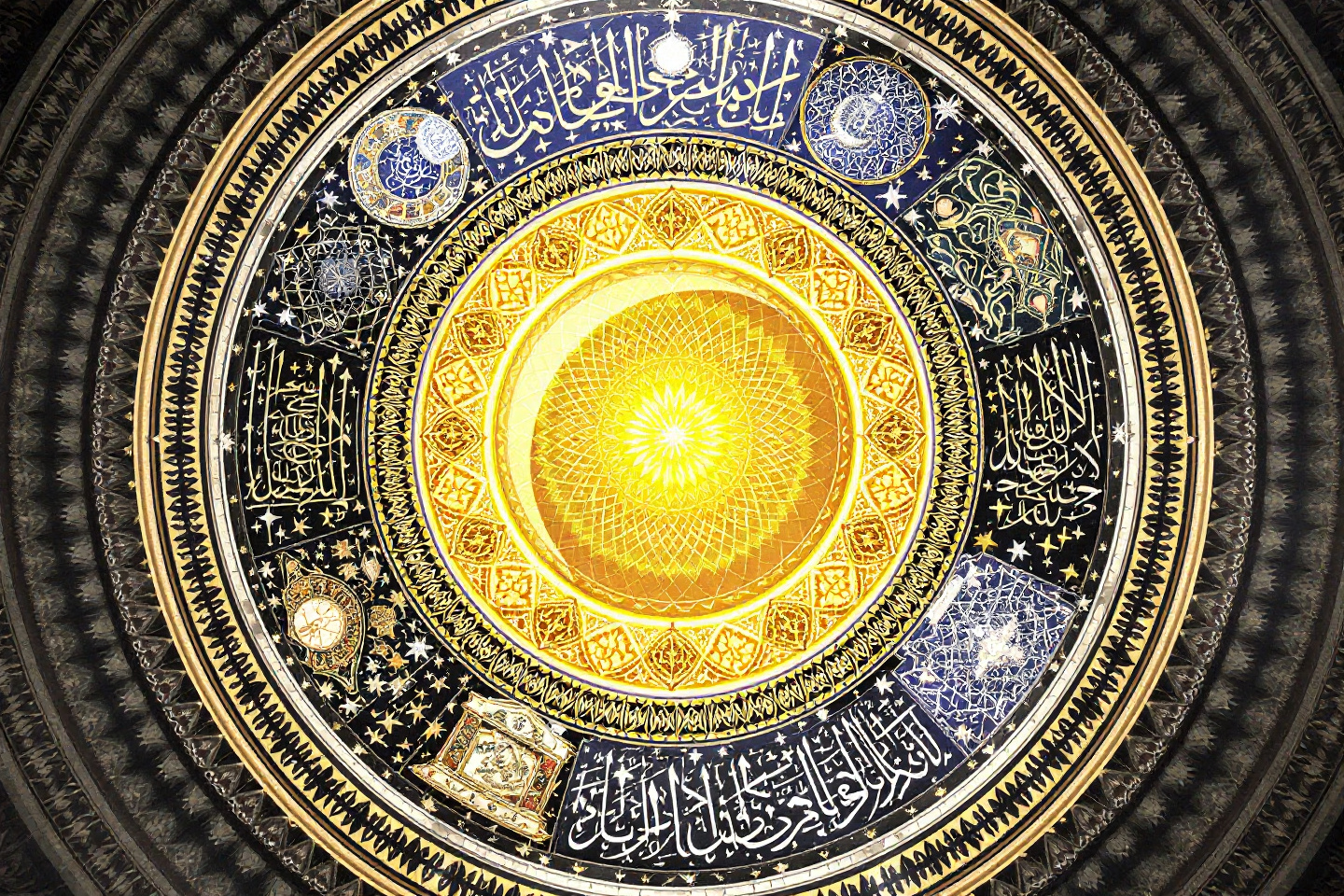
Islamic calligraphy also employs circular compositions, particularly in designs called "daireh" (circle). Sacred texts arranged in circular patterns reinforce the concept of divine perfection and completeness expressed through both word and form. The mathematical precision in Islamic circular patterns demonstrates an understanding of geometric principles that predates many Western mathematical discoveries. These designs incorporate concepts like the golden ratio and elaborate tessellations based on precise circular divisions.
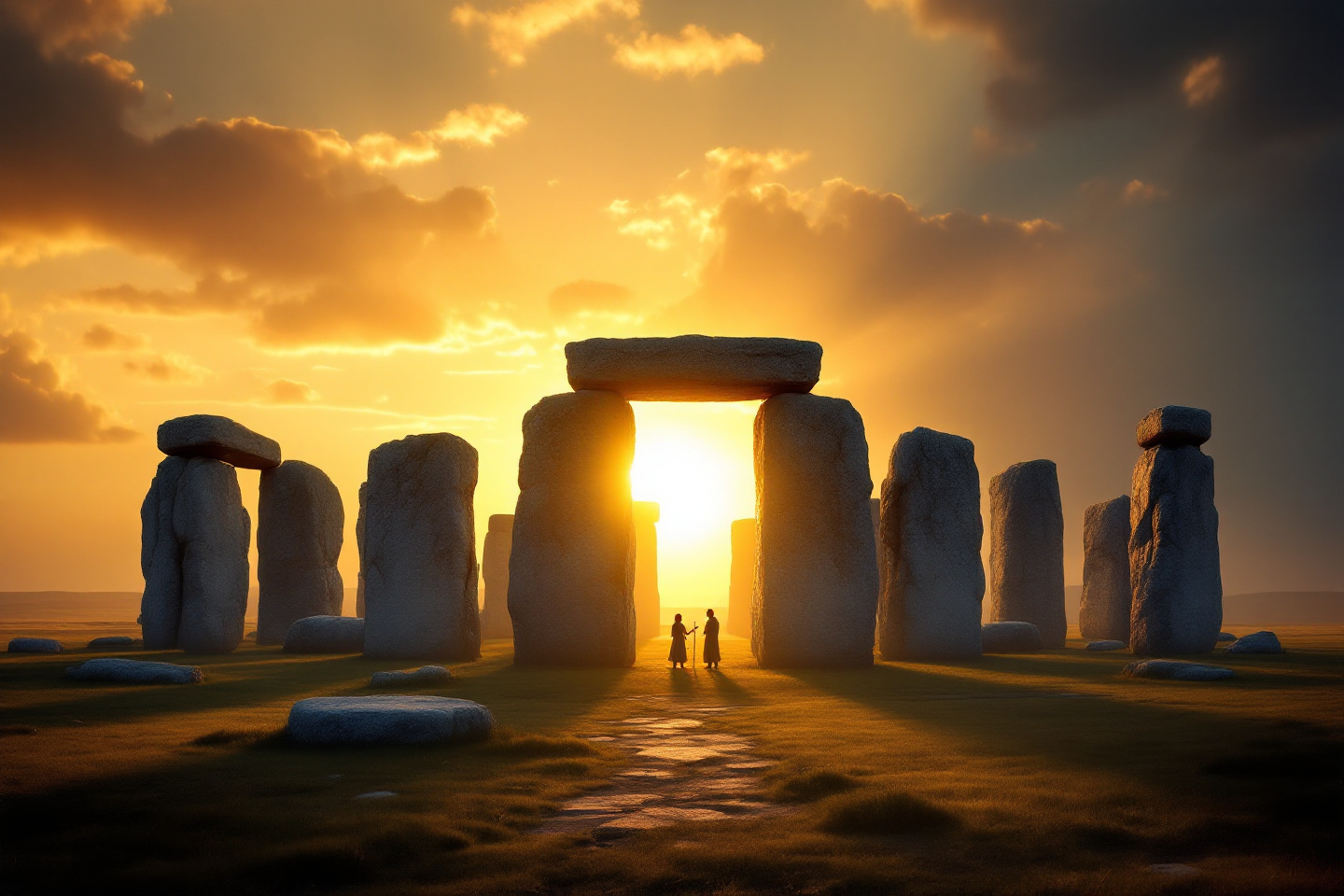
The circle's significance extends to ritual spaces as well. Stone circles like Stonehenge aligned with solar and lunar cycles, transforming circular architecture into astronomical calendars. The circle represents one of humanity's most fundamental symbolic forms, and its application in ritual spaces reveals our ancestors' sophisticated understanding of both astronomy and sacred geometry. Stone circles like Stonehenge demonstrate how ancient societies transformed circular architecture into precise astronomical calendars, creating spaces that connected earthly rituals with celestial patterns.
Stonehenge stands as perhaps the most famous example of circular ritual architecture with astronomical significance. Built in several stages between approximately 3000-1500 BCE, this monument's circular design wasn't merely aesthetic but functional. The stones were positioned with remarkable precision to mark critical celestial events:
The summer solstice alignment remains the most well-known feature, where the rising sun appears directly above the Heel Stone when viewed from the center of the circle. This alignment creates a dramatic visual effect as sunlight penetrates through the central trilithon archway, casting a beam precisely into the heart of the circle.
Less commonly discussed but equally significant is the winter solstice alignment, where the setting sun aligns with the center of the monument when viewed from the Avenue. These solar alignments effectively transformed the circular monument into a giant calendar marking the yearly cycle.
The sophistication of Stonehenge extends beyond solar observations. Researchers have identified probable lunar alignments within the stone arrangement that track the complex 18.6-year lunar cycle. The placement of specific stones appears to mark the extreme positions of moonrise and moonset, known as lunar standstills.
This lunar tracking capability demonstrates that circular ritual spaces served as multi-functional astronomical instruments, capable of measuring both solar and lunar cycles with remarkable accuracy. The builders understood that circular architecture provided the ideal geometric form for creating these calendrical functions, as the circle naturally reflects the cyclical patterns observed in celestial movements.
Stonehenge represents just one example within a global tradition of circular astronomical calendars. Throughout Europe, hundreds of stone circles demonstrate similar astronomical alignments:
- Callanish on the Isle of Lewis in Scotland features stone circles and alignments that track both solar and lunar cycles.
- The Goseck Circle in Germany, dating to approximately 4900 BCE, contains precisely aligned gates marking the winter and summer solstice sunrise and sunset points.
- The Medicine Wheel in Wyoming shows alignments to summer solstice sunrise and sunset as well as the rising points of important stars.
These circular structures share common architectural principles despite their geographic separation, suggesting that ancient societies independently discovered the effectiveness of circular design for astronomical observation. What elevates these structures beyond mere astronomical instruments is their dual function as sacred spaces. The circular form served as a perfect geometric interface between earthly rituals and celestial movements. Several key characteristics define this sacred-astronomical relationship:
- The circle creates a microcosm of the celestial dome above, allowing worshippers to symbolically stand at the center of the cosmos.
- Circular movement around these monuments mimics astronomical motion, potentially forming the basis for ritual circumambulation practices found across many traditions.
- The precise alignment of architectural elements with celestial events transforms natural phenomena into scheduled ritual occasions, embedding astronomical knowledge within religious practice.
- The circular form creates a distinct boundary between sacred and profane space, with astronomical alignments serving as temporal gateways between ordinary and sacred time.
The monuments themselves thus serve as evidence of advanced mathematical thinking, preserving this knowledge in stone for millennia before written mathematical treatises existed. This integration of mathematics, astronomy, and sacred architecture in circular forms demonstrates that our ancestors possessed a holistic understanding of these disciplines rather than viewing them as separate fields of knowledge. The circle became the geometric form that elegantly unified these domains of understanding. What makes circular sacred architecture so compelling is its ability to create experiential understanding. When a person enters a circular sacred space, the absence of corners and the equal distance to the center from all points creates a unique psychological effect—one feels embraced, contained, and centred simultaneously. The circular form subtly reminds us that we stand at the intersection of earth and heaven, time and eternity.
Sound behaves differently in circular spaces as well. The acoustics of domes and circular chambers often create unique resonance patterns that enhance chanting, prayer, and music. Some circular chambers produce whispering gallery effects where sound travels along the curved surface, allowing quiet words spoken at one point to be heard clearly at distant points—a phenomenon that seems to transcend ordinary physical laws and thus reinforces the sacred nature of the space.
In your exploration of sacred geometry, the circle in architecture reveals itself not merely as a design element but as a profound symbolic language that speaks to universal human intuitions about divinity, cosmos, and our place within it. These sacred circular spaces continue to move us because they speak to something deeply embedded in human consciousness—our intuitive recognition of wholeness, perfection, and divine order manifested through the perfect geometric form of the circle.
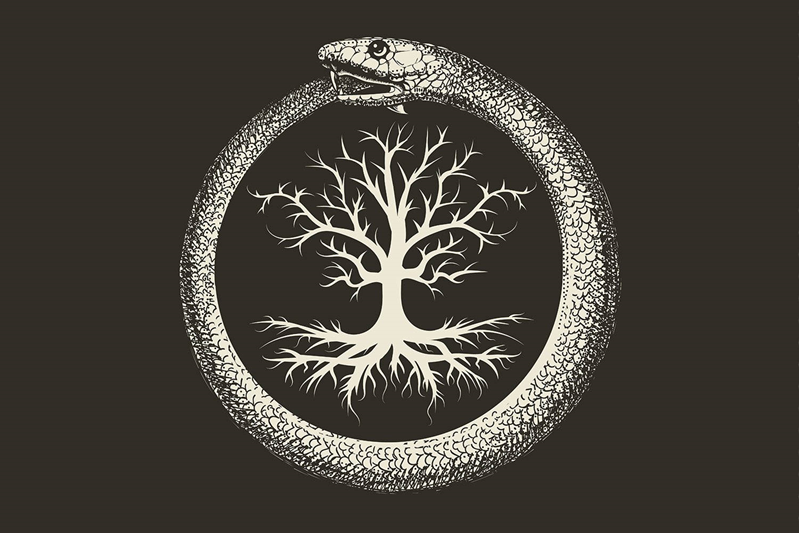
Occult teachings regard the circle as a powerful symbol, encapsulating the notion of eternity, unity, and the primordial essence of creation. With no beginning or end, the circle becomes an emblem of infinity, representing the boundless and eternal cycle of life, death, and rebirth. The esoteric concept of the “ouroboros”—a serpent devouring its own tail—illustrates this infinite loop of renewal and the perpetual dance of creation and destruction.
The ouroboros—the serpent swallowing its own tail is an ancient symbol which represents cyclical nature, the eternal return, and the unity of all things. Alchemists viewed their great work as a circular process of solve et coagula (dissolution and recombination), mirroring how matter continuously transforms while maintaining underlying unity. The circular nature of alchemical transformation echoes through systems like the Hermetic axiom "as above, so below," suggesting a mirroring between macrocosm and microcosm.
Many spiritual and traditional worldviews embrace a circular understanding of time rather than the linear progression often emphasized in modern thinking. In traditional worldviews, time moves in recurring patterns rather than solely forward. This cyclical conception appears in numerous cultural and spiritual systems. Seasonal observation forms a foundation for this understanding. Agricultural societies particularly noted the reliable return of planting seasons, harvest times, and fallow periods. These natural cycles became embedded in cultural calendars and religious observances.
Solar and lunar cycles provide the basis for many traditional calendars. The moon's phases—from new to full and back again—create a visible monthly cycle. Similarly, the sun's annual journey through solstices and equinoxes demonstrates a yearly pattern of death and rebirth, particularly evident in the changing seasons. Religious festivals often mark these astronomical events, reinforcing the experience of time as circular.
In Hindu thought, the universe passes through vast cosmic cycles called kalpas, each containing thousands of yugas (ages). Each kalpa ends with dissolution (pralaya) followed by a new creation. Similarly, the individual soul (atman) passes through cycles of rebirth until achieving moksha. Buddhist cosmology describes universe cycles spanning billions of years, with periods of creation, stability, destruction, and emptiness. The Wheel of Samsara depicts the cyclical nature of existence and rebirth. In Mesoamerican traditions, particularly Mayan and Aztec, interlocking calendar systems tracked cycles within cycles, from the 260-day tzolkin to the 52-year Calendar Round to much longer cycles spanning thousands of years.
This circular understanding challenges the notion of absolute beginnings and endings. Rather than seeing events as final conclusions, a cyclical perspective recognizes that endings contain the seeds of new beginnings—just as winter contains the dormant life that will emerge in spring. The circle as a symbol perfectly captures this understanding, having no beginning or end point, only continuous motion. This differs fundamentally from the linear, progressive view of time often dominant in modern thought, where history moves from definite beginning points toward ultimate conclusions or goals. By examining these cyclical conceptions of time, we gain insight into alternative ways of understanding our place in the cosmos and our relationship with past and future generations.
Many magical traditions employ circular talismans and amulets. These objects, often inscribed with symbols, names, or numbers arranged in circular patterns, were thought to concentrate and direct spiritual energies. The circular form allowed for continuous flow of these energies, creating self-sustaining magical circuits. Medieval grimoires contain numerous examples of such circular designs, from protective pentacles to complex summoning circles used in ceremonial magic. The circle appears prominently in divinatory practices. The circular spread of tarot cards creates a symbolic space where meanings emerge through relationship rather than linear sequence.
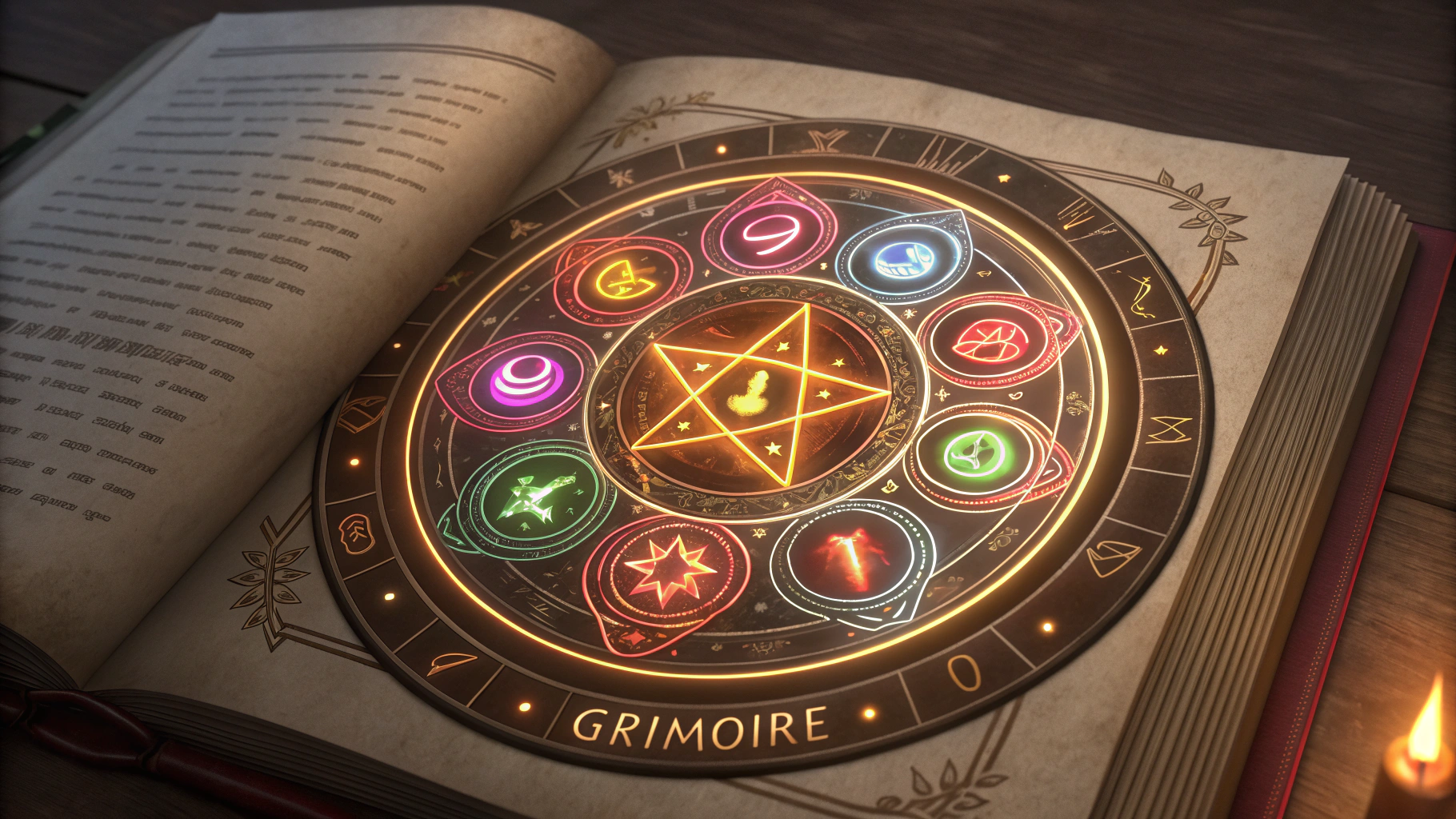
In Western occult traditions, the circle relates to the concept of the sphere of sensation or aura—the energetic field surrounding each person. This personal circle defines the boundary between individual consciousness and the larger world. Magical training often focuses on purifying and strengthening this circular energy field, making it more receptive to beneficial influences while resistant to harmful ones. The magician learns to consciously work with this personal circle, expanding and contracting it as needed for different spiritual operations.
The spiritual significance of the circle extends into modern esoteric systems. Rudolf Steiner's anthroposophy uses the circle to illustrate the relationship between spiritual and material worlds, showing how consciousness evolves through cyclical processes of incarnation.
Rudolf Steiner (1861-1925), the founder of anthroposophy, used the circle as a fundamental teaching tool to illustrate complex spiritual concepts. In Steiner's cosmology, human consciousness doesn't develop linearly but rather moves through cyclical patterns of evolution and transformation.
Steiner conceptualized human evolution as proceeding through great cycles or "epochs," each representing a different stage of consciousness development. The circular nature of this model was intentional—it portrayed how humanity continually returns to similar themes but at higher levels of understanding. This creates not just a circle but a spiral pattern of development.
In anthroposophical diagrams, Steiner often depicted:
- The physical world as the outer rim of a circle
- The etheric (life) forces as an inner concentric circle
- The astral (soul) realm as a yet more interior circle
- The spiritual (ego/I) center as the innermost point
This circular representation shows how human beings exist simultaneously in multiple "worlds" or planes of reality. The physical body exists in material space, while our consciousness extends inward toward spiritual dimensions. Particularly significant in Steiner's work is how the circle represents the process of incarnation and excarnation (death). He taught that:
- The soul descends from spiritual realms into physical incarnation
- Lives through earthly experiences
- Returns to spiritual realms
- Processes those experiences
- Eventually reincarnates to continue its evolutionary journey
This continuous cycle creates a rhythmic pattern that Steiner believed was essential for soul development. Each circuit through this "circle" brings new opportunities for growth and transformation.
The circle thus becomes a teaching tool that helps us visualize complex spiritual concepts about how consciousness moves between material and spiritual realms, how development happens through cyclical patterns, and how apparent opposites (like spirit and matter) can be understood as different points on a unified continuum rather than as separate categories.
Similarly, Carl Jung's mandala studies examined how circular images emerge spontaneously in dreams and artwork during psychological integration, suggesting the circle serves as an archetypal image of the unified self.
The Triangle △

The triangle stands as one of the most fundamental geometric shapes in human consciousness, appearing across diverse cultures, spiritual traditions, and occult systems throughout history. Its three sides and three angles form a complete, closed figure that embodies stability while simultaneously suggesting dynamic movement and transformation.
The triangle, revered as a fundamental archetype of stability, stands as nature's most efficient structure. As the simplest polygon, it holds a distinguished place in both mathematics and sacred geometry. With its three sides forming a rigid configuration that cannot be altered without changing the length of an edge, the triangle is the strongest and most stable shape. This inherent strength underlies its prevalence in both natural phenomena and human engineering feats.
In the natural world, the triangle emerges with striking regularity. It forms the structural framework of crystals at the molecular level, guides the fractal branching of trees striving toward the sun, and shapes the strategic arrangements of birds in flight for optimal energy conservation. Mountains ascend in triangular profiles, their slopes finding an equilibrium in the perfect angle of repose. Even the delicate yet resilient construction of a spider’s web incorporates triangular patterns, optimizing its strength-to-weight ratio and enabling it to withstand external pressures.
Architecture, too, has long harnessed the unparalleled stability of the triangle. From the monumental pyramids of Egypt, embodying both engineering prowess and sacred purpose, to the sophisticated space frames of modern constructions, triangles provide indispensable structural integrity. Builders of Gothic cathedrals employed triangular principles to craft soaring arches and vaults, creating spaces that seem to transcend gravity itself. Today, bridges and skyscrapers rely on triangular trusses to efficiently distribute forces, ensuring strength and stability against the forces of nature.
Beyond its physical properties, the triangle carries profound symbolic resonance across cultures. It frequently embodies divine trinities and the balance of three essential principles. The triangle represents the unity of body, mind, and spirit; the temporal flow of past, present, and future; and the cosmic cycle of creation, preservation, and dissolution. In the realm of sacred geometry, the triangle acts as a conduit between the earthly and the divine, its upward-pointing apex signifying aspiration and spiritual ascension toward higher realms of existence.
This symbolism amplifies the triangle’s role as a bridge between the tangible and the ethereal, a shape that not only supports the material world but also reflects the inherent harmony of universal principles. Through its simplicity, the triangle whispers of profound truths and serves as a reminder of the interconnected forces that shape both the seen and unseen.
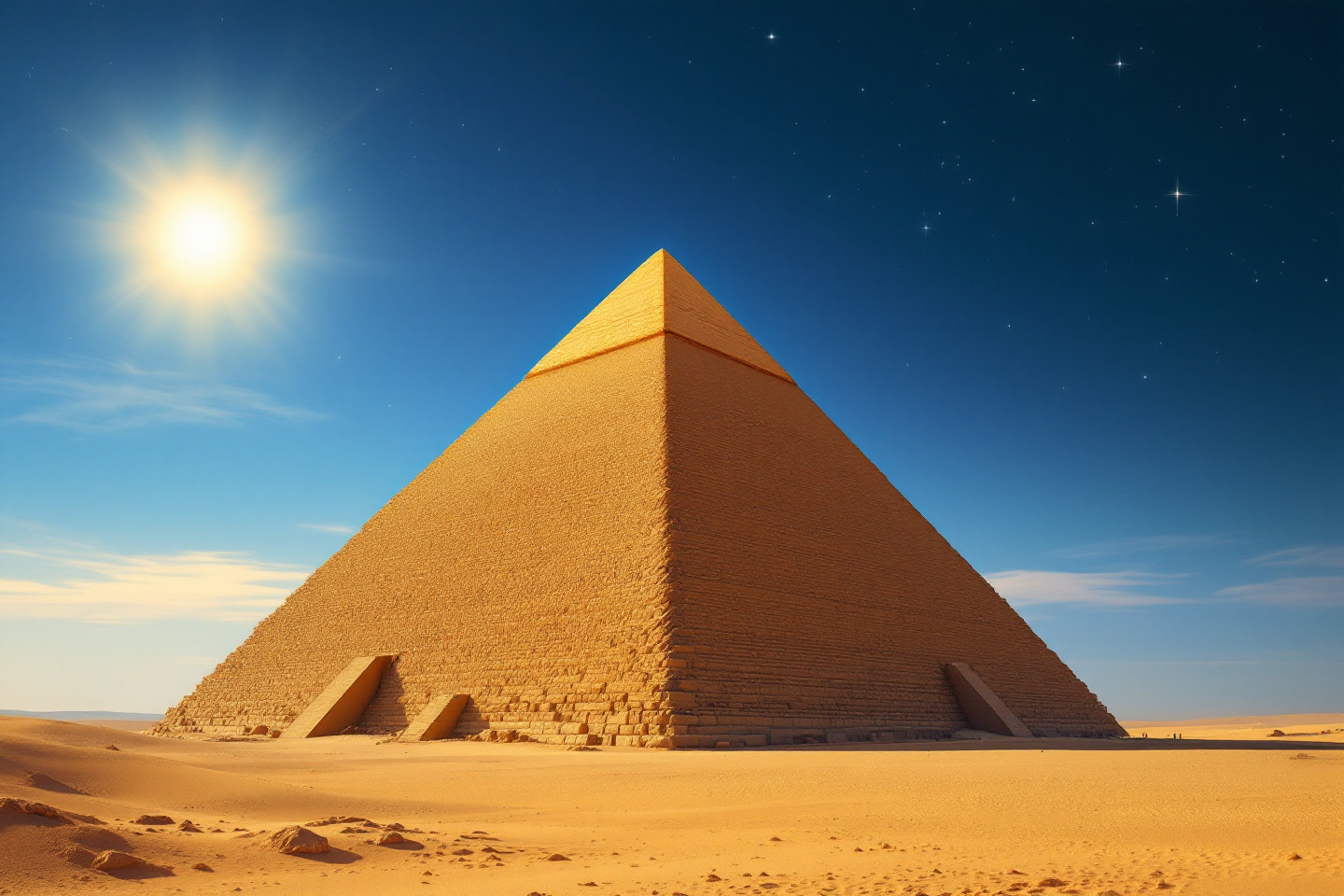
The triangle's significance extends far beyond its structural properties into the realm of metaphysics and sacred symbolism. In ancient Egypt, the triangle embodied divine principles, with the Great Pyramids serving as massive three-dimensional triangles linking earth to sky. Each face of the pyramid creates a perfect triangle, oriented to the cardinal directions with remarkable precision. This alignment wasn't merely pragmatic but cosmological—the triangular faces created a stairway for the pharaoh's soul to ascend to the circumpolar stars, considered the realm of immortality in Egyptian cosmology.
The Pythagoreans, who established one of Western civilization's first mathematical-spiritual schools, venerated the triangle as the first complete shape. Their sacred symbol, the tetraktys—a triangular arrangement of ten points—represented the perfection of number and form in a single unified image. This arrangement contained four rows (1+2+3+4=10), forming a triangle that encoded musical harmonies, cosmic ratios, and the fundamental nature of reality itself. When initiates gazed upon this triangular formation, they weren't merely seeing a geometric shape but contemplating the mathematical underpinnings of the universe.
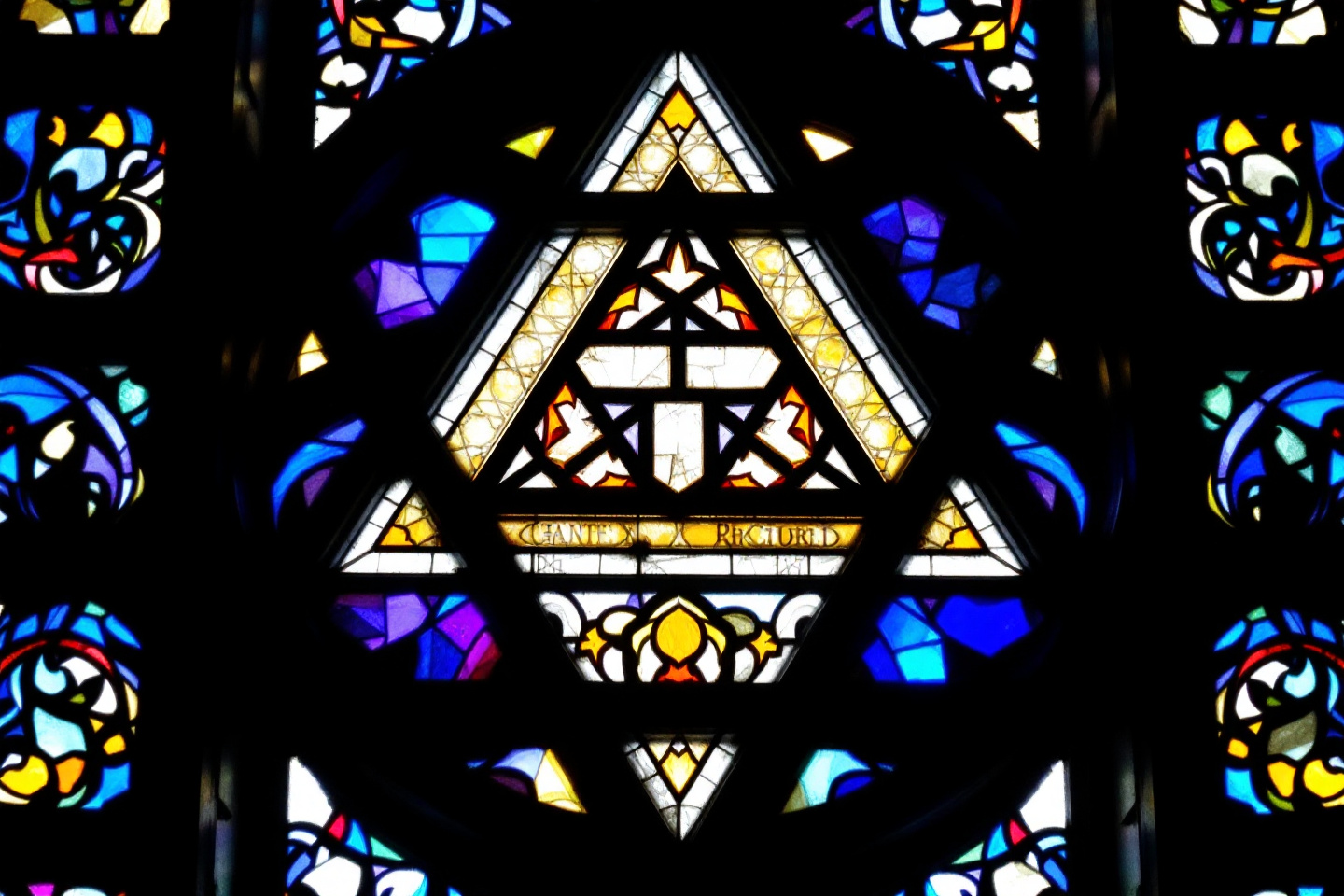
The equilateral triangle, with its three equal sides and perfect symmetry, holds particular significance in sacred traditions. This perfect equality of proportions makes it a natural symbol for trinities found throughout world religions. In Christianity, the equilateral triangle represents the Trinity—Father, Son, and Holy Spirit—three persons in one divine essence. Medieval churches and cathedrals incorporate this triangular motif throughout their architecture and artwork, reminding worshippers of this fundamental theological concept. The triangle here functions not merely as decoration but as a visual theology, teaching through geometric form.
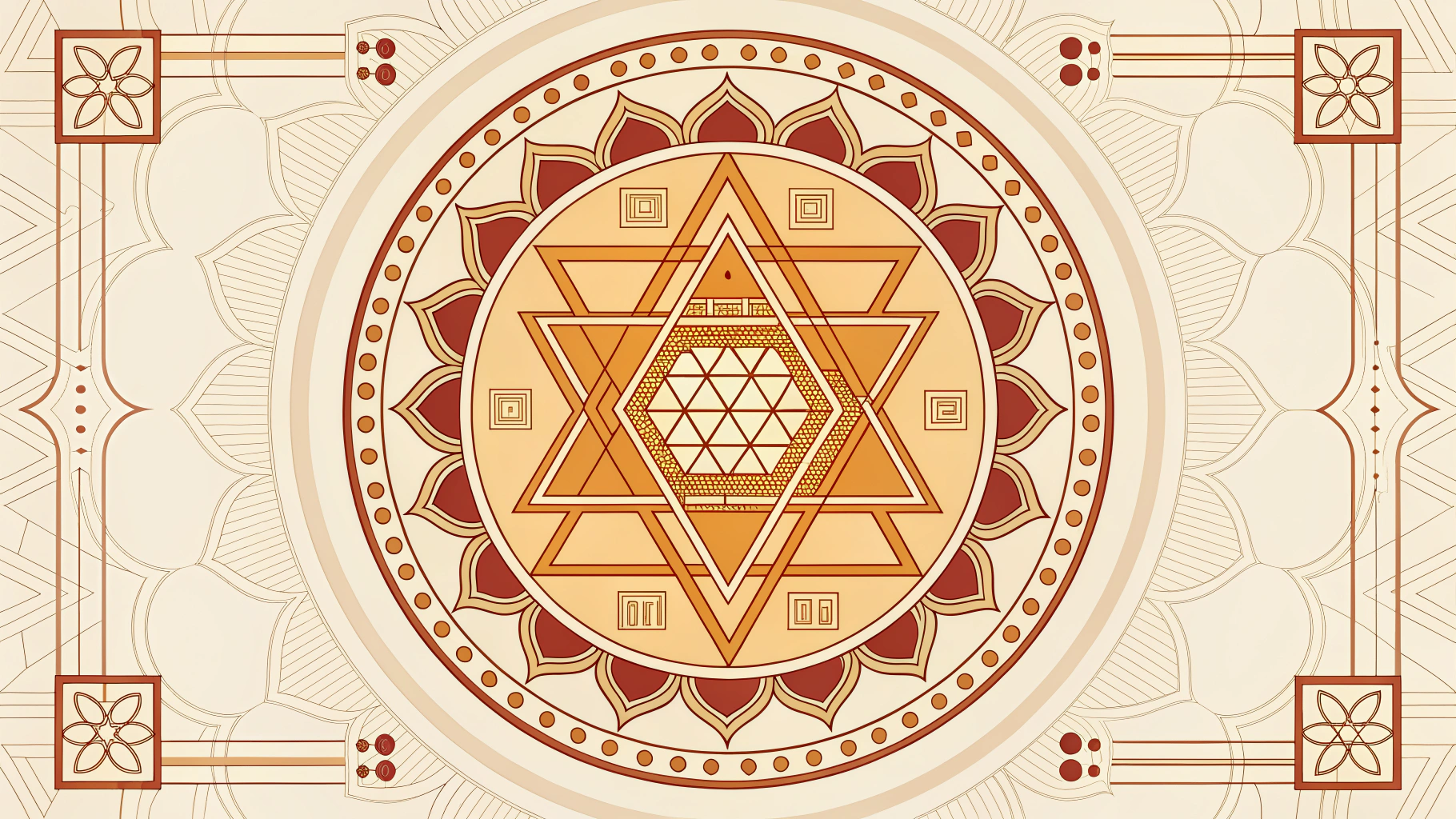
In Hindu traditions, the triangular yantra serves as a focal point for meditation practices. The downward-pointing triangle, or trikona, symbolizes feminine creative energy (Shakti), while the upward-pointing triangle represents masculine consciousness (shiva-and-shakti). When these triangles interlock to form the six-pointed star of the Sri Yantra, they represent the perfect union of these complementary cosmic forces. This sacred diagram uses triangular geometry to map the process of creation itself—from unity (the central point) to multiplicity (the expanding triangular patterns).
The orientation of the triangle carries distinct symbolic meanings. The upward-pointing triangle (▲) represents fire, masculine energy, and spiritual aspiration. Its shape mimics a flame reaching upward, suggesting transformation and transcendence. In alchemical symbols, this triangle denotes the element of fire, the active principle that catalyzes change. Fire transforms matter from one state to another, just as spiritual practice transforms consciousness. This triangular symbol reminds practitioners that transformation requires direction and purpose—energy channeled with intention toward higher states of being.
Conversely, the downward-pointing triangle (▼) symbolizes water, feminine energy, and the descent of spirit into matter. Water flows downward, seeking the lowest point, yet contains the potential for life and renewal. In many tantric traditions, this inverted triangle represents the yoni, the sacred feminine principle that receives, nurtures, and gives birth to new possibilities. The downward triangle appears in the subtle anatomy of yoga as the muladhara (root) chakra, grounding spiritual energy in physical existence. This orientation reminds us that genuine spirituality must be embodied and grounded, not merely abstract or theoretical.
When these opposing triangles merge to form the six-pointed star or hexagram, they create a powerful symbol of integration and balance found across diverse traditions. In the Jewish tradition, this becomes the Star of David (Magen David), representing divine protection and the covenant between God and humanity. In Hermeticism, this same form signifies "as above, so below"—the correspondence between macrocosm and microcosm, heaven and earth, spirit and matter.
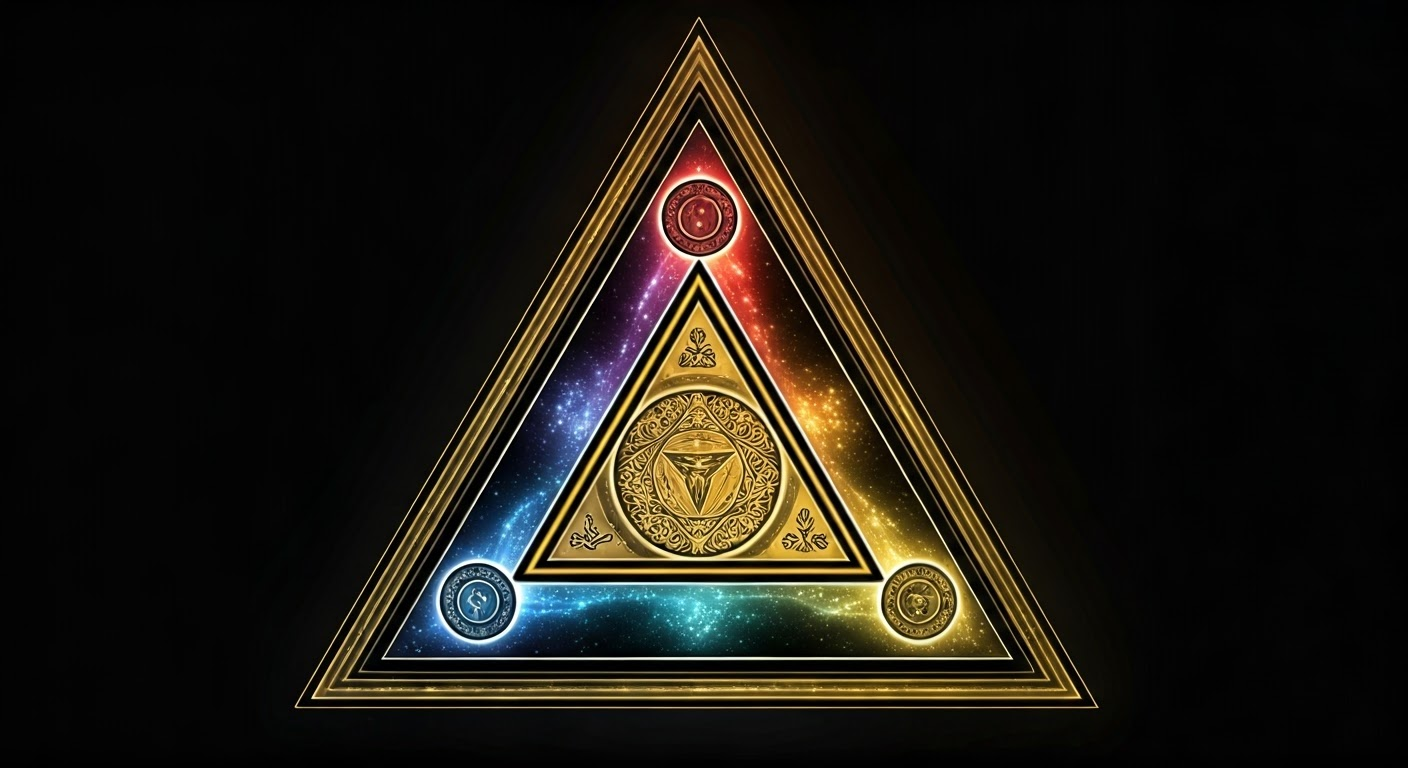
The triangle's three sides naturally lend themselves to representing tripartite concepts found throughout wisdom traditions. The three gunas in Vedic philosophy—sattva (harmony), rajas (activity), and tamas (inertia)—form the fundamental qualities that, in different combinations, constitute all existence. Similarly, in Western esoteric traditions, the triangle corresponds to the three alchemical principles—sulfur, mercury, and salt—which represent soul, spirit, and body respectively. These triangular relationships aren't merely conceptual but represent dynamic forces in constant interaction, just as the three points of a triangle maintain perfect relationship regardless of the triangle's size.
In alchemy, the triangle's three points correspond to the three primary substances: sulfur (soul), mercury (spirit), and salt (body). These principles are not just symbolic but are also seen as the essential components of all matter. Sulfur represents the active, masculine principle of transformation and vitality. Mercury, the passive, feminine principle, symbolizes fluidity and adaptability. Salt, the neutral principle, represents stability and crystallization. The alchemical process involves the purification and recombination of these elements, often visualized as a triangle within a circle, symbolizing the integration of spirit and matter.
While the three gunas—sattva, rajas, and tamas—have been mentioned, their deeper implications can be explored. Sattva, representing harmony and purity, is often associated with the upward-pointing triangle, symbolizing spiritual ascent and enlightenment. Rajas, representing activity and passion, corresponds to the dynamic energy that propels change and transformation. Tamas, representing inertia and darkness, is linked to the downward-pointing triangle, symbolizing grounding and materiality. The interplay of these gunas is not static; they are in constant flux, much like the angles and sides of a triangle that can shift while maintaining their fundamental relationship.
The triangle's three-sided structure is a powerful symbol that resonates deeply with tripartite concepts across various wisdom traditions, reflecting the universal principle of division and unity. Beyond the examples already mentioned, the triangle's triadic nature can be expanded upon in several other philosophical, spiritual, and scientific contexts, further illustrating its significance as a fundamental archetype.
In Buddhism, the triangle can be seen as a representation of the Three Jewels (Triratna): the Buddha (the enlightened one), the Dharma (the teachings), and the Sangha (the community of practitioners). These three elements form the foundation of Buddhist practice and spiritual refuge. The triangle's three sides symbolize the interdependence of these jewels—without the Buddha, there would be no Dharma; without the Dharma, there would be no Sangha; and without the Sangha, the teachings would not be preserved and propagated. This triadic relationship mirrors the triangle's inherent stability and interconnectedness.
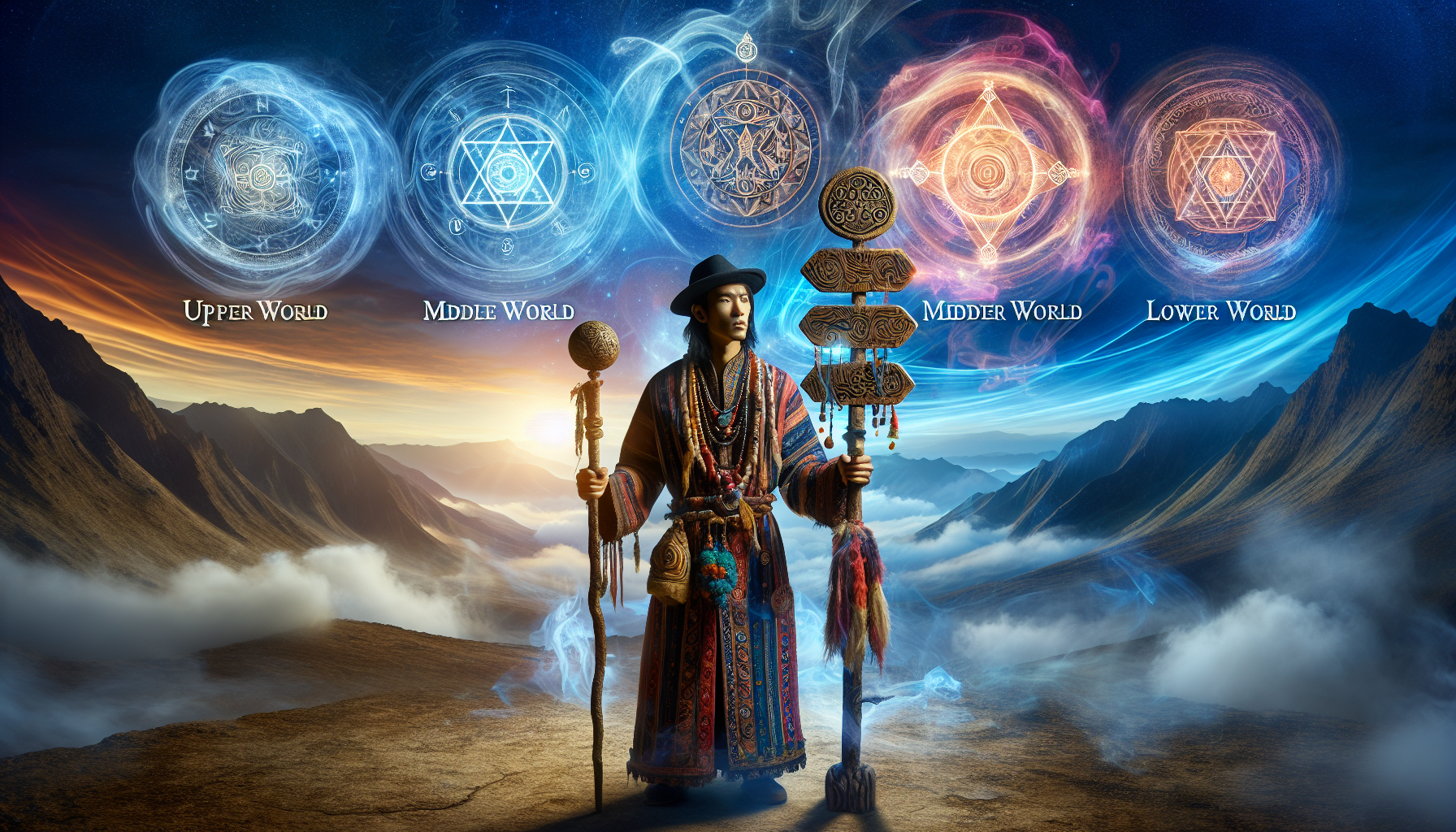
In many shamanic traditions, the triangle represents the three realms of existence: the Upper World (the realm of spirits and deities), the Middle World (the physical world of humans and nature), and the Lower World (the realm of ancestors and subconscious forces). Shamans often journey between these realms to retrieve knowledge, heal, or restore balance. The triangle serves as a map for navigating these spiritual dimensions, with each point representing a gateway to a different plane of existence. The upward-pointing triangle may symbolize ascension to the Upper World, while the downward-pointing triangle may represent descent into the Lower World.
The triangle can also represent the threefold nature of time: past, present, and future. In many traditions, time is not seen as a linear progression but as a cyclical or triadic relationship. The past influences the present, the present shapes the future, and the future, in turn, loops back to inform the past. This triadic view of time is reflected in the triangle's structure, where each point is connected to the others, creating a continuous loop of cause and effect. This concept is particularly evident in Hindu cosmology, where time is divided into cycles (yugas) that repeat in a grand cosmic rhythm.
The triangle's representation of the threefold nature of time—past, present, and future—offers a profound lens through which to explore the cyclical and interconnected nature of temporal existence. This concept is not only central to Hindu cosmology but also resonates deeply with other spiritual and philosophical traditions, as well as modern scientific thought.
In Hindu cosmology, time is not a straight line but a series of repeating cycles known as yugas. These yugas—Satya Yuga, Treta Yuga, Dvapara Yuga, and Kali Yuga—represent different epochs of human and cosmic development, each with its own characteristics and spiritual qualities. The cycle of yugas is often depicted as a wheel, but the triangle can also symbolize the triadic relationship between the past, present, and future within each yuga.
- Satya Yuga (Golden Age): This is the age of truth and purity, where humanity lives in harmony with divine principles. The past (Satya Yuga) influences the present by setting a standard of spiritual and moral excellence.
- Treta Yuga (Silver Age): In this age, virtue begins to decline, but spiritual practices and rituals still hold great power. The present (Treta Yuga) is shaped by the past, as humanity strives to maintain the wisdom of the Satya Yuga.
- Dvapara Yuga (Bronze Age): This age sees further decline in virtue and the rise of materialism. The future (Dvapara Yuga) is influenced by the present, as humanity begins to lose touch with the spiritual truths of earlier ages.
- Kali Yuga (Iron Age): The current age, marked by conflict, ignorance, and moral decay. Yet, even in this age, the seeds of the future are sown, as the cycle eventually returns to the Satya Yuga, completing the cosmic rhythm.
The triangle, with its three points, can be seen as a microcosm of this larger cycle, representing the interplay of past, present, and future within each yuga. Each point of the triangle influences the others, creating a dynamic flow of time that is both cyclical and interconnected.
The concept of eternal return, found in many traditions, suggests that time is not linear but cyclical, with events recurring in an endless loop. This idea is particularly prominent in Nietzschean philosophy, where the eternal return is seen as a test of one's ability to affirm life in all its aspects. The triangle, with its three points, can symbolize this eternal return, where the past, present, and future are not separate but part of a continuous, repeating cycle.
- Past: The past is not something that is gone forever but a living force that continues to influence the present. In the triangle, the past is one point, constantly feeding into the present.
- Present: The present is the point where past and future meet. It is the moment of action, where decisions are made that will shape the future. The present is the fulcrum of the triangle, balancing the influences of the past and the potential of the future.
- Future: The future is not a distant, unknown realm but a direct consequence of the present. In the triangle, the future is the third point, looping back to inform the past, creating a continuous cycle of cause and effect.
This triadic view of time challenges the linear perspective that dominates modern thought, suggesting instead that time is a spiral, where each cycle brings new opportunities for growth and transformation.
Many indigenous cultures also view time as cyclical rather than linear. For example, in Native American traditions, time is often seen as a circle or spiral, with the past, present, and future interconnected. The triangle can be seen as a simplified representation of this spiral, with each point representing a different phase of the cycle.
- Past: The past is the foundation, the wisdom of the ancestors that guides the present. In the triangle, the past is the base, providing stability and continuity.
- Present: The present is the moment of action, where the lessons of the past are applied to create the future. The present is the apex of the triangle, the point of transformation.
- Future: The future is the result of the present, but it also loops back to inform the past, creating a continuous cycle of renewal. In the triangle, the future is the third point, completing the cycle.
This cyclical view of time is often reflected in rituals and ceremonies, where the past, present, and future are honored and integrated. For example, in vision quests or sun dances, participants connect with the wisdom of the past, act in the present to seek guidance, and envision a future that is in harmony with the natural world.
Even in modern physics, the concept of time as a cyclical or triadic phenomenon finds resonance. In uantum mechanics, time is not always linear; particles can exist in multiple states simultaneously, and events can influence each other in non-linear ways. The triangle can be seen as a metaphor for this complex interplay of past, present, and future in the quantum realm.
- Past: In quantum physics, the past is not fixed but can be influenced by future events, a phenomenon known as retrocausality. The past is one point of the triangle, constantly interacting with the present and future.
- Present: The present is the moment of observation, where the quantum wave function collapses into a definite state. The present is the apex of the triangle, the point where potential becomes actual.
- Future: The future is not predetermined but is shaped by the present. In the triangle, the future is the third point, looping back to influence the past, creating a dynamic, interconnected web of cause and effect.
This triadic view of time challenges the classical, linear understanding of cause and effect, suggesting instead that time is a more fluid, interconnected phenomenon.
On a personal level, the triangle's representation of past, present, and future can be a powerful tool for self-reflection and growth. By understanding how the past influences the present, and how the present shapes the future, individuals can take conscious steps to break negative cycles and create positive change.
- Past: The past is a source of lessons and wisdom. By reflecting on past experiences, individuals can gain insight into their patterns and behaviors. In the triangle, the past is the foundation, providing the knowledge needed to navigate the present.
- Present: The present is the moment of action, where individuals have the power to make choices that will shape their future. The present is the apex of the triangle, the point of transformation and growth.
- Future: The future is not fixed but is shaped by the choices made in the present. By envisioning a positive future, individuals can create a vision that guides their actions in the present. In the triangle, the future is the third point, completing the cycle and providing direction.
This triadic view of time encourages individuals to take responsibility for their actions, recognizing that the present is the point where past and future meet, and where true transformation occurs.
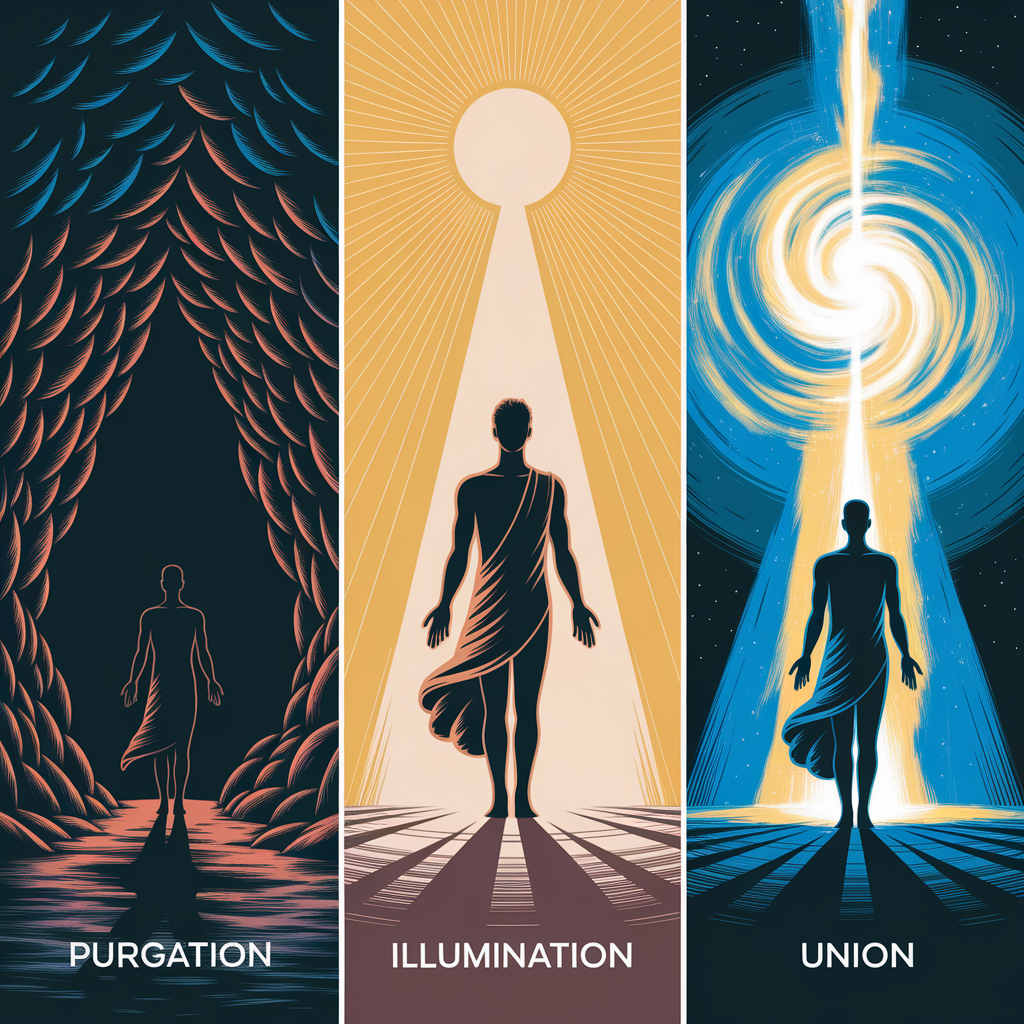
In many spiritual traditions, the path to enlightenment or self-realization is often described as a threefold process. For example, in the Christian mystical tradition, this path is often divided into three stages: purgation (cleansing of the soul), illumination (receiving divine light), and union (merging with the divine). The triangle's three sides can be seen as representing these stages, with each side leading to the next in a continuous cycle of spiritual growth. Similarly, in Sufism, the path to God is often described as a journey through three stages: Sharia (law), Tariqa (path), and Haqiqa (truth). The triangle serves as a visual reminder of the progressive nature of spiritual development.
In psychology, particularly in the work of Carl Jung, the triangle can represent the threefold structure of the psyche: the conscious mind, the personal unconscious, and the collective unconscious. The conscious mind is the tip of the triangle, representing our immediate awareness. The personal unconscious lies just below, containing repressed memories and personal experiences. The collective unconscious, at the base, represents the shared, archetypal experiences of humanity. The triangle's structure illustrates how these layers of the mind are interconnected, with the collective unconscious providing the foundation for the personal unconscious and conscious mind.
The triangle's three sides are a profound symbol of the triadic nature of existence, reflecting the universal principle of division and unity. Whether in the realms of spirituality, philosophy, psychology, or science, the triangle serves as a reminder that reality is often structured in threes, with each element influencing and being influenced by the others. This triadic structure is not just a conceptual framework but a dynamic, living reality that underpins the fabric of existence. By contemplating the triangle, we gain insight into the deeper patterns that govern both the material and spiritual worlds, recognizing that harmony and balance are achieved through the interplay of complementary forces.
In sacred architecture, triangular forms create spaces that direct energy and attention. The pitched roofs of churches, temples, and sacred buildings worldwide use triangular structures not merely for practical purposes like shedding rain but for energetic and symbolic reasons. These upward-sloping planes guide the eye and spirit upward, creating what architectural theorists call "aspiring space"—environments that physically embody spiritual aspiration. This architectural application of triangular principles demonstrates how sacred geometry creates not just visual symbols but experiential realities that transform human consciousness through spatial relationships.
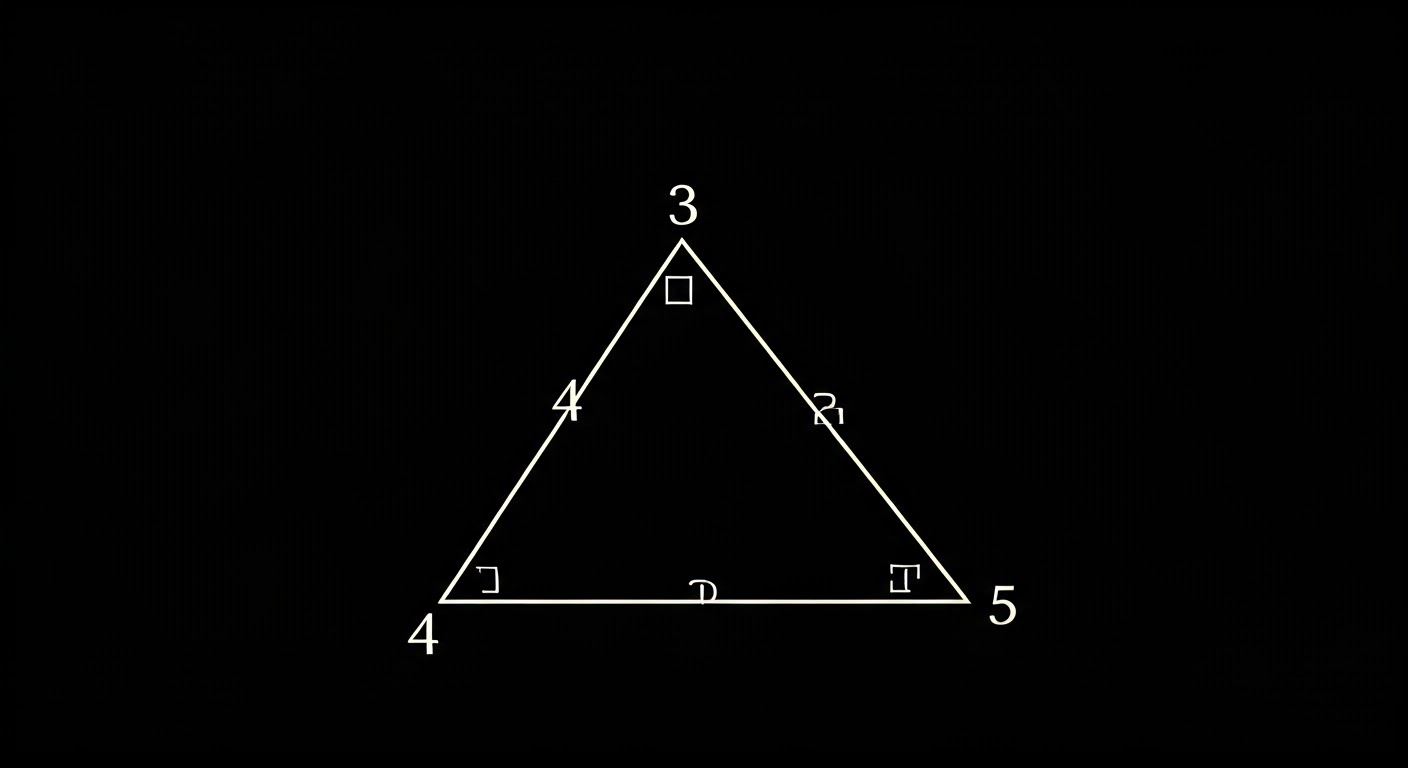
The 47th Proposition of Euclid, better known as the Pythagorean theorem, reveals another profound aspect of triangular wisdom. This mathematical principle—that in a right triangle, the square of the hypotenuse equals the sum of the squares of the other two sides—became a central symbol in Freemasonry and other Western mystery traditions. Beyond its mathematical utility, this particular triangular relationship represented the harmonious balance of opposing forces and the emergence of a third principle from their interaction. The 3-4-5 triangle, the simplest whole-number expression of this theorem, was used by ancient builders to create perfect right angles without modern measuring tools, demonstrating how abstract mathematical principles could manifest in practical craftsmanship.
The triangle also serves as an organizing principle for understanding degrees of manifestation. Numerous spiritual systems describe reality as existing on three fundamental planes—spiritual, psychic/mental, and physical. These aren't separate realms but rather different densities or frequencies of the same underlying reality, just as the three points of a triangle define a single unified shape. This triangular model helps practitioners understand how energy descends from subtler to denser forms and how consciousness can ascend through these levels through spiritual practice. The triangle thus becomes not just a symbol but a map for navigating multiple dimensions of existence.
In Sacred Geometry, the triangle generates other key forms through its movement and replication. When an equilateral triangle rotates around its center point, it creates a circle, demonstrating how straight lines can generate curved forms through dynamic motion. This principle reflects spiritual teachings about how the diversity of manifestation emerges from the rotation of fundamental patterns. Similarly, when triangles tessellate (repeat without gaps), they create honeycomb-like hexagonal patterns found throughout nature, from beehives to the molecular structure of crystals, revealing how simple forms create complex systems through repetition and relationship.
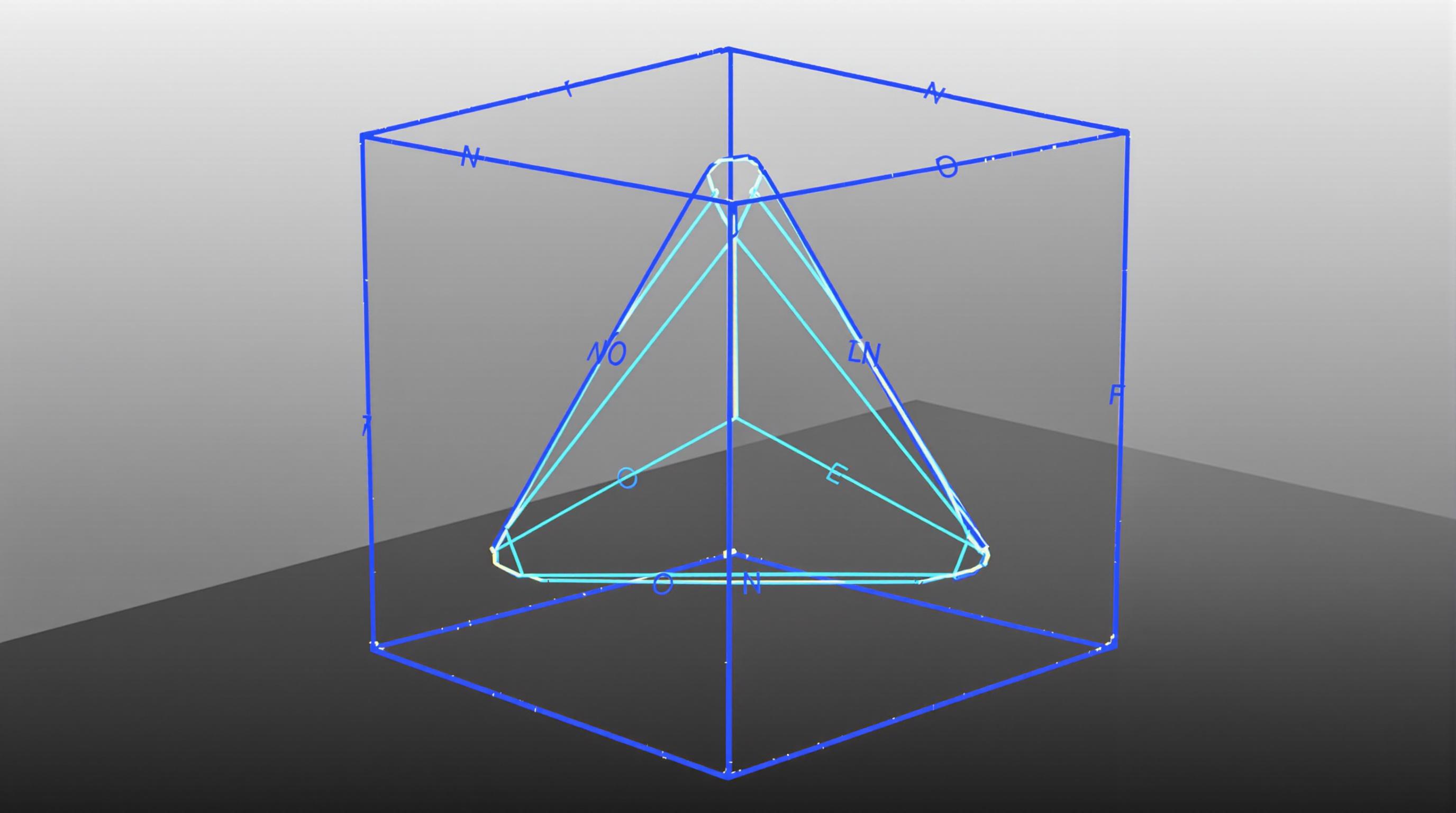
The tetrahedron—a three-dimensional triangle with four triangular faces—represents the simplest possible volume in three-dimensional space. This form corresponds to the element of fire in Platonic solid associations and represents the spark of consciousness that animates matter. Unlike other volumetric forms, the tetrahedron maintains perfect triangular symmetry when viewed from any of its vertices, embodying the principle that fundamental truths remain consistent regardless of perspective. Interestingly, the tetrahedron fits perfectly inside a cube when its vertices touch the centers of the cube's faces, demonstrating how seemingly different geometric archetypes relate through hidden harmonies.
The profound mathematical properties of triangles reveal deeper metaphysical principles. Consider the fact that the sum of angles in any triangle always equals 180 degrees, or a semicircle. This constant relationship holds true regardless of the triangle's shape or size, suggesting an underlying order that transcends specific manifestations. Similarly, triangulation—the process of determining an unknown position by measuring angles from known points—serves as both a practical surveying technique and a metaphor for spiritual discernment. By establishing clear reference points and understanding their relationships, we can locate ourselves in both physical and metaphysical landscapes.
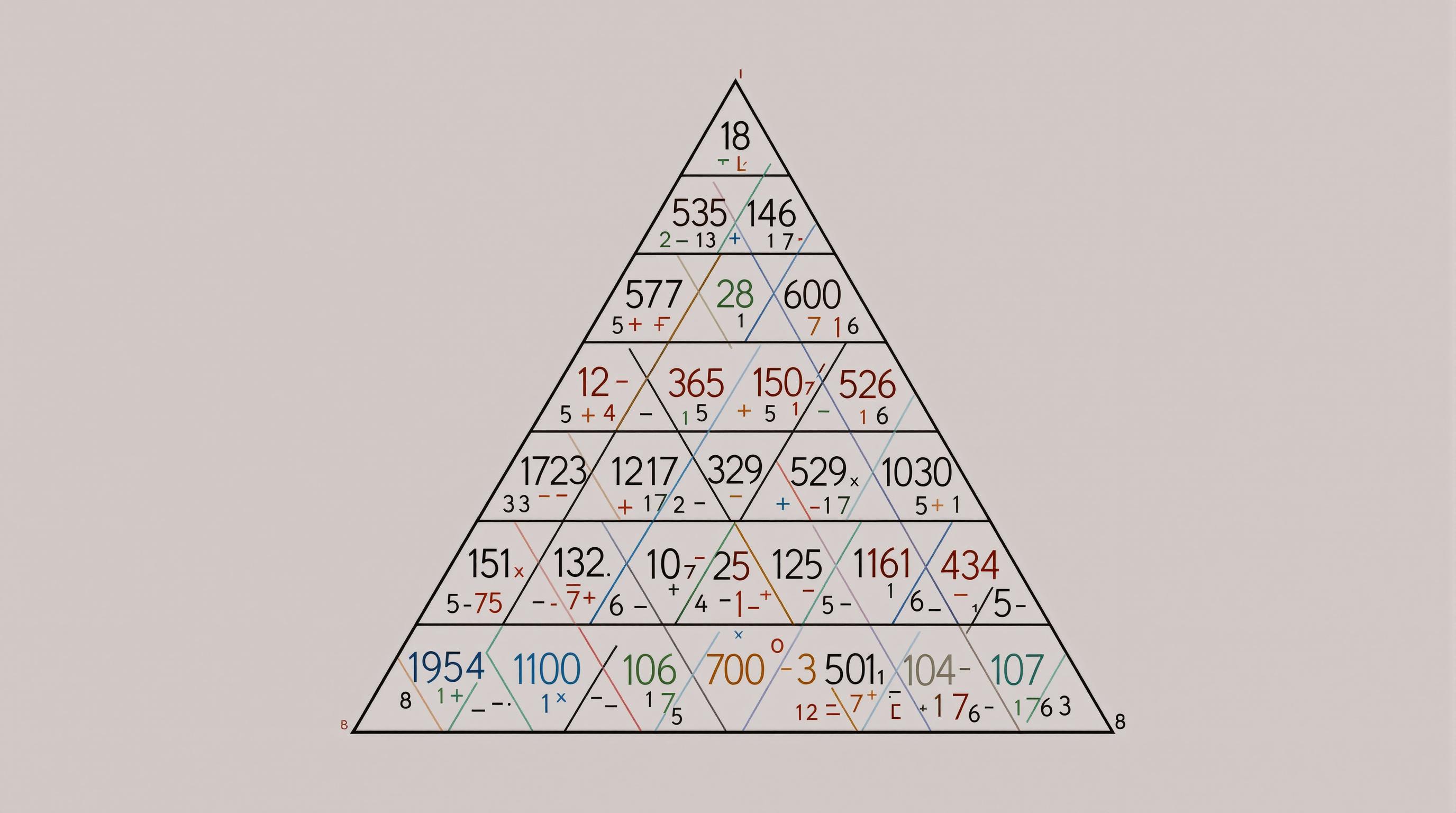
Pascal's Triangle, a triangular array of binomial coefficients where each number equals the sum of the two numbers above it, reveals the mathematical beauty of triangular patterns. This seemingly simple arrangement contains profound numerical relationships, including the Fibonacci sequence, power series, and combinatorial possibilities. The triangle reveals how new possibilities emerge from the relationship between preceding elements, mirroring how creation unfolds through the interaction of existing patterns. This mathematical triangle has been known in various forms across diverse cultures, from ancient China to medieval Persia, suggesting an archetypal quality to its revelatory structure.
In esoteric Christianity, the triangle symbolizes not only the Trinity but also the threefold nature of human existence—body, soul, and spirit. The triangle thus creates a correspondence between divine and human nature, suggesting that humanity is created "in the image" of divinity through this tripartite structure. Christian contemplatives used triangular diagrams to map the soul's journey toward union with God, with each side representing a distinct phase of spiritual development—purgation, illumination, and union. This geometric mapping of spiritual transformation demonstrates how sacred geometry provides not just symbols but practical frameworks for understanding the evolution of consciousness.
The triangle's significance extends into practical tools for spiritual practice. The triangular pendulum, suspended from a single point, creates a perfect vertical line due to gravity's pull, enabling builders to establish true vertical alignment when constructing sacred spaces. This practical application carries symbolic significance—the triangle-based plumb line represents the soul's natural tendency to seek alignment with higher principles. Similarly, triangular musical instruments like the stringed psaltery create harmonic resonances based on triangular proportions, demonstrating how geometric forms translate into audible harmonies that affect consciousness through sound.
In dream symbolism and visionary experiences, triangular forms often appear during periods of spiritual transformation. Carl Jung noted the emergence of triangular imagery in his patients' dreams during processes of psychological integration, particularly when the conscious mind was reconciling with previously unconscious material. The triangle in these contexts represents the transcendent function—the third element that emerges when opposing aspects of the psyche integrate. This psychological triangle mirrors the spiritual principle that growth often requires the reconciliation of apparent opposites to generate a higher synthesis.
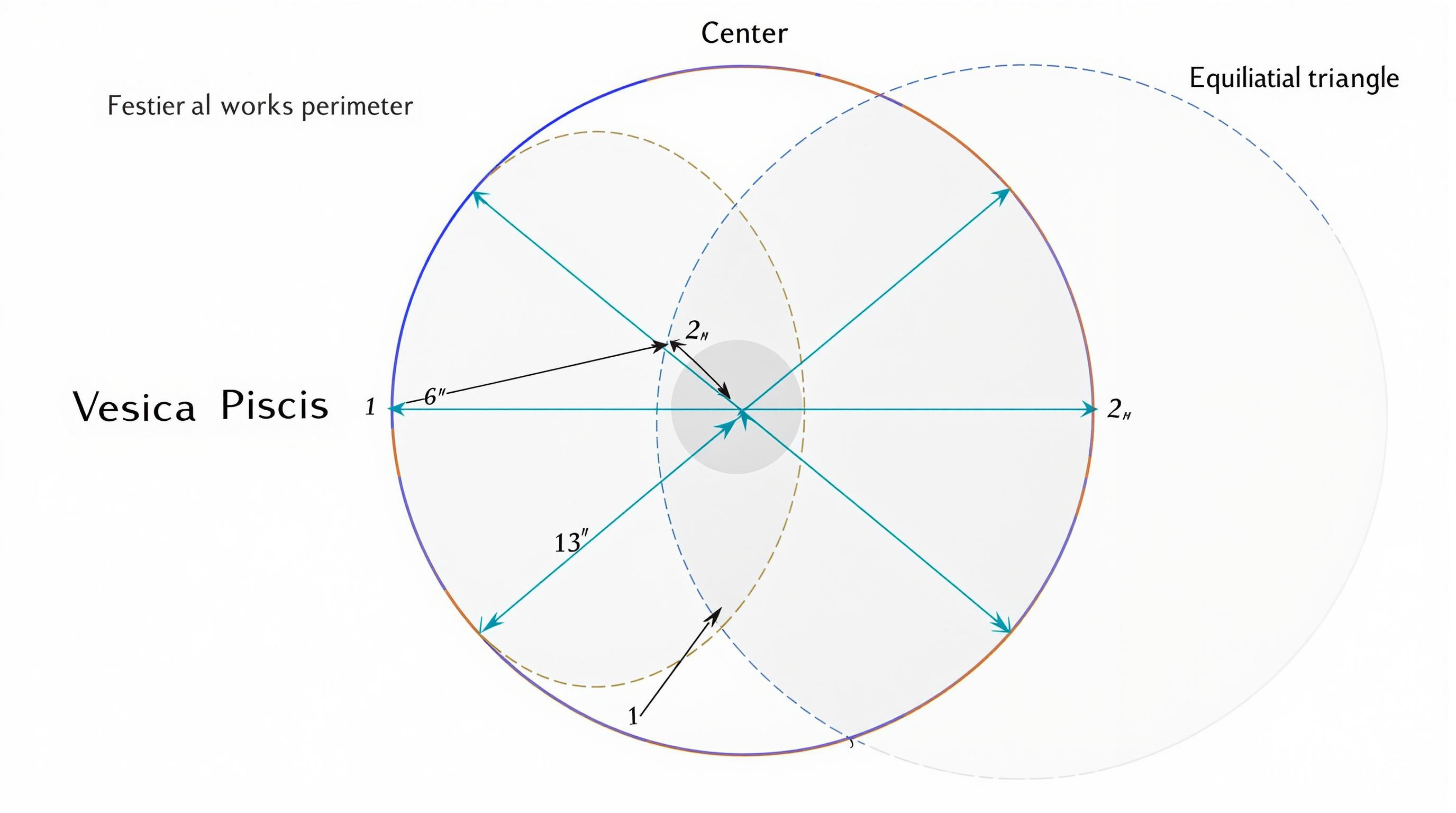
The Vesica Piscis—the almond-shaped intersection created when two circles of the same radius overlap so that the center of each circle lies on the circumference of the other—generates important triangular relationships. When lines are drawn connecting the two circle centers to any point on the Vesica's perimeter, a perfect equilateral triangle results. This geometric fact reveals how the triangle emerges naturally from the relationship between dualities, represented by the two circles. The Vesica Piscis appears prominently in sacred art as the aureole surrounding Christ and saints in Christian iconography, with its hidden triangular properties suggesting divine proportion and harmony.
In Kabbalistic teachings, the triangle relates to the three "pillars" of the Tree of Life—severity on the left, mercy on the right, and balance in the center. These three columns organize the ten sephiroth (divine emanations) into a cohesive system that maps the process of creation from divine unity to material manifestation. The triangular relationships between individual sephiroth create pathways for consciousness to move between different levels of reality. Kabbalistic meditation often involves visualizing these triangular relationships to activate corresponding aspects of consciousness, demonstrating how triangular geometry functions as a technology for spiritual development.
The triangle also represents stages of alchemical transformation. The alchemical axiom "solve et coagula" (dissolve and coagulate) describes a process that requires a third element—the container or vessel in which transformation occurs. This creates an alchemical triangle of active agent, receptive substance, and containing vessel that parallels many creation myths involving creator, created, and the space of creation. The triangle thus maps not just static relationships but dynamic processes of transformation that apply to matter, consciousness, and spirit alike.
As we contemplate the triangle in sacred geometry, we discover that its significance goes far beyond its mathematical properties. The triangle embodies the principle of stable relationship—the minimum number of points (three) needed to define a plane in space. It represents completion through the reconciliation of dualities, with the third point transcending and including the apparent opposition of the first two. It demonstrates how simplicity generates complexity through movement, repetition, and relationship. And perhaps most importantly, it reminds us that stability—whether in physical structures, philosophical systems, or spiritual development—requires at least three points of reference in proper relationship.
The triangle invites us to consider what trinities exist in our own experience—body-mind-spirit, thought-feeling-action, past-present-future—and how these tripartite relationships create the stable foundation for our ongoing growth and unfoldment. As we integrate this triangular wisdom, we develop a more nuanced understanding of both the physical and metaphysical dimensions of reality, recognizing how three-fold patterns create harmony, stability, and evolutionary potential at every level of existence.
In ancient Egypt, the triangle embodied the primordial mound that emerged from the waters of chaos at creation's beginning. This concept manifested physically in the Great Pyramids, whose triangular sides created pathways between earthly and divine realms. Egyptian priests understood that the triangular form concentrated cosmic energies in specific ways, amplifying consciousness beyond ordinary human perception. The precise angles of the Great Pyramid at Giza—51 degrees, 51 minutes, and 14 seconds—were calculated to align with stellar configurations and optimize the flow of universal life force.

In Hermetic philosophy, the triangle embodies the principle "as above, so below" - the microcosm reflecting the macrocosm. When upward and downward-pointing triangles overlap to form the hexagram (the Seal of Solomon or Star of David), they create a perfect balance between opposing forces, visually representing cosmic harmony. Hermetic practitioners meditated upon these triangular formations to internalize teachings about cosmic equilibrium, using visualization to align their personal energetic systems with these universal patterns.
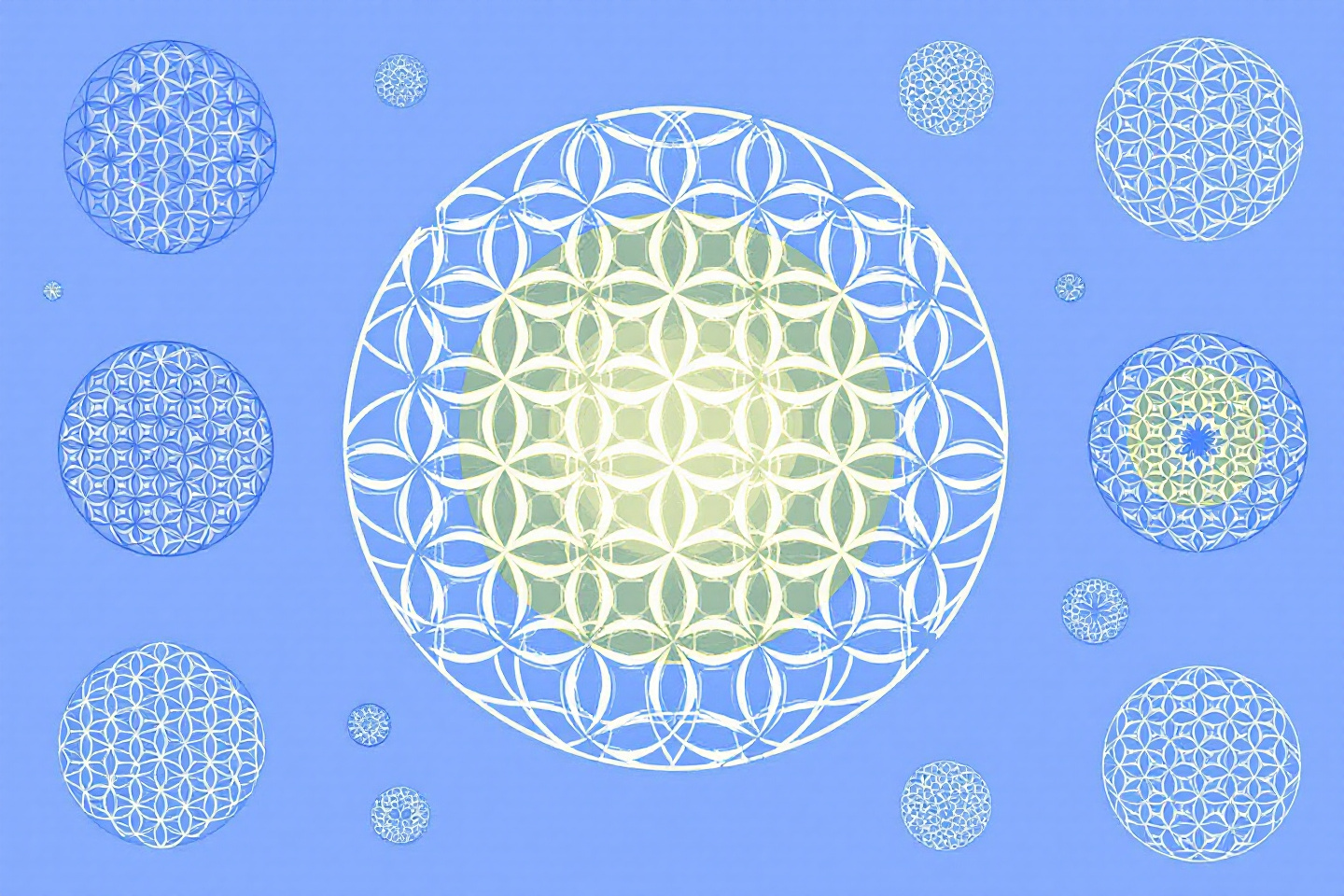
The triangle appears prominently in sacred geometry as the foundation of the Flower of Life pattern. This arrangement begins with a single circle, around which six identical circles are placed with their centers on the original circle's circumference. This creates multiple overlapping triangles representing the interconnectedness of all creation. The Flower of Life appears in ancient sites worldwide, suggesting universal recognition of the triangle's fundamental significance. Sacred geometers understood that these triangular relationships encoded vibrational patterns resonating with reality's structure. By reproducing these patterns in art, architecture, and ritual objects, they created harmonic environments facilitating spiritual awareness and healing.
In Kabbalistic tradition, the triangular structure of the Tree of Life maps divine energy's emanations into the material world. The ten Sephiroth (divine attributes) are arranged in three columns, forming multiple triangular relationships representing different aspects of divine manifestation. The uppermost triangle, comprising the first three Sephiroth, represents the highest level of divine emanation. Kabbalistic meditation involves traversing these triangular pathways in visualization, allowing practitioners to attune their consciousness to specific divine qualities. The three supernal Sephiroth—Kether, Chokmah, and Binah—form the Supernal Triangle, representing divine consciousness beyond ordinary human comprehension. Below this, two additional triangles form: the Ethical Triangle (Chesed, Geburah, and Tiphareth) and the Astral or Psychological Triangle (Netzach, Hod, and Yesod), each encoding specific spiritual lessons and evolutionary challenges.
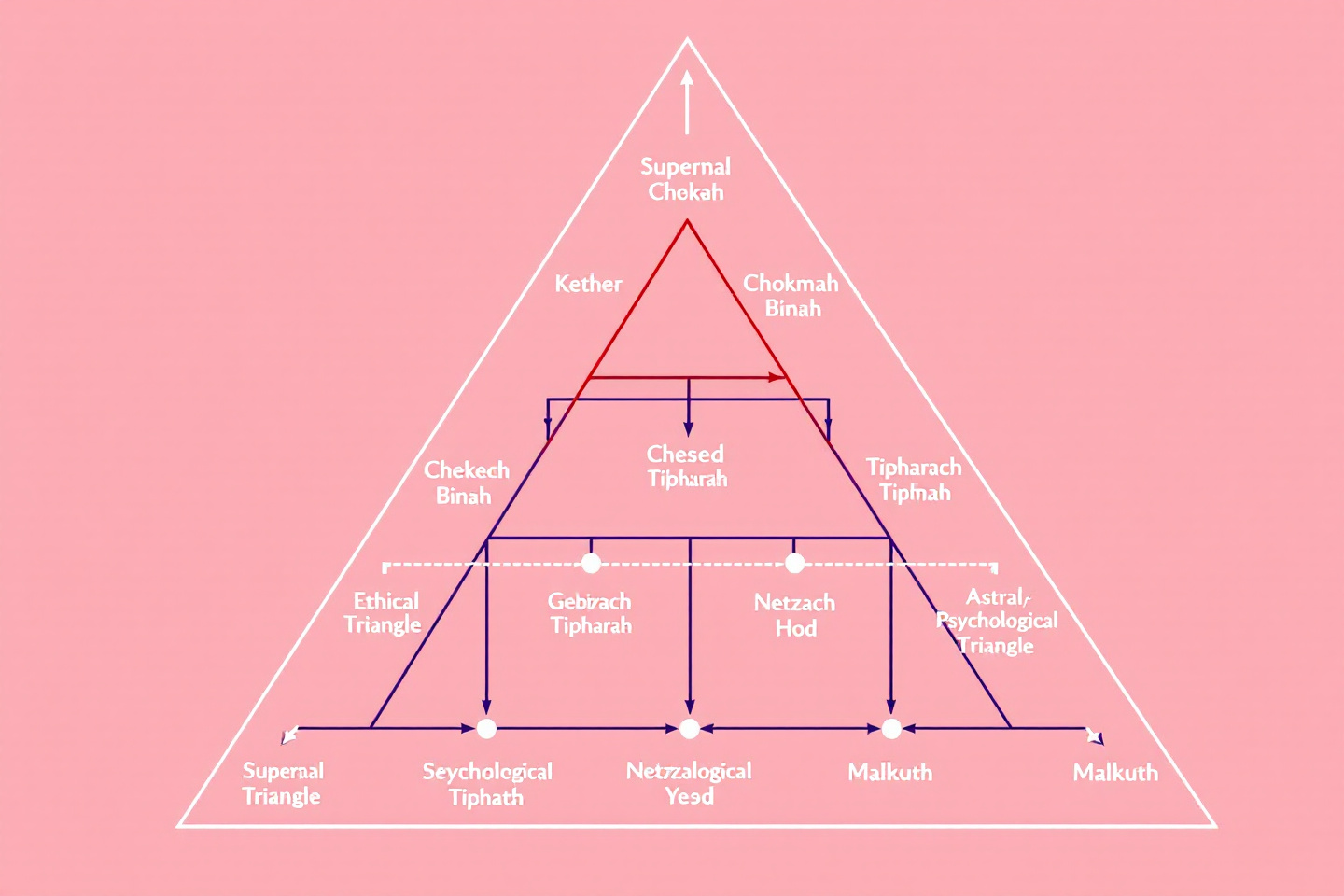
Esoteric traditions have long employed the triangle in ritual contexts. Ceremonial magicians use triangles of manifestation to contain and control summoned energies. The triangle serves as a focusing lens for magical intent, its three points creating boundaries that both contain power and direct it toward specific purposes. Practitioners often place the triangle within a protective circle, creating a safe space for interaction with otherworldly forces. The triangle's sharp angles are thought to create energetic "cutting points" that pierce through veils separating ordinary reality from subtler dimensions, allowing controlled interaction with these realms.
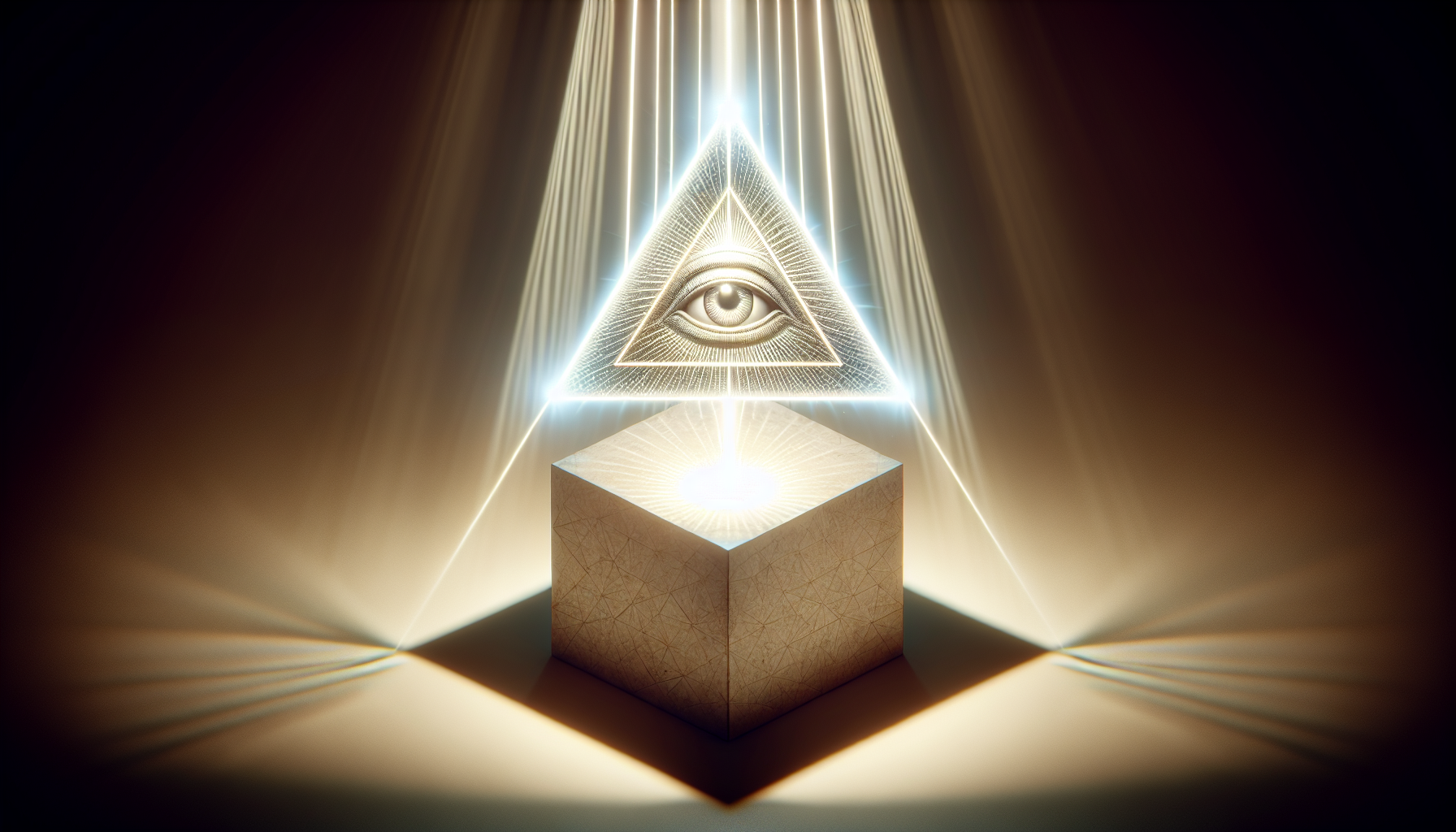
In Freemasonic symbolism, the triangle often contains the all-seeing eye, representing divine providence and the Great Architect of the Universe watching over human affairs. This symbol, which later appeared on the Great Seal of the United States, connects divine awareness with triangular structure, suggesting spiritual insight requires balanced integration of multiple perspectives. Masonic traditions teach that the triangle represents the triad of thought, feeling, and action necessary for balanced human development. The triangle surmounting a square or cube represents divine consciousness overseeing material existence, reminding initiates of the spiritual dimension infusing all worldly activities.
In tantric traditions, the downward-pointing triangle represents the yoni, the feminine creative power at the spine's base. Through meditation, practitioners seek to raise this energy through the chakras toward union with masculine consciousness at the crown, creating a spiritual energy circuit that transforms consciousness. In Tibetan Buddhist tantra, triangular visualizations assist practitioners in transforming ordinary perception into divine vision. The triangle (trigug in Tibetan) represents the three doors of liberation: emptiness, signlessness, and wishlessness. By meditating on triangular forms, practitioners gradually release attachment to conventional reality and cultivate direct perception of phenomena's ultimate nature.
The triangle manifests in numerous divinatory systems. In astrology, the trine aspect (planets 120 degrees apart) represents harmony and flow between planetary energies, forming equilateral triangles in the horoscope chart. The grand trine—three planets positioned at an equilateral triangle's vertices—indicates natural talents and harmonious expression across three areas of life. Advanced astrological practice involves analyzing multiple triangular relationships within birth charts, revealing hidden energy flow patterns and potential development paths. In the I Ching, the eight trigrams consist of three lines each, representing various yin and yang energy combinations describing existence's fundamental patterns.
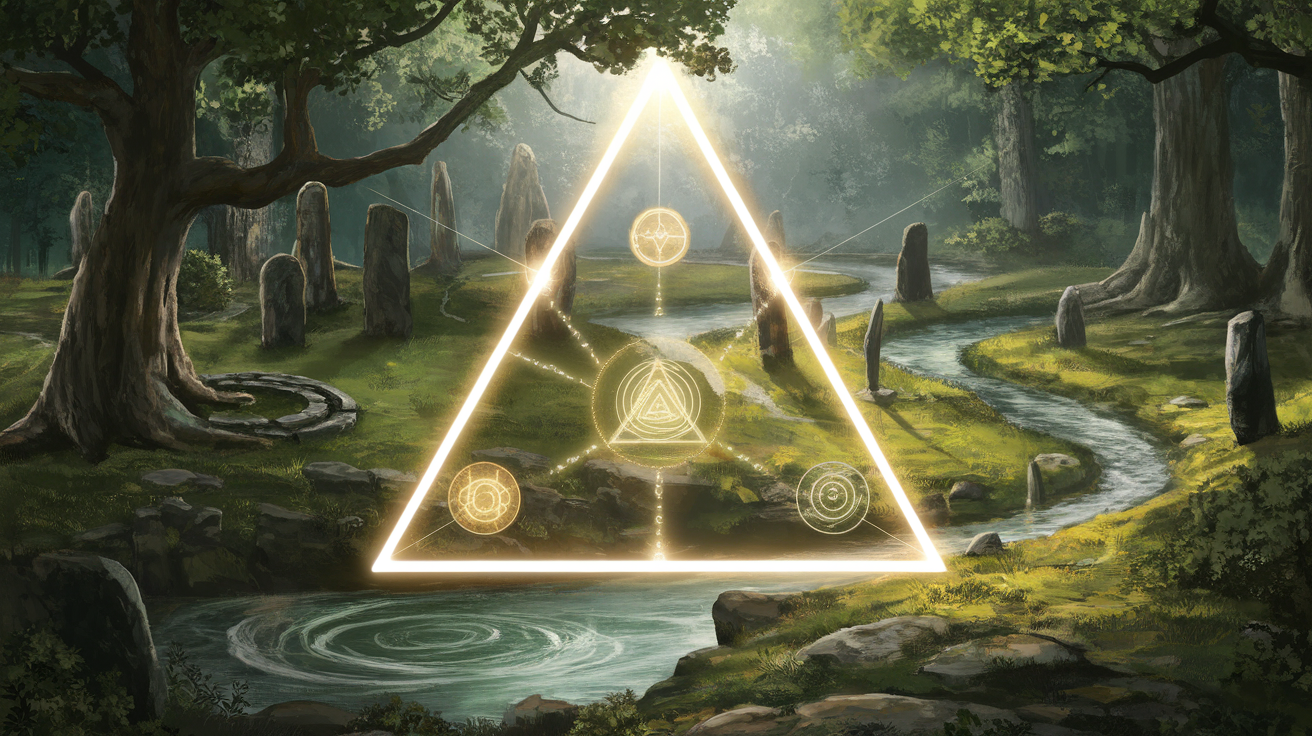
The triangle's occult significance extends to geomantic systems worldwide. Ancient cultures recognized that triangular arrangements of sacred sites created energetic networks across landscapes. In Chinese feng shui, practitioners analyze triangular relationships between landforms to assess energy flow and balance. European geomancers identified triangular connections between megalithic sites, churches, and natural features that amplified Earth energies and created harmonious environments. Modern Earth mysteries practitioners continue discovering and working with these triangular alignments, finding they often correspond to ley lines and other subtle energy currents. These triangular networks serve as focal points for ceremonies intended to heal and balance planetary energies, with practitioners often physically tracing these triangular paths as pilgrimage and attunement forms.
The triangle's appearance in visionary and psychedelic experiences across cultures throughout history suggests connection to fundamental consciousness patterns. Reports from ayahuasca ceremonies, DMT experiences, and deep meditative states describe encounters with intelligent, geometric entities communicating through triangular patterns and structures. These accounts raise questions about the relationship between geometric forms and consciousness—perhaps the triangle represents not merely a human symbolic construction but an actual structural component of reality becoming perceptible in altered states. The repeated appearance of triangular forms in visionary experiences of individuals from diverse cultural backgrounds with no prior exposure to esoteric teachings suggests these forms may be intrinsic to consciousness architecture itself.
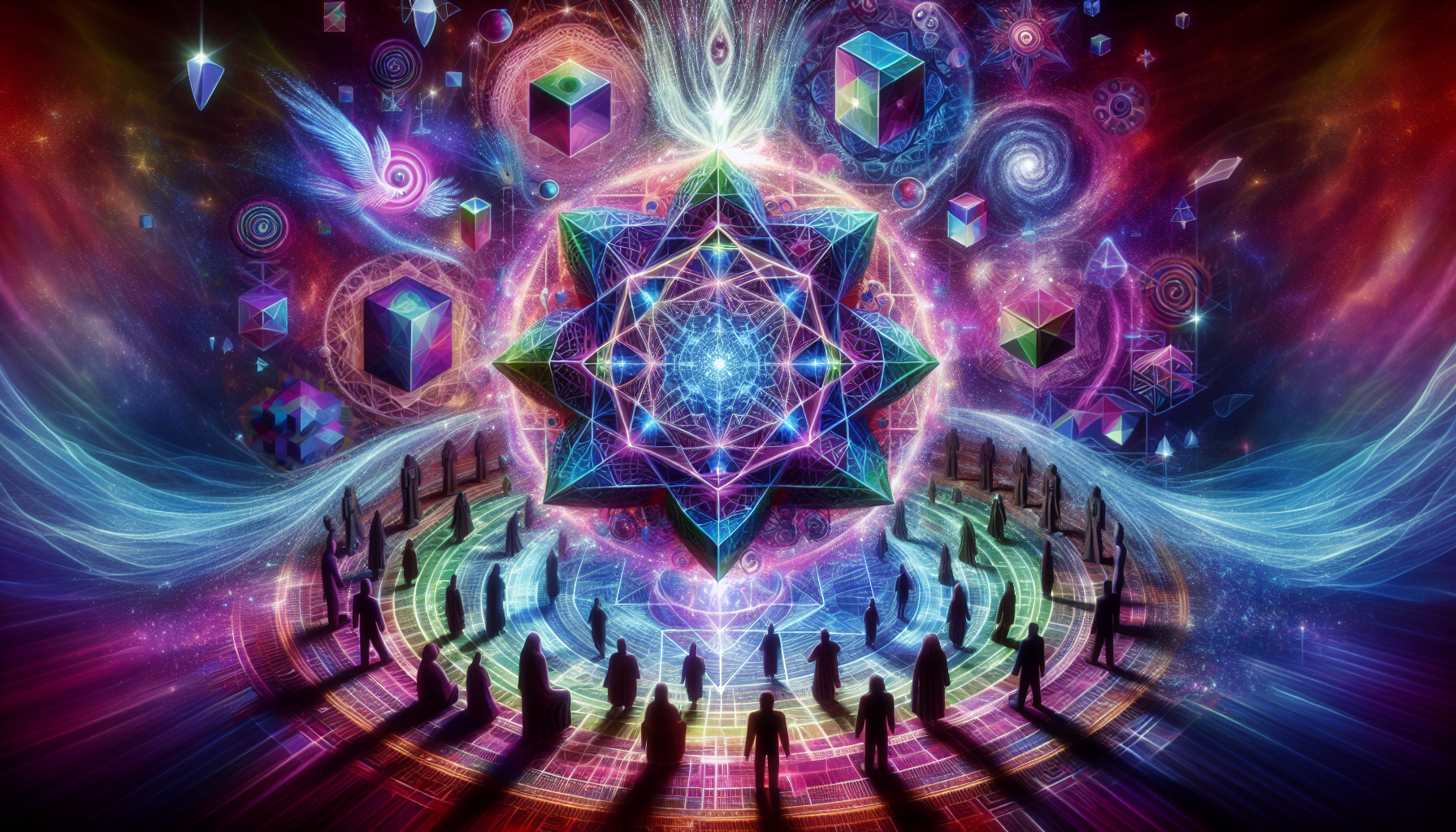
The triangle's appearance in crop formations worldwide adds another layer to its metaphysical significance. Complex geometric patterns incorporating multiple triangular elements have mysteriously appeared in fields across the globe, often near ancient sacred sites. Regardless of origins, these formations have measurable consciousness effects, with many visitors reporting altered states, healing experiences, and enhanced intuitive abilities within them. The triangular components seem to function as energy accumulators and transmitters, creating coherence fields affecting both biological systems and consciousness. Researchers have documented unusual electromagnetic readings, cellular plant changes, and crystalline soil sample alterations from these triangular formations, suggesting interaction with currently unrecognized energetic forces.
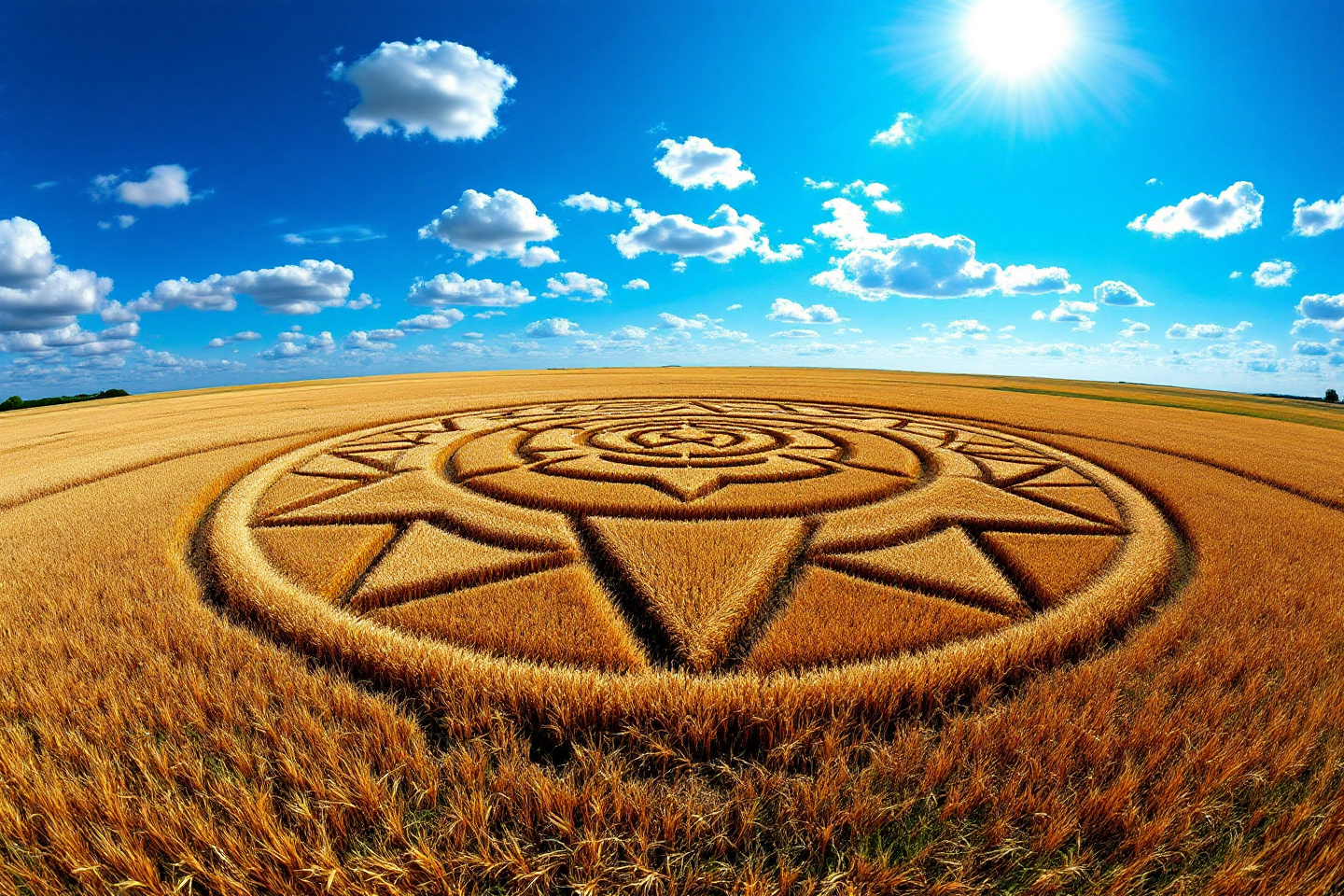
The triangle's role in sacred metallurgy extends to talismanic object creation designed to harness and direct specific energetic influences. Triangular metal arrangements in certain amulets—often gold, silver, and copper combinations—create energetic circuits resonating with particular planetary and elemental forces. These triangular talismans serve as subtle energy batteries and transformers, with each metal corresponding to specific astronomical bodies and their associated qualities. The precise angles and proportions determine their energetic effects, with craftsmen following formulas preserved in esoteric texts and oral traditions. When properly constructed and consecrated, these triangular devices function as interfaces between human consciousness and cosmic intelligences, facilitating communication and collaboration with higher forces.
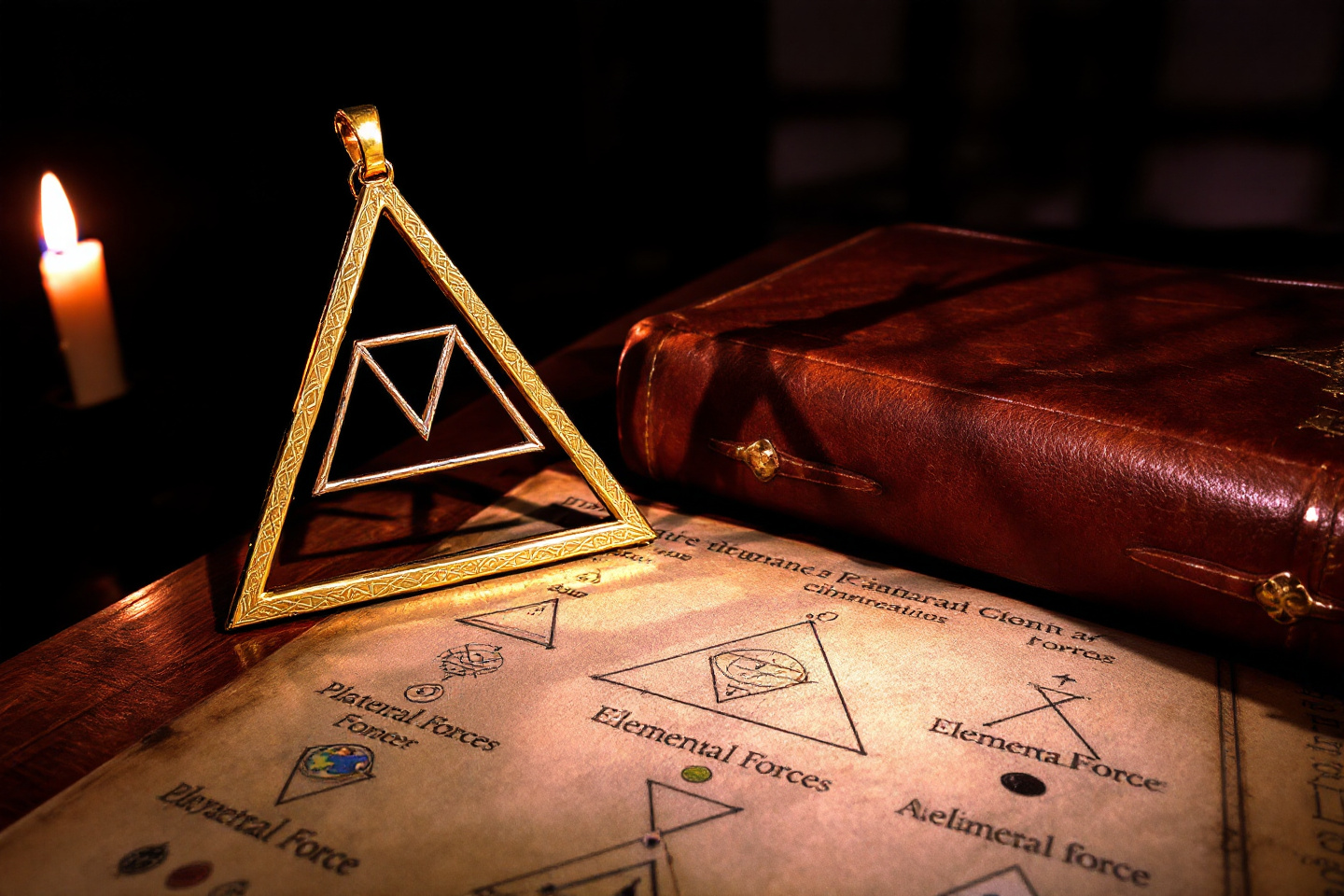
The triangle remains a living symbol in contemporary spiritual practice, inspiring new insights and applications while preserving ancient wisdom. Its three sides remind us that completion often requires multiple perspective integration, its stability demonstrates the strength from balanced relationship, and its geometric perfection suggests the mathematical intelligence underlying all creation. As we contemplate the triangle in its many manifestations—from sacred architecture to ritual formations to internal visualizations—we participate in a geometric contemplation tradition stretching back to human consciousness dawn and extending forward into evolving understanding of reality's fundamental nature. The triangle serves not merely as intellectual fascination object but as a key unlocking perception doors, revealing the elegant simplicity underlying existence's apparent complexity.
The Square □

The square exists as a fundamental geometric form that reveals profound truths about reality's underlying structure. Throughout history, spiritual traditions across civilizations have recognized the square as embodying essential cosmic principles. The square represents stability, foundation, and material manifestation in numerous mystical systems.
The square appears prominently in sacred geometry, where it functions as more than a mere shape but as a representation of cosmic laws. When a square is constructed with precise measurements, it creates relationships between numbers that mystics considered divine proportions. These mathematical relationships were not viewed as human inventions but as discoveries of pre-existing patterns in the fabric of reality. The square's perimeter and area calculations yielded numbers that recurred throughout nature, suggesting an intelligent design underlying creation.
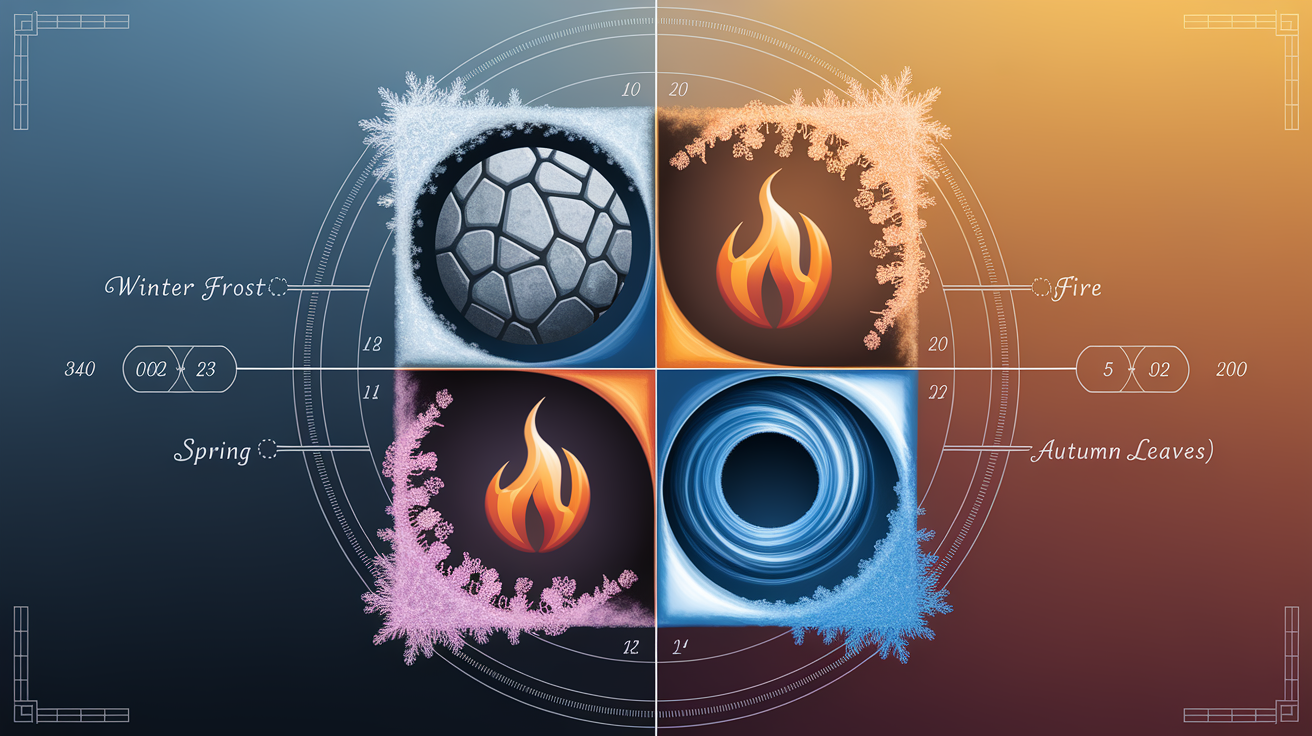
The square stands as a profound symbol of order, stability, and material manifestation across diverse spiritual traditions. With its four equal sides and perfect right angles, the square represents the physical world and earthly existence—a geometric embodiment of the tangible, structured universe we inhabit. Unlike the circle's infinite nature or the triangle's dynamic energy, the square grounds us in concrete reality, providing boundaries and definition to spiritual concepts.
The square serves as a potent emblem of completeness within the material realm, mirroring the fundamental ordering principles that govern physical existence. Its fourfold symmetry reflects the essential quaternary patterns woven throughout the fabric of creation: the four cardinal directions, the four seasons, the four classical elements, and the the-four-states-of-matter. This fourfold nature makes the square a natural symbol for wholeness within the manifest world, representing stability and permanence in contrast to the circle's boundless eternity.
In the natural world, the square reveals itself in crystalline structures like salt and pyrite, where atoms arrange themselves in cubic lattices following precise mathematical laws. The square's influence extends to biological forms as well, appearing in the cross-sectional structure of DNA's double helix and the organization of certain microscopic algae. These manifestations demonstrate how the square's ordering principles operate at multiple scales throughout creation, from the microscopic to the macroscopic.
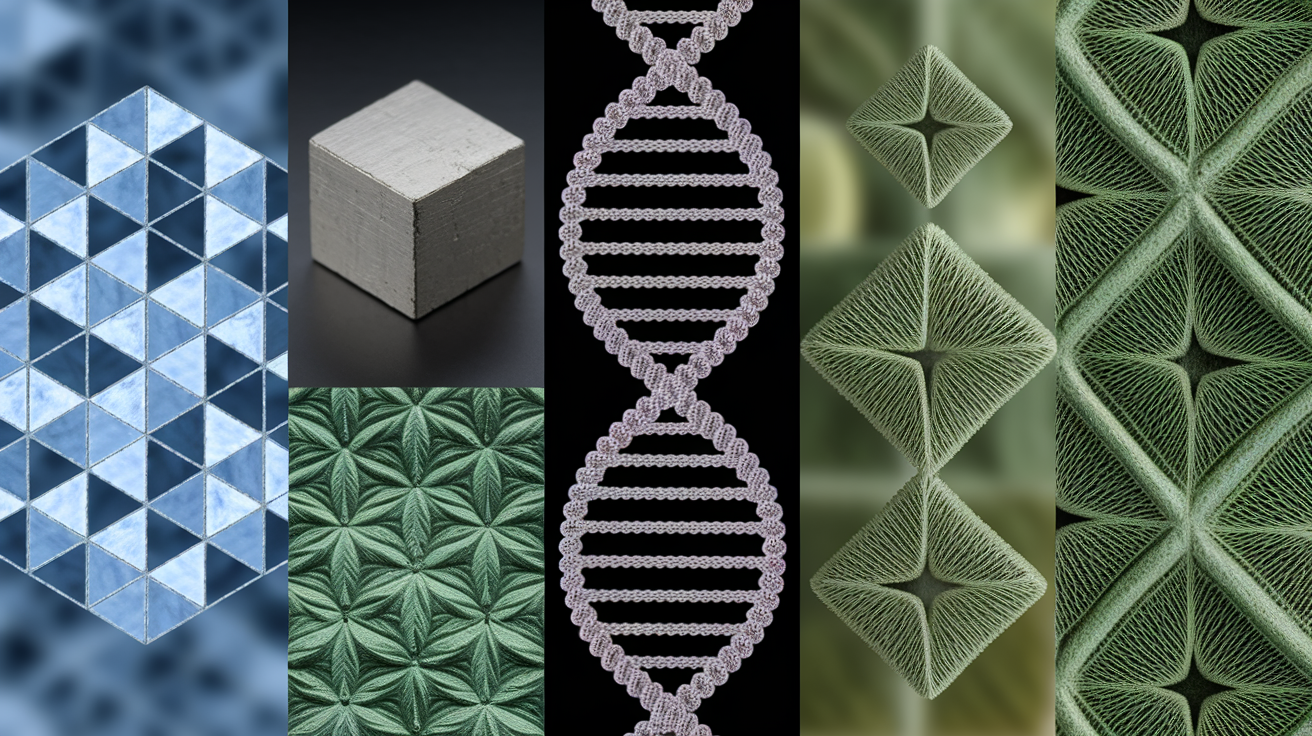
The square's manifestation in nature reveals a profound connection between mathematical principles and physical reality. In the natural world, geometric order emerges spontaneously through fundamental forces acting at different scales. This is particularly evident in crystalline structures like salt and pyrite, where atoms arrange themselves in cubic lattices.
The formation of cubic crystals involves a fascinating interplay between atomic forces and environmental conditions. When sodium chloride (table salt) crystallizes, it does so not by random chance but through a precise electrochemical ballet. Each sodium ion carries a positive charge, while each chloride ion carries a negative charge. These oppositely charged ions attract each other, forming bonds. What's remarkable is how these bonds organize spatially. The relative sizes of sodium and chloride ions, combined with their electromagnetic properties, create a situation where the most energetically favorable arrangement is for each sodium ion to be surrounded by six chloride ions, and vice versa. This creates an alternating three-dimensional pattern known as a face-centered cubic lattice.

As salt crystals grow, this atomic-level pattern extends outward. The microscopic cubic arrangement of atoms manifests as visible cubic crystals at the macroscopic level we can see with our naked eyes. When salt crystallizes from a saturated solution, the cubic pattern emerges because each new atom that joins the growing crystal preferentially attaches at positions that continue the existing cubic framework. This is why salt crystals typically form perfect cubes with flat faces meeting at right angles. The cubic structure represents the lowest energy state for this particular arrangement of atoms under normal conditions.
Pyrite, or iron disulfide, follows a similar principle but with different atomic constituents. In pyrite, iron and sulfur atoms bond in a distinctive arrangement where each iron atom is surrounded by six sulfur atoms in an octahedral configuration. These octahedra then interconnect in a cubic framework. The resulting crystal structure is known as a pyritohedron, which often appears as a cube with slightly modified faces. The brilliant, metallic luster of pyrite results from the regular arrangement of these atoms, which reflects light in a consistent manner.
Temperature and pressure play crucial roles in determining how these cubic crystals form. Under different environmental conditions, the same chemical constituents might arrange themselves into entirely different crystal structures. For instance, carbon atoms can organize themselves into the cubic structure of diamond under extreme pressure, or into the hexagonal layers of graphite under normal conditions. This phenomenon, known as polymorphism, demonstrates how environmental factors influence the geometric expression of atomic arrangements.
The process of crystal formation begins with nucleation, where a few atoms come together to form a small, ordered structure that serves as a template. Once this nucleus forms, additional atoms are attracted to this ordered structure, continuing the pattern. The rate at which crystals grow depends on factors like concentration, temperature, and the presence of impurities. In supersaturated solutions, crystals can form rapidly, sometimes resulting in smaller, less perfectly formed structures. In contrast, slow growth often yields larger, more perfect cubic crystals.
The square's influence extends to biological forms as well, appearing in the cross-sectional structure of DNA's double helix. While DNA is often depicted as a spiral staircase, a cross-sectional view reveals a roughly square arrangement of the sugar-phosphate backbone and nucleotide bases. This square-like geometry provides stability to the molecular structure while also facilitating the critical process of base pairing that underlies genetic information storage and transmission.

In certain microscopic algae, particularly diatoms, the square geometry appears in their silica cell walls. Diatoms extract silica from their aquatic environment and construct intricate glass-like shells called frustules. Some species of diatoms create frustules with remarkable square or rectangular symmetry. These structures follow mathematical principles similar to those found in inorganic crystals, demonstrating how living organisms can direct molecular components into precise geometric arrangements that offer both protection and functionality.
The prevalence of square and cubic structures across such diverse natural phenomena points to underlying physical principles that favor this geometry in certain contexts. From an energy perspective, cubic arrangements often represent optimal solutions for packing atoms together while minimizing repulsive forces. From a structural perspective, squares and cubes distribute force evenly across their faces, creating stability. And from a growth perspective, the perpendicular faces of cubes provide ideal surfaces for continued crystallization along the same pattern.
The mathematical elegance of these natural cubic structures inspired human architecture long before we understood their molecular underpinnings. Ancient civilizations, observing the perfect cubes of pyrite and salt crystals, incorporated square and cubic elements into their buildings, intuitively recognizing the stability and harmony these forms represented. Modern materials science continues to draw inspiration from these natural cubic structures, designing novel materials with specific crystal lattices to achieve desired properties.
The square's ordering principles operate at multiple scales throughout creation, from the microscopic arrangement of atoms in a salt crystal to the macroscopic structure of certain organisms. This geometric continuity across scales suggests that the square represents not just a shape but a fundamental organizational principle in the physical world—one that emerges when forces reach equilibrium and matter settles into its most stable configuration.
Throughout history, spiritual traditions across civilizations have recognized the square as embodying essential cosmic principles. The square represents stability, foundation, and material manifestation in numerous mystical systems. In ancient Egypt, the square formed the base of pyramids, symbolizing the physical world upon which spiritual aspirations could be built. Egyptian priests understood that the square represented the four elements—earth, air, fire, and water—that constitute the material universe. The square's four equal sides demonstrated perfect balance and harmony, qualities they sought to embody in their religious practices and architecture.
Alchemical traditions employed the square extensively in their symbolism. The square represented the physical body and earthly existence that required transformation. Alchemists drew squares in their manuscripts to indicate stable compounds or fixed states of matter. The transmutation process often began with a square that eventually transformed into a circle, representing the journey from material limitations to spiritual perfection.
The square, as a symbol in alchemical traditions, is deeply intertwined with the journey of transformation—both of matter and of the self. Its rigid, structured form represents the physical world, the earthly realm, and the material body, all of which are seen as the starting point for the alchemical process. The square’s transformation into a circle, a symbol of spiritual perfection and unity, encapsulates the alchemist’s ultimate goal: the elevation of the base into the divine, the transmutation of the profane into the sacred.
In alchemy, the square is often associated with the prima materia, the raw, unrefined substance from which all transformation begins. This prima materia is not just a physical substance but also a metaphor for the human condition—our base instincts, limitations, and earthly attachments. The square, with its four equal sides and right angles, symbolizes stability, solidity, and the fixed nature of the material world. It is the grounding force that anchors us to the physical plane, but it is also the prison from which the alchemist seeks to escape.
- Earthly Existence: The square represents the four elements—earth, air, fire, and water—which, in alchemical thought, constitute the physical world. These elements are not just external forces but also internal states of being. The alchemist’s task is to balance and harmonize these elements within themselves, transforming the chaos of the material world into the order of the spiritual realm.
- The Physical Body: In many alchemical texts, the square is associated with the human body, particularly in its unrefined state. The body, like the square, is seen as a vessel that contains the potential for transformation. Through the alchemical process, the body is purified and elevated, just as the square is transformed into the circle.
The journey from square to circle is the heart of the alchemical process. It represents the movement from the fixed, material world to the fluid, spiritual realm. This transformation is not just a physical process but also a spiritual one, involving the purification of the soul and the attainment of enlightenment.
- Nigredo (Blackening): The first stage of the alchemical process, nigredo, is often represented by the square. It is the stage of decay, dissolution, and putrefaction, where the prima materia is broken down into its constituent parts. This stage is necessary for transformation, as it clears away the impurities and prepares the substance (or the soul) for renewal.
- Albedo (Whitening): In the second stage, albedo, the square begins to lose its rigid form. The substance is purified and refined, moving closer to its spiritual essence. This stage is often associated with the moon and the feminine principle, representing intuition, reflection, and the inner light of the soul.
- Rubedo (Reddening): The final stage, rubedo, is the culmination of the alchemical process. Here, the square has been fully transformed into the circle, symbolizing the union of opposites and the attainment of the philosopher’s stone. The circle represents perfection, unity, and the divine, the ultimate goal of the alchemist’s quest.
In addition to representing the physical world, the square also serves as a symbol of stability and containment in alchemical practice. The alchemist’s laboratory is often depicted as a square or cubic space, representing the controlled environment in which transformation takes place. This containment is essential for the alchemical process, as it allows the alchemist to work with the volatile forces of nature without being overwhelmed by them.
- The Alchemical Vessel: The square is often associated with the alchemical vessel, the container in which the prima materia is transformed. This vessel is not just a physical object but also a metaphor for the human soul, which must be purified and strengthened to withstand the rigors of the alchemical process.
- The Four Corners: The four corners of the square represent the four cardinal directions, the four elements, and the four stages of the alchemical process. These corners are points of stability, anchoring the alchemist in the material world while they work to transcend it.
Alchemical manuscripts are filled with symbolic representations of the square, often in conjunction with other geometric shapes. These symbols are not just decorative but are meant to convey deep spiritual truths and guide the alchemist on their journey.
- The Squaring of the Circle: One of the most famous alchemical symbols is the squaring of the circle, which represents the reconciliation of opposites—the material and the spiritual, the earthly and the divine. This symbol is often depicted as a circle within a square or a square within a circle, illustrating the interplay between these two fundamental shapes.
The Philosopher’s Stone: The philosopher’s stone, the ultimate goal of the alchemical process, is often depicted as a square or cubic stone. This stone represents the perfected state of matter, the culmination of the alchemist’s work. It is both a physical substance and a spiritual ideal, embodying the unity of the material and the divine.
The alchemical journey from square to circle is not just a process of transforming matter but also a metaphor for personal transformation. The square represents the ego, the fixed sense of self that must be dissolved and reformed in the pursuit of spiritual enlightenment.
- The Ego as the Square: The ego, like the square, is rigid and fixed, defined by its boundaries and limitations. The alchemical process involves breaking down these boundaries, dissolving the ego, and allowing the true self to emerge.
- The Circle as the Self: The circle represents the true self, the soul in its purified and perfected state. This self is not bound by the limitations of the material world but is free, fluid, and united with the divine.
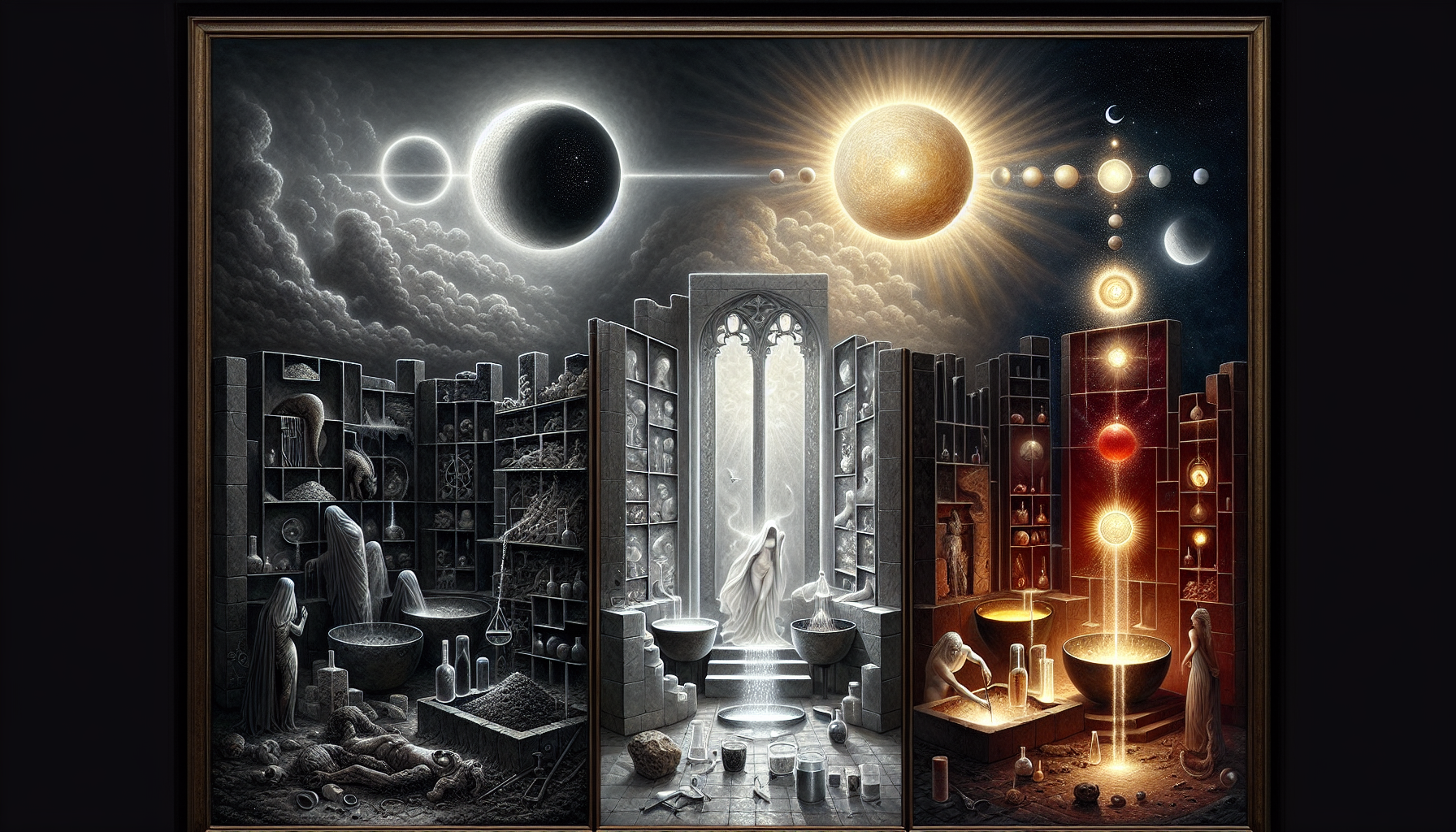
The Freemasons adopted the square as one of their principal symbols, using it to represent moral rectitude and ethical behaviour. The Masonic square reminds initiates to "square their actions" according to virtue and truth. This practical application of square symbolism demonstrates how geometric forms can serve as constant reminders of spiritual principles in daily life.
The square, as a symbol within Freemasonry, carries a profound and multi-layered significance that extends far beyond its simple geometric form. For Freemasons, the square is not merely a tool of the trade but a powerful emblem of moral rectitude, ethical behaviour, and the harmonious balance between the material and spiritual realms. Its origins lie in the practical world of operative stonemasonry, where it was used to ensure that stones were cut with precision and aligned perfectly to create stable and enduring structures. This practical application of the square laid the foundation for its symbolic meaning in speculative Freemasonry, where it became a metaphor for the moral and spiritual construction of the individual.
In Freemasonry, the square is one of the Three Great Lights, alongside the compass and the Volume of Sacred Law, often represented by the Bible. These symbols serve as guiding principles for Masons in their pursuit of moral and spiritual perfection. The square, in particular, is a constant reminder to "square one's actions" according to the principles of virtue, truth, and justice. This phrase encapsulates the idea that every action, like every stone in a building, must be measured against the standards of moral integrity. Just as the square ensures that stones are cut true and fit together perfectly, the Masonic square ensures that a person’s conduct is upright, honourable, and aligned with the principles of righteousness.
The square is deeply intertwined with the cardinal virtues of Freemasonry: Temperance, Fortitude, Prudence, and Justice. These virtues are the cornerstones of a well-lived life, and the square serves as a tool for measuring one’s adherence to them. It reminds Masons to act with balance and moderation, to stand firm in the face of adversity, to exercise wisdom in their decisions, and to treat others with fairness and equity. In this way, the square becomes a moral compass, guiding Masons in their daily lives and helping them navigate the complexities of human existence.
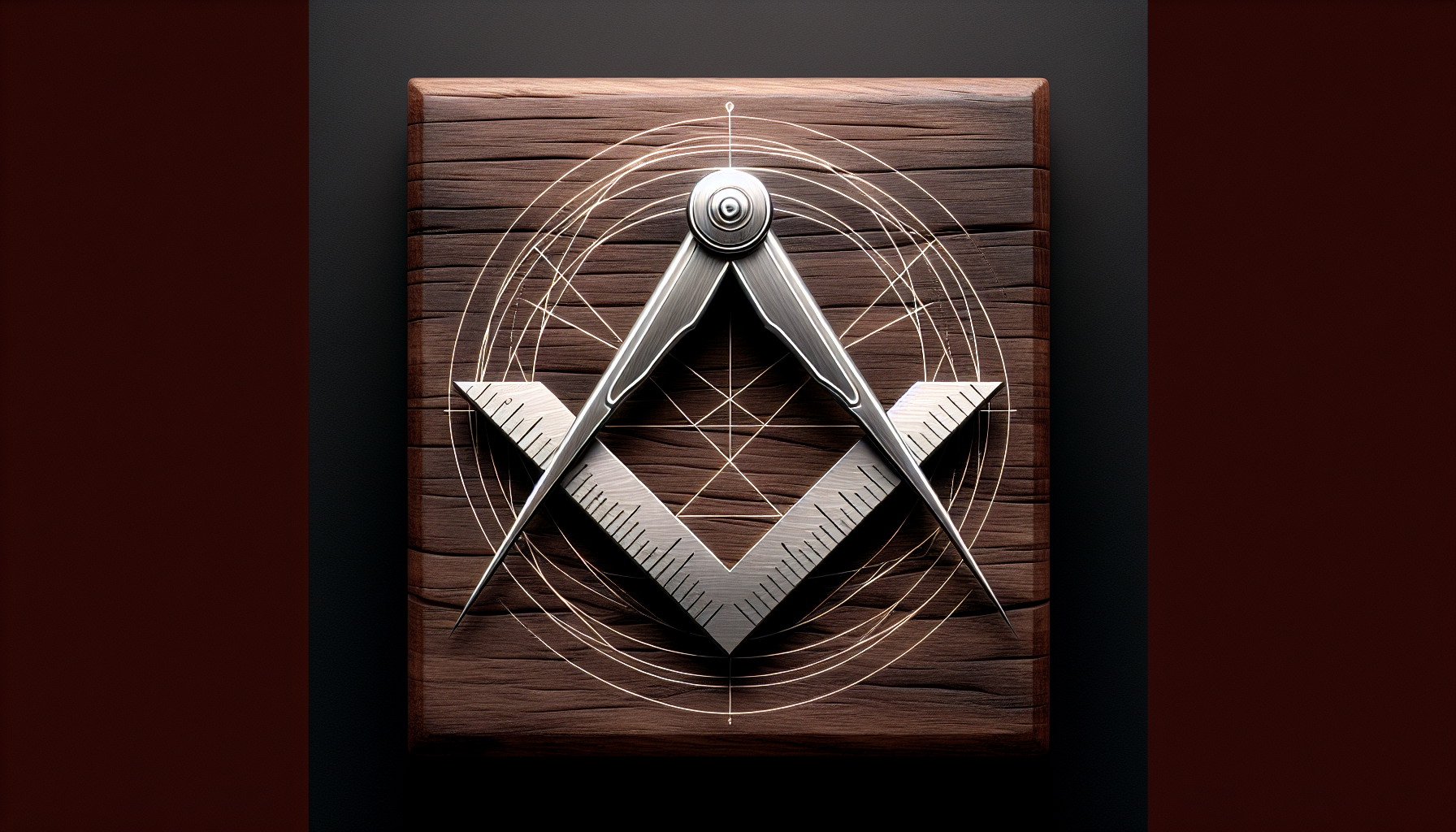
The square is often depicted in conjunction with the compass, another key Masonic symbol, and together they represent the duality of human experience. The square, with its four equal sides, symbolizes the material world and the physical body. It grounds the Mason in the realities of earthly life, reminding them of their responsibilities to themselves, their families, and their communities. The compass, on the other hand, draws circles and represents the spiritual realm and the soul. It symbolizes the aspiration to transcend material limitations and connect with the divine. When the square and compass are combined, they form a powerful symbol of the harmony between the material and the spiritual. The square provides the foundation for ethical living, while the compass elevates the Mason toward spiritual enlightenment, creating a dynamic interplay between the earthly and the divine.
In Masonic ritual and initiation, the square plays a central role, particularly during the degrees of Entered Apprentice, Fellowcraft, and Master Mason. In the Entered Apprentice degree, the initiate is introduced to the square as a symbol of morality. They are taught that the square represents the need to act with honesty and integrity in all aspects of life, laying the groundwork for their Masonic journey. In the Fellowcraft degree, the square takes on additional layers of meaning, becoming associated with the concept of proportion. It reminds the Mason to balance their intellectual, emotional, and spiritual development, ensuring that no single aspect of their being dominates at the expense of the others. Finally, in the Master Mason degree, the square symbolizes the completion of the Mason’s journey toward moral and spiritual perfection. It represents the attainment of inner harmony and the alignment of one’s actions with the divine will.
The square also serves as a reminder of the importance of community and brotherhood within Freemasonry. Just as stones must be squared and aligned to create a stable structure, individuals must work together in harmony to build a strong and cohesive society. The square teaches Masons to treat others with fairness and respect, to uphold the principles of justice and equality, and to contribute to the well-being of their communities. In this way, the square becomes a symbol not only of personal integrity but also of collective responsibility.
Beyond its moral and ethical significance, the square also carries a deeper philosophical meaning within Freemasonry. It represents the idea that the universe is governed by order and harmony, and that human beings have a responsibility to align themselves with these cosmic principles. The square’s perfect right angles and equal sides symbolize the balance and symmetry that underlie creation, reminding Masons of the importance of living in harmony with the natural world and the divine order. This philosophical dimension of the square connects Freemasonry to broader esoteric traditions, where geometric shapes are seen as expressions of universal truths.
In the context of personal transformation, the square serves as a metaphor for the process of self-improvement and spiritual growth. Just as a rough stone must be squared and polished to become part of a building, the individual must work to refine their character and align their actions with the principles of virtue and truth. This process of moral and spiritual refinement is at the heart of the Masonic journey, and the square serves as a constant reminder of the work that must be done to achieve inner harmony and enlightenment.
The square’s enduring significance within Freemasonry lies in its ability to bridge the practical and the symbolic, the material and the spiritual. It is a tool for building both physical structures and moral character, a symbol of both earthly responsibility and divine aspiration. Through the square, Freemasons are reminded of their duty to live with integrity, to act with justice, and to strive for balance in all aspects of their lives. In this way, the square becomes not just a symbol but a way of life, guiding Masons in their pursuit of truth, wisdom, and spiritual perfection.
The Chinese I Ching, or Book of Changes, is a profound system of divination and philosophy that has guided individuals for millennia in understanding the dynamic interplay of cosmic forces and human experience. At its core, the I Ching employs the principle of the square, not as a static form, but as a dynamic framework that organizes and harmonizes the energies of the universe. The eight trigrams, which form the foundation of the I Ching, are traditionally arranged in an octagonal pattern known as the Later Heaven sequence. This arrangement, while more complex than a simple square, retains the square’s essential qualities of balance, order, and stability, while also introducing a fluidity that reflects the ever-changing nature of existence.
The Later Heaven sequence, attributed to the legendary King Wen of the Zhou dynasty, is a masterful adaptation of the square’s geometric principles. Each of the eight trigrams—composed of three stacked lines, either broken (yin) or unbroken (yang)—occupies a specific position within the octagon, corresponding to one of the cardinal or intercardinal directions. This spatial arrangement creates a map of the cosmos, with each trigram representing a fundamental force or aspect of reality, such as heaven, earth, fire, water, thunder, wind, mountain, and lake. The square’s influence is evident in the way these trigrams are oriented, with their positions anchored to the four cardinal directions—north, south, east, and west—while the intercardinal directions complete the octagon, adding layers of complexity and nuance to the system.
The square’s corners, pointing to the four cardinal directions, serve as anchors that ground the practitioner in both physical and metaphysical space. In the physical realm, this orientation connects the I Ching to the natural world, aligning its wisdom with the cycles of the seasons, the movements of the stars, and the rhythms of the earth. In the metaphysical realm, the square’s structure provides a framework for understanding the interplay of yin and yang, the dual forces that underlie all creation. The square’s stability ensures that these forces remain in balance, even as they flow and transform within the dynamic octagonal pattern of the Later Heaven sequence.
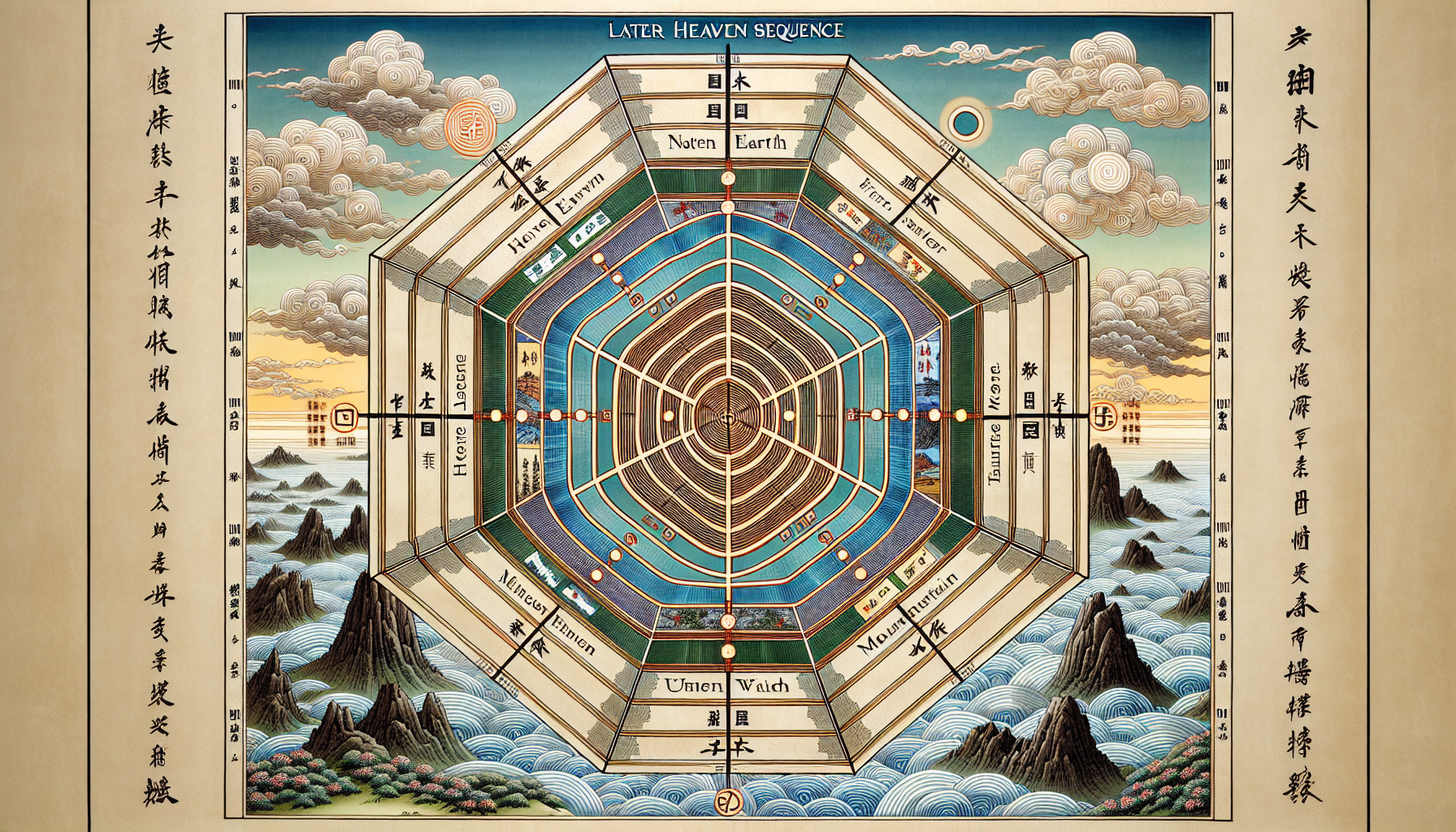
The Later Heaven sequence is not merely a static diagram but a living system that reflects the constant flux of the universe. Each trigram interacts with the others, creating a web of relationships that mirrors the interconnectedness of all things. The square’s influence is felt in the way these relationships are structured, with each trigram occupying a fixed position that contributes to the overall harmony of the system. This balance is essential for the practitioner, who uses the I Ching to navigate the complexities of life and make decisions that align with the natural order. By consulting the trigrams and their relationships, the practitioner gains insight into the forces at play in any given situation, allowing them to act with wisdom and foresight.
The square’s role in the I Ching extends beyond its geometric form to its symbolic meaning. In Chinese cosmology, the square represents the earth, while the circle represents heaven. Together, they symbolize the harmonious relationship between the material and spiritual realms, a theme that is central to the I Ching. The Later Heaven sequence, with its octagonal pattern rooted in the square, embodies this harmony, providing a bridge between the earthly and the divine. The square’s stability ensures that the practitioner remains grounded in the physical world, while the fluidity of the octagon allows them to connect with the higher forces that govern existence.
The I Ching’s use of the square also reflects its emphasis on balance and proportion, qualities that are essential for both personal and cosmic harmony. The square’s equal sides and right angles symbolize the need for equilibrium in all aspects of life, from the individual’s inner world to the broader social and natural order. This principle is echoed in the I Ching’s teachings, which emphasize the importance of aligning oneself with the natural flow of the universe and maintaining harmony between opposing forces. The square, as a symbol of stability and order, serves as a reminder of this fundamental truth, guiding the practitioner toward a life of balance and integrity.
In addition to its philosophical and symbolic significance, the square’s influence in the I Ching can be seen in its practical applications. The Later Heaven sequence is often used in feng shui, the ancient Chinese art of harmonizing individuals with their environment. In feng shui, the square’s orientation to the cardinal directions is used to align buildings, rooms, and objects with the natural flow of energy, or qi. This practice reflects the I Ching’s broader emphasis on creating harmony between the human and natural worlds, a principle that is rooted in the square’s geometric and symbolic qualities.
The I Ching’s use of the square also highlights its connection to other ancient systems of wisdom, such as sacred geometry and numerology. The square’s four sides correspond to the number four, which holds deep significance in many spiritual traditions as a symbol of completeness and stability. In the I Ching, this symbolism is expanded through the eight trigrams, which represent the eight fundamental forces of the universe. The interplay between the square’s stability and the octagon’s fluidity creates a dynamic system that reflects the complexity and richness of existence, offering the practitioner a profound tool for understanding and navigating the world.
Medieval cathedrals incorporated square patterns in their floor plans, creating a grid that oriented worshippers toward the sacred. Architects understood that the square created a sense of stability and permanence that enhanced religious experience. The square's perfect right angles established order amidst chaos, a physical representation of divine law governing creation.
Magical traditions worldwide use squares in rituals designed to manifest desires in the physical world. The square's association with earth energy makes it ideal for grounding spiritual forces into material reality. Ritual spaces often begin with the establishment of a square boundary that practitioners consider protected and empowered. This creates a container for magical energies to accumulate and take form.
Numerologists attribute profound significance to squares of numbers. The square of three—nine—represents completion, while the square of four—sixteen—represents material perfection. These mathematical relationships reveal how squaring enhances and amplifies the inherent qualities of numbers, just as spiritual practices aim to enhance human potential.
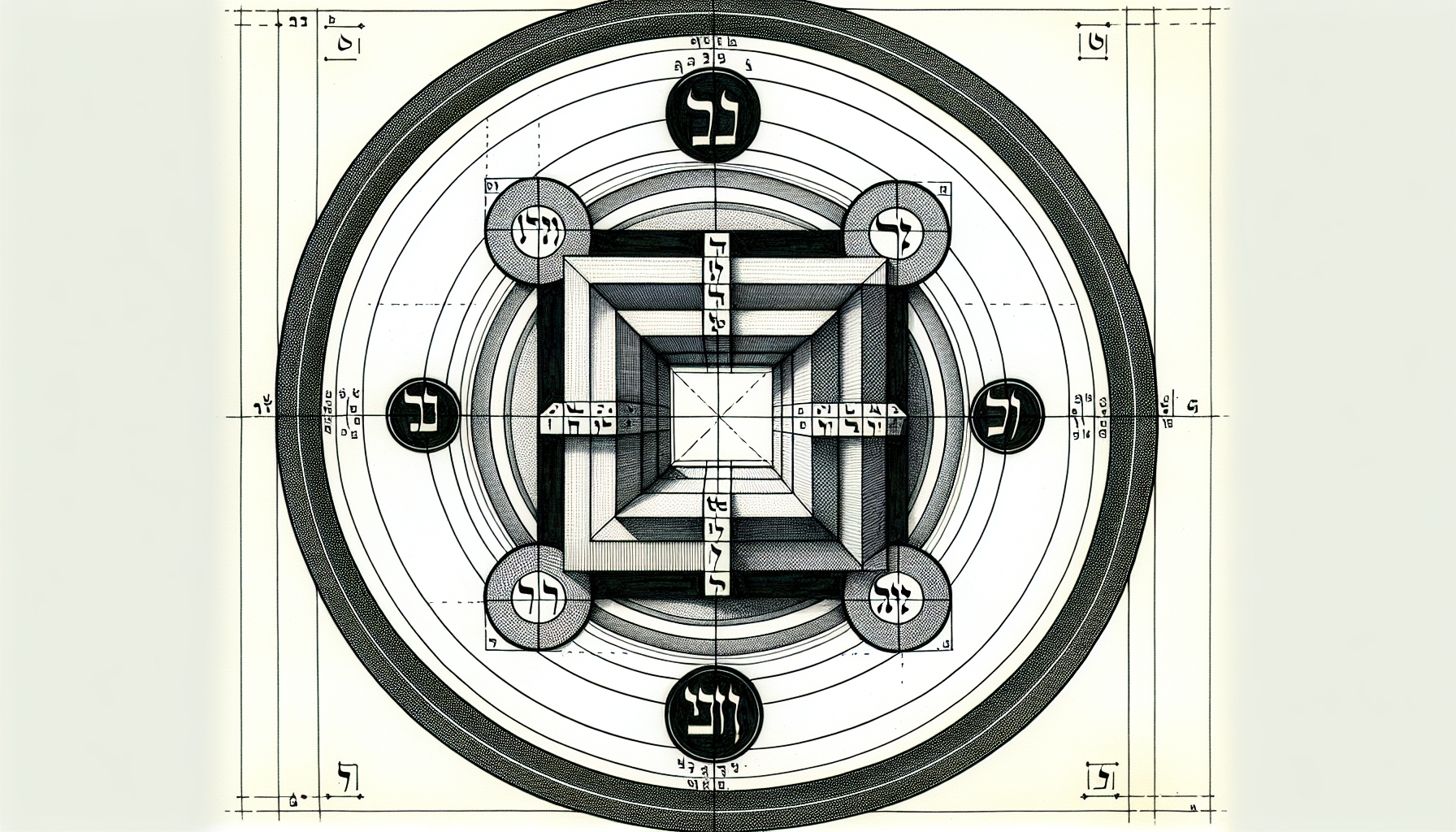
Kabbalah depicts the material world through the square form, contrasting it with the circle that represents spiritual perfection. Kabbalists teach that human existence involves reconciling these geometric principles—bringing divine order into material reality. The Four Letters of the Tetragrammaton, God's most sacred name in Jewish mysticism, correspond to the square's four sides, each representing an aspect of divine manifestation in the physical world.
The Tarot tradition features squares in cards representing material existence and worldly affairs. The four suits—pentacles, swords, cups, and wands—correspond to the four elements and the four sides of the square. This fourfold structure provides a comprehensive framework for understanding human experience. The square appears most prominently in cards dealing with structure, limitation, and material concerns.
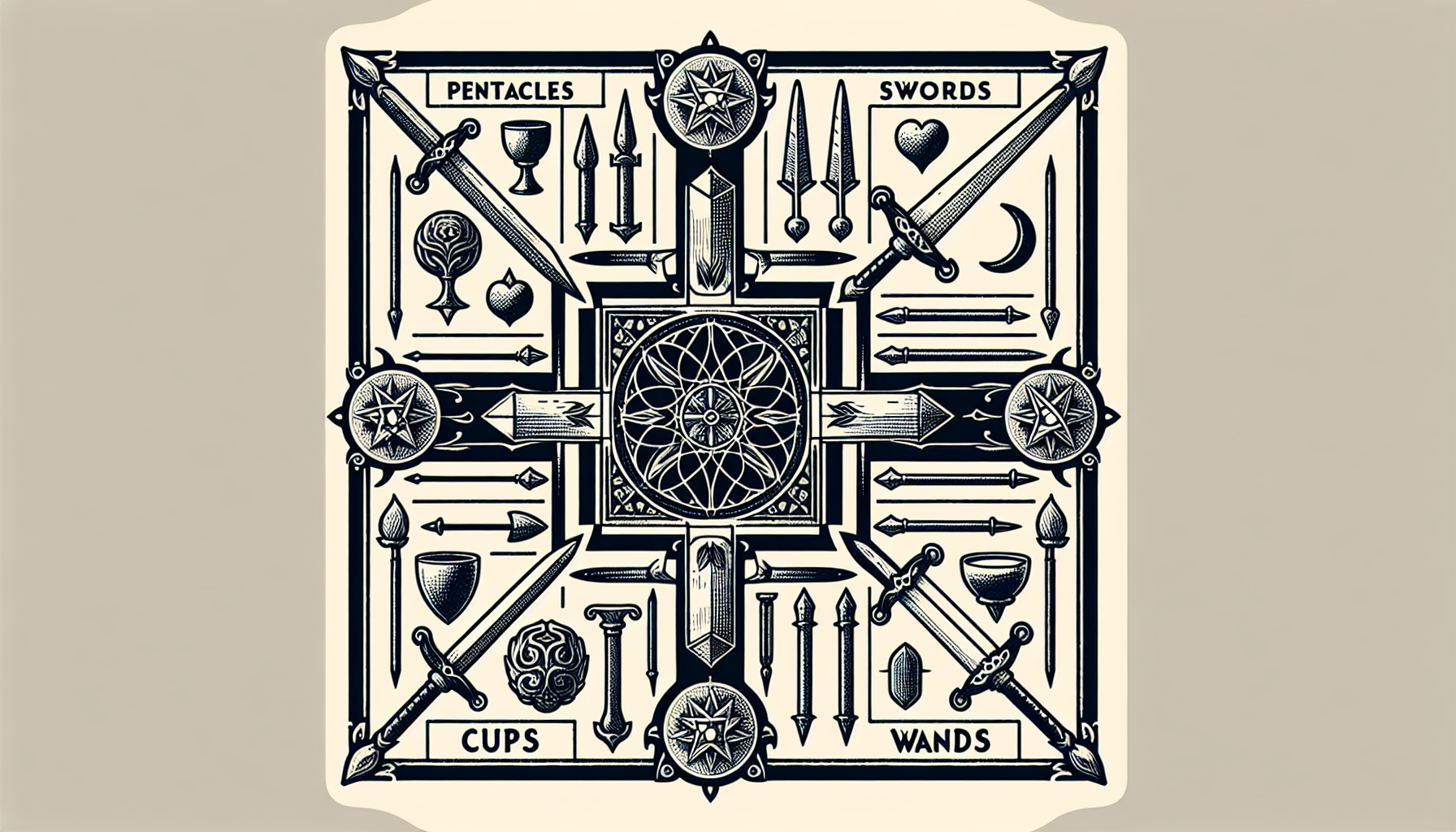
The Tarot, a rich and multifaceted system of symbolism and divination, weaves the square into its imagery as a profound representation of material existence, structure, and the tangible aspects of human experience. Within the Tarot’s intricate tapestry, the square emerges as a recurring motif, particularly in the Minor Arcana, where the four suits—pentacles, swords, cups, and wands—each correspond to one of the four classical elements: earth, air, water, and fire. This fourfold structure mirrors the square’s four equal sides, creating a symbolic framework that encapsulates the complexities of worldly life and the human condition. Through this alignment, the square becomes a lens through which the Tarot explores themes of stability, limitation, and the interplay between the material and spiritual realms.
The four suits of the Tarot, each associated with an element, reflect the square’s inherent balance and symmetry. Pentacles, linked to the element of earth, represent the material world—wealth, work, and the physical body. Swords, aligned with air, symbolize the intellect, conflict, and the power of thought. Cups, connected to water, embody emotions, relationships, and the subconscious. Wands, tied to fire, signify creativity, passion, and spiritual energy. Together, these four suits form a complete picture of human experience, much like the four sides of a square create a unified whole. The square’s geometric perfection serves as a reminder that each of these aspects of life is interconnected, and that balance among them is essential for harmony and fulfillment.
In the Tarot, the square appears most prominently in cards that deal with structure, limitation, and the tangible realities of existence. The Four of Pentacles, for example, often depicts a figure holding onto material possessions, symbolizing the need for stability and security but also the potential for greed or stagnation. Here, the square represents the boundaries and constraints of the material world, reminding us that while structure is necessary, it can also become a prison if we cling too tightly to it. Similarly, the Four of Swords shows a figure at rest, often within a square or cubic space, suggesting a period of retreat and reflection. In this context, the square signifies the need for grounding and stability, even in the midst of mental or emotional turmoil.
The square’s presence in the Tarot is not limited to the Minor Arcana; it also appears in the Major Arcana, where it carries deeper spiritual and philosophical meanings. The card of The Emperor, for instance, is often depicted seated on a cubic throne, symbolizing his role as a ruler who brings order and structure to the world. The cube, a three-dimensional square, represents the material realm in its most solid and stable form. The Emperor’s association with the square underscores the importance of discipline, authority, and the establishment of systems that support growth and progress. Yet, the square also serves as a reminder that even the most rigid structures must be tempered by wisdom and compassion, lest they become oppressive.
In the card of The World, the square appears in a more transcendent form, often as a mandorla or a frame surrounding the central figure. Here, the square represents the culmination of the Fool’s journey through the Major Arcana, symbolizing the integration of the material and spiritual realms. The figure within the square is often depicted dancing or in motion, suggesting that true mastery of the material world comes not from rigid control but from a dynamic balance between structure and fluidity. The square, in this context, becomes a symbol of wholeness and completion, reflecting the Tarot’s overarching message that the material and spiritual are not separate but interconnected aspects of a unified reality.
The square’s symbolism in the Tarot also extends to its use as a tool for divination and self-reflection. When a Tarot reading is laid out in a square or grid-like pattern, such as the Celtic Cross spread, the square’s structure provides a framework for interpreting the cards and their relationships to one another. Each position in the spread corresponds to a specific aspect of the querent’s life, much like the four sides of the square correspond to the four elements and suits. This geometric arrangement allows the reader to see how different areas of life are interconnected and how balance can be achieved among them. The square’s stability and order create a sense of clarity and focus, helping the querent navigate the complexities of their situation with greater insight and understanding.
Beyond its practical applications, the square in the Tarot also carries a deeper metaphysical meaning. It represents the idea that the material world, with all its limitations and challenges, is a necessary stage in the soul’s journey toward enlightenment. The square’s rigid lines and right angles remind us that structure and boundaries are essential for growth, providing the foundation upon which higher spiritual truths can be built. At the same time, the square’s connection to the four elements and suits underscores the importance of integrating all aspects of the self—physical, mental, emotional, and spiritual—in order to achieve true wholeness.
In the Tarot, the square is not merely a symbol of limitation but also of potential. It represents the raw material of existence, the prima materia from which all creation emerges. Just as the alchemist transforms base metals into gold, the Tarot invites us to transform our understanding of the material world, seeing it not as a prison but as a canvas upon which we can paint the masterpiece of our lives. The square’s stability provides the grounding we need to embark on this transformative journey, while its connection to the four elements reminds us that balance and harmony are the keys to unlocking our full potential.
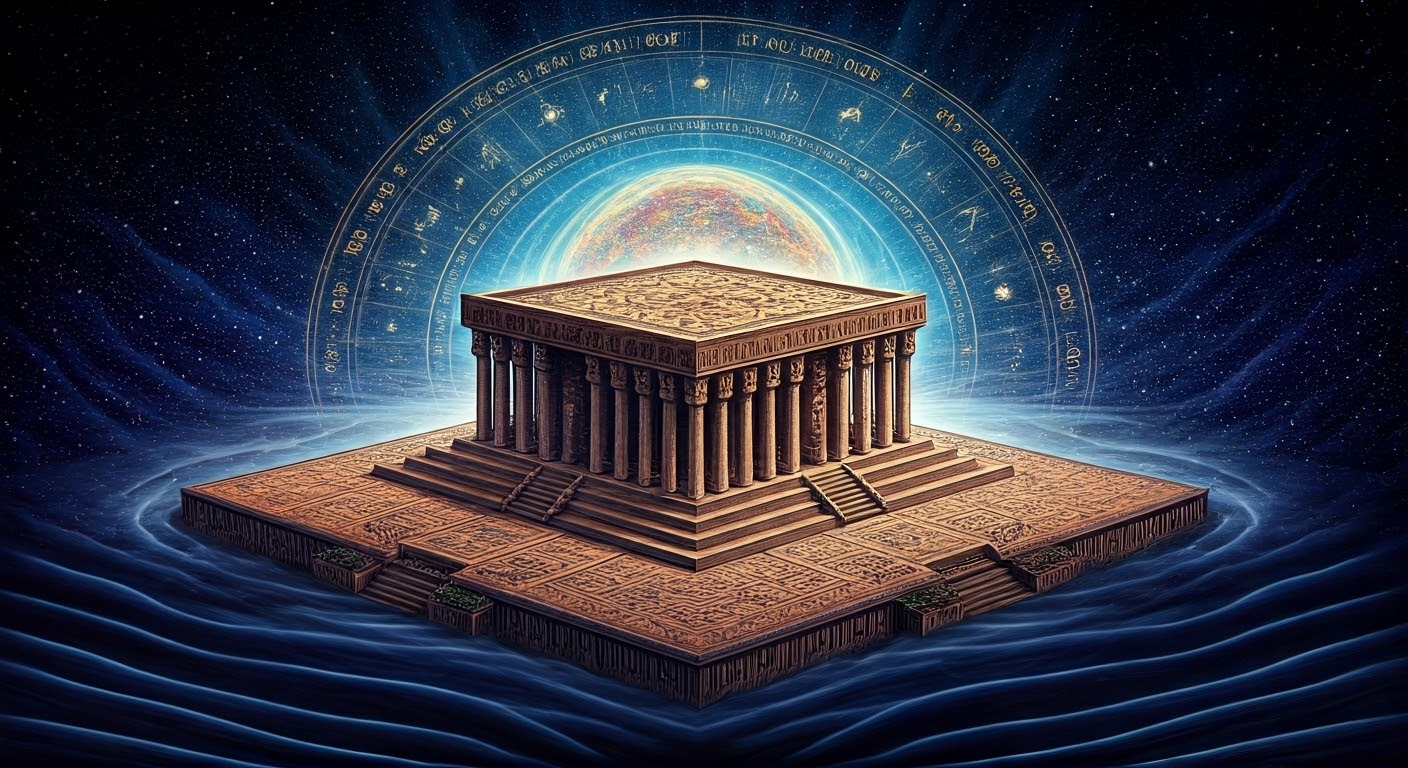
The metaphysical meaning of the square extends into the realm of sacred architecture. Temples worldwide incorporate square foundations, connecting earthly structures with cosmic principles. These square bases establish a relationship between human construction and universal laws. The precise measurements of these squares often encode astronomical knowledge, aligning buildings with celestial movements.
The occult significance of the square appears in magical squares—numeric grids where rows, columns, and diagonals sum to the same number. These squares, attributed to planetary energies, were considered powerful tools for invoking specific cosmic forces. The seven traditional magical squares correspond to the seven classical planets, each embodying particular metaphysical qualities. The simplest, the 3×3 square of Saturn, demonstrates mathematical perfection that mystics viewed as evidence of divine intelligence operating through number.
Astrologers employ the square aspect between planets to indicate tension and challenge. This 90-degree angle, forming one corner of a square, represents developmental friction that ultimately strengthens character. The square aspect shows how even geometric relationships that create difficulty serve evolutionary purposes in spiritual growth.
The square's definition requires perfect right angles, symbolizing absolute truth and justice in spiritual traditions. These 90-degree angles represent unbending principles that govern moral behavior. Mystical schools taught that just as a carpenter's square ensures structural integrity in buildings, adherence to spiritual laws ensures integrity in human character.
In meditation practices, visualizing a square helps practitioners establish boundaries and create sacred space within consciousness. The square provides structure for awareness, preventing the mind from wandering aimlessly. Advanced meditators may progress from square visualizations to more fluid circular forms, representing the journey from structured practice to spontaneous spiritual awareness.
Visionary experiences across cultures often begin with geometric forms including squares. These elementary shapes constitute the visual language of mystical states, appearing at the threshold between ordinary and non-ordinary consciousness. The square frequently appears in these visions as a gateway or portal to deeper spiritual dimensions, providing familiar structure before consciousness encounters less defined experiences.
The square stone, perfectly carved, appears in numerous spiritual traditions as a symbol of the perfected soul. The rough stone, extracted from nature, must be precisely squared by disciplined spiritual practice before it can join the cosmic temple. This metaphor emphasizes how humans must consciously align themselves with universal principles to fulfill their spiritual potential.
The square appears in creation myths worldwide, often representing the primordial field from which all forms emerge. These myths describe divine beings measuring creation with a square, establishing order from chaos. The square represents the rational, measurable aspects of creation that make existence comprehensible to human minds.
Divine proportion relationships between the square and other geometric forms reveal essential truths about reality's structure. When a circle is drawn around a square, the ratio between their areas encodes mathematical constants that mystics considered keys to understanding creation. These relationships demonstrate how seemingly simple geometric forms contain profound mathematical wisdom.
The square's occult significance extends to its appearance in spiritual texts across traditions. Sacred books describe divine thrones with square bases, heavenly cities with square layouts, and altars with square dimensions. These descriptions communicate that divine reality includes perfect order and measurement alongside more transcendent qualities.
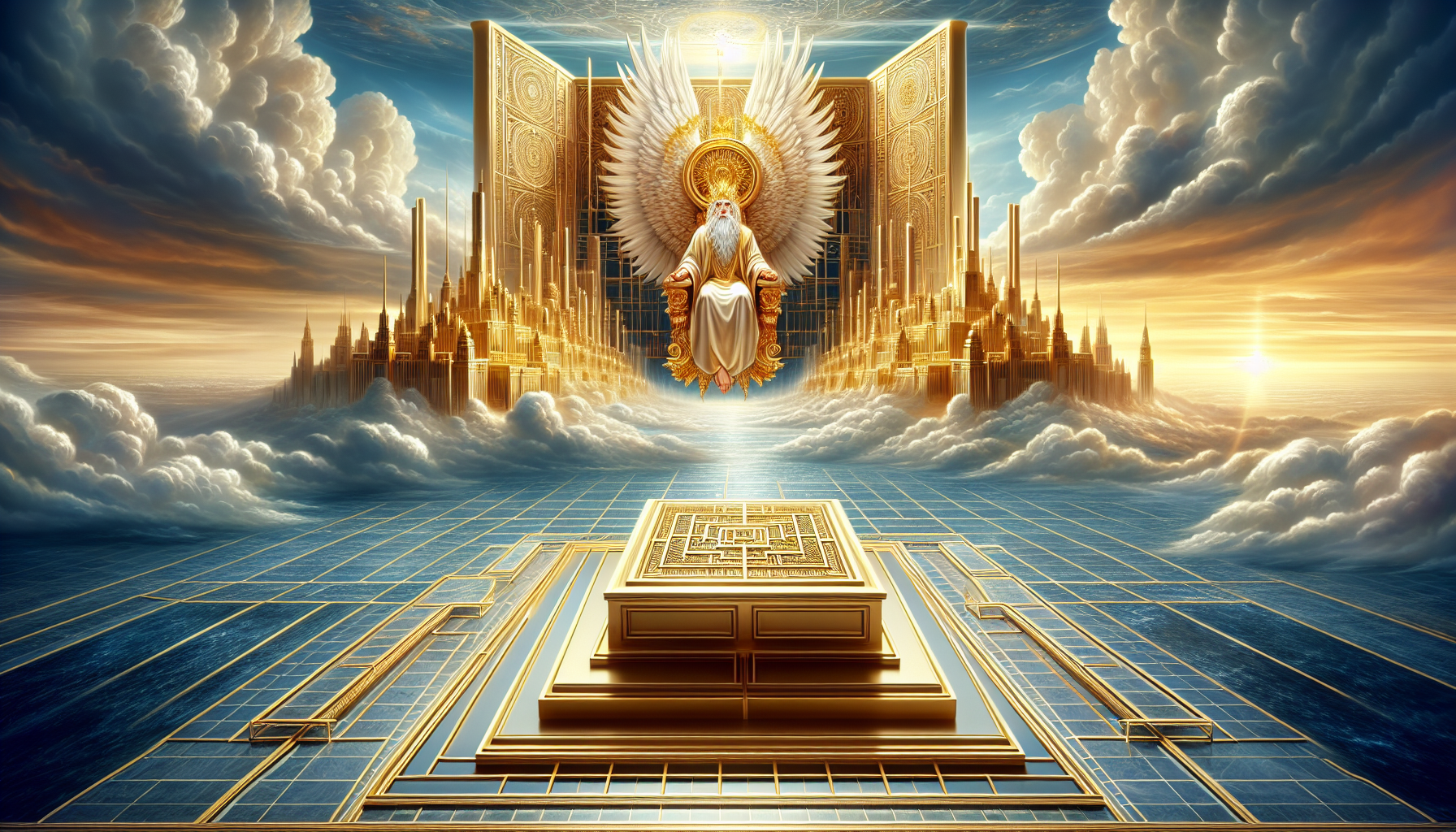
The square represents justice and fairness in ethical systems worldwide. The expression "fair and square" reflects this association, suggesting that justice requires adherence to clear principles. Spiritual traditions teach that personal development requires establishing a square foundation of ethical behavior before attempting more advanced practices.
The esoteric tradition assigns the square to the material world while associating the triangle with the mental realm and the circle with the spiritual dimension. This hierarchy of forms represents states of consciousness from most dense to most refined. Spiritual development involves integrating these geometric principles, bringing material existence into harmony with spiritual truth.
In shamanic journeying, practitioners sometimes begin by visualizing square gateways that provide access to other worlds. These squares function as organized entry points into non-ordinary reality. The square's stability creates a reliable access point that shamans can return to consistently across multiple journeys.

The square in mystical traditions represents both limitation and possibility. While it constrains with its straight lines and right angles, it also creates a defined space within which creation can occur. This paradox mirrors human existence itself—bound by physical laws yet free to create within those boundaries. The spiritual significance of the square ultimately reminds us that structure and freedom are complementary rather than contradictory aspects of existence.
The square's perfection lies in its equality—four identical sides and four identical angles creating perfect balance and symmetry. This equality makes the square an ideal foundation for constructing physical spaces, from individual buildings to entire cities. The grid pattern derived from the square provides the most efficient way to organize human habitation, allowing for clear boundaries, equitable distribution of resources, and navigational clarity. Ancient city planners from China to Rome employed square grids in their urban designs, recognizing how this form creates order from potential chaos.
Sacred architecture worldwide reveals the square's profound significance across diverse spiritual traditions. From Hindu temples to Islamic mosques, Christian cathedrals to Buddhist stupas, the square often serves as the foundational form upon which sacred structures are built. This universal application suggests a shared intuitive understanding of the square's power to establish sacred space within the material world.
In Hindu temple architecture, the square forms the basis of the Vastu Purusha Mandala—a sacred diagram that guides temple construction. This square grid, divided into 64 or 81 smaller squares, represents both the cosmos and the human body lying prostrate. Each square within this grid houses a specific deity or energy, creating a comprehensive map of cosmic forces. Temple architects use this sacred geometry to ensure the building becomes a proper dwelling for divine energies. The central square, known as Brahmasthana, represents the meeting point of heaven and earth, serving as the temple's energetic heart.
The square's stability makes it the natural foundation for supporting more dynamic forms above. Hindu temples typically rise from a square base toward a circular or octagonal spire, physically embodying the journey from material reality (the square) toward spiritual transcendence (the circle). This architectural pattern creates a three-dimensional yantra—a geometric meditation tool—allowing worshippers to experience the transition from mundane to sacred consciousness simply by moving through the space.
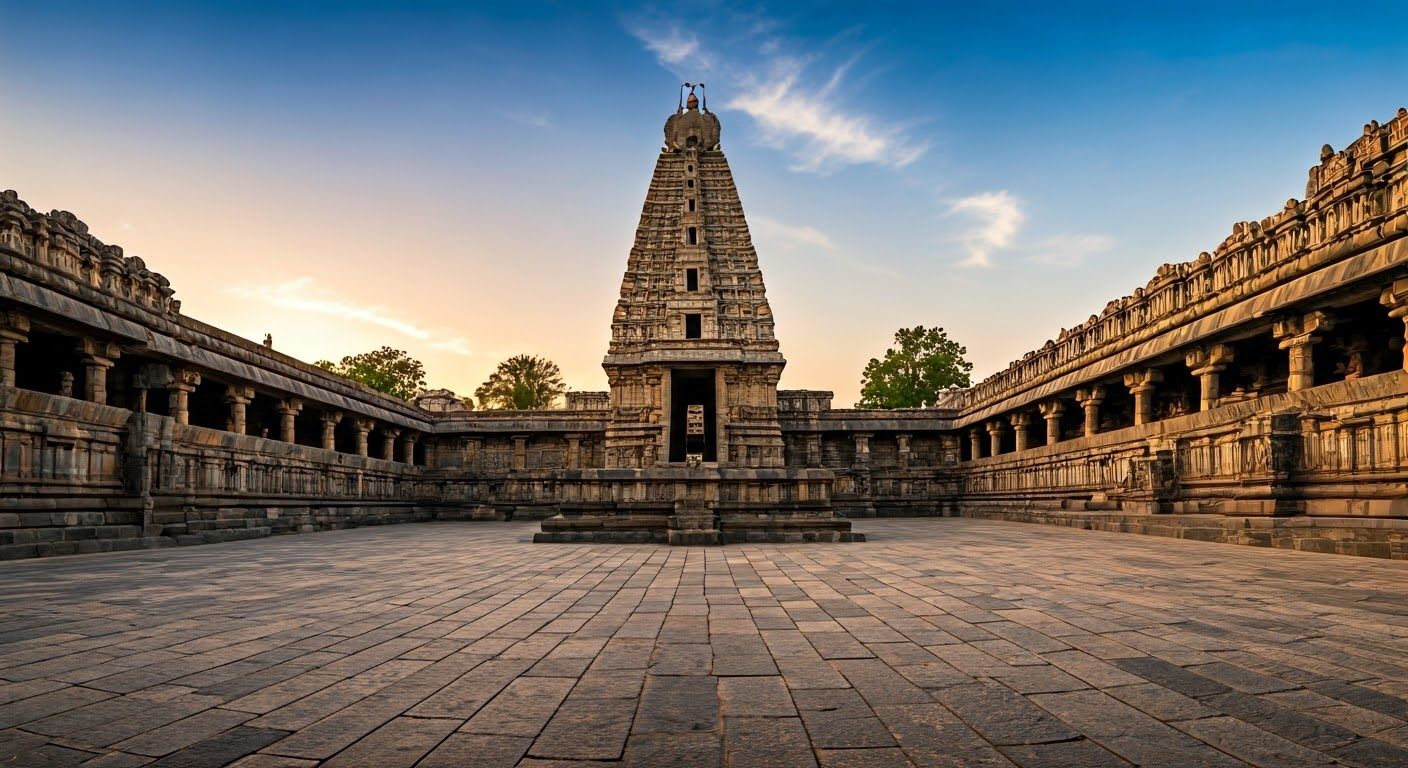
In Islamic tradition, the Kaaba in Mecca—Islam's holiest site—takes the form of a perfect cube, a three-dimensional square. This cubic structure serves as the focal point for Muslim prayer worldwide, with the faithful orienting themselves toward it five times daily. The Kaaba's square form represents stability and permanence, appropriate for a structure tradition holds was first built by Abraham and later restored by Muhammad. Its black covering emphasizes its solid, definite form—a fixed point of orientation in both physical and spiritual terms.
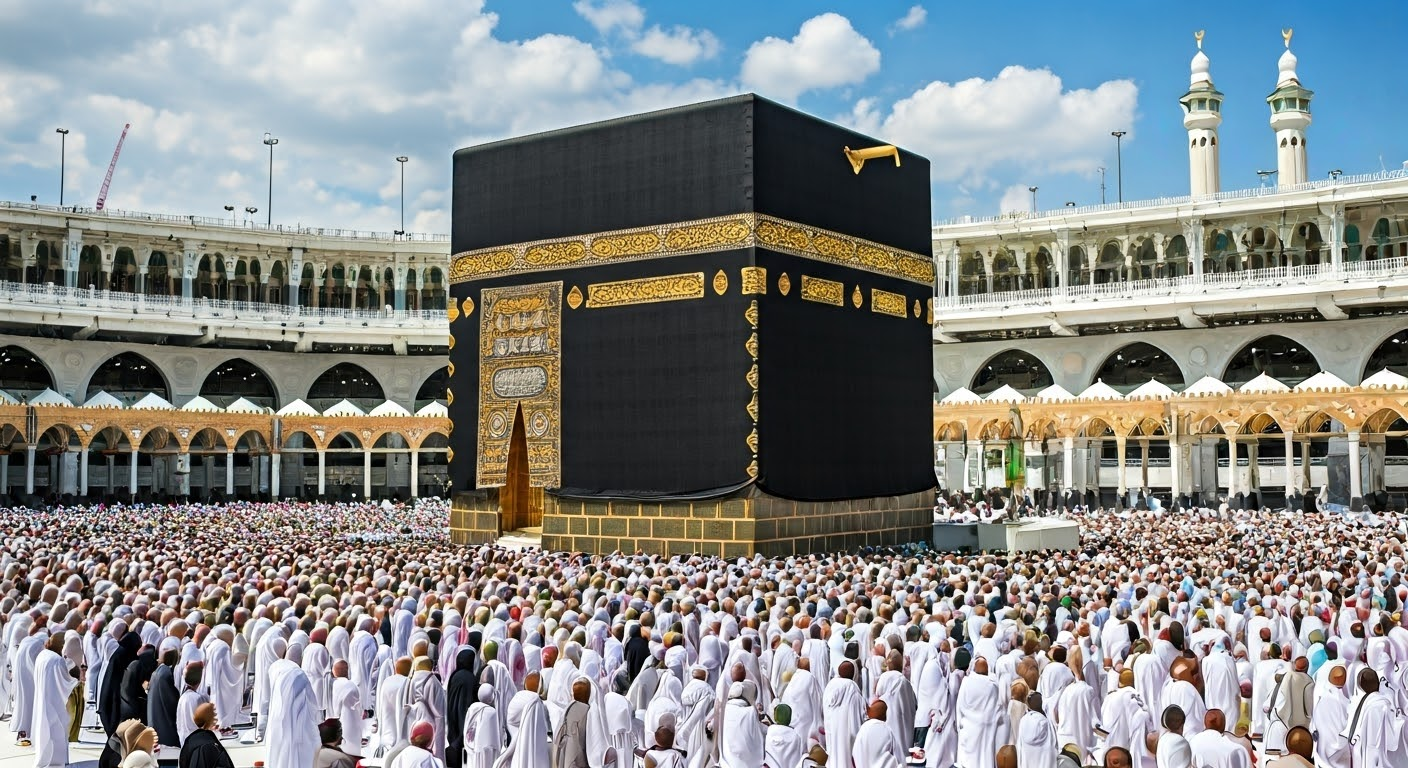
Islamic geometric art frequently employs the square as a starting point for creating complex patterns. Artists begin with a square grid that establishes perfect order, then overlay this foundation with circles and polygons to create intricate designs. These patterns often feature eight-pointed stars derived from the square through rotation and overlay. This transformation process symbolizes how the material world (represented by the square) contains and reveals spiritual truths (represented by more complex forms) when approached with mathematical precision and contemplative attention.
Medieval Christian cathedrals incorporated the square into their sacred geometry in numerous ways. The crossing—where the nave and transept intersect—often forms a perfect square, symbolizing the meeting of heaven and earth at the heart of the church. This square crossing supports the circular dome or tower above, again representing the relationship between earthly and divine realms. The famous labyrinth at Chartres Cathedral is set within a square frame that organizes the circular path within, demonstrating how the square provides structure and boundaries for the spiritual journey.
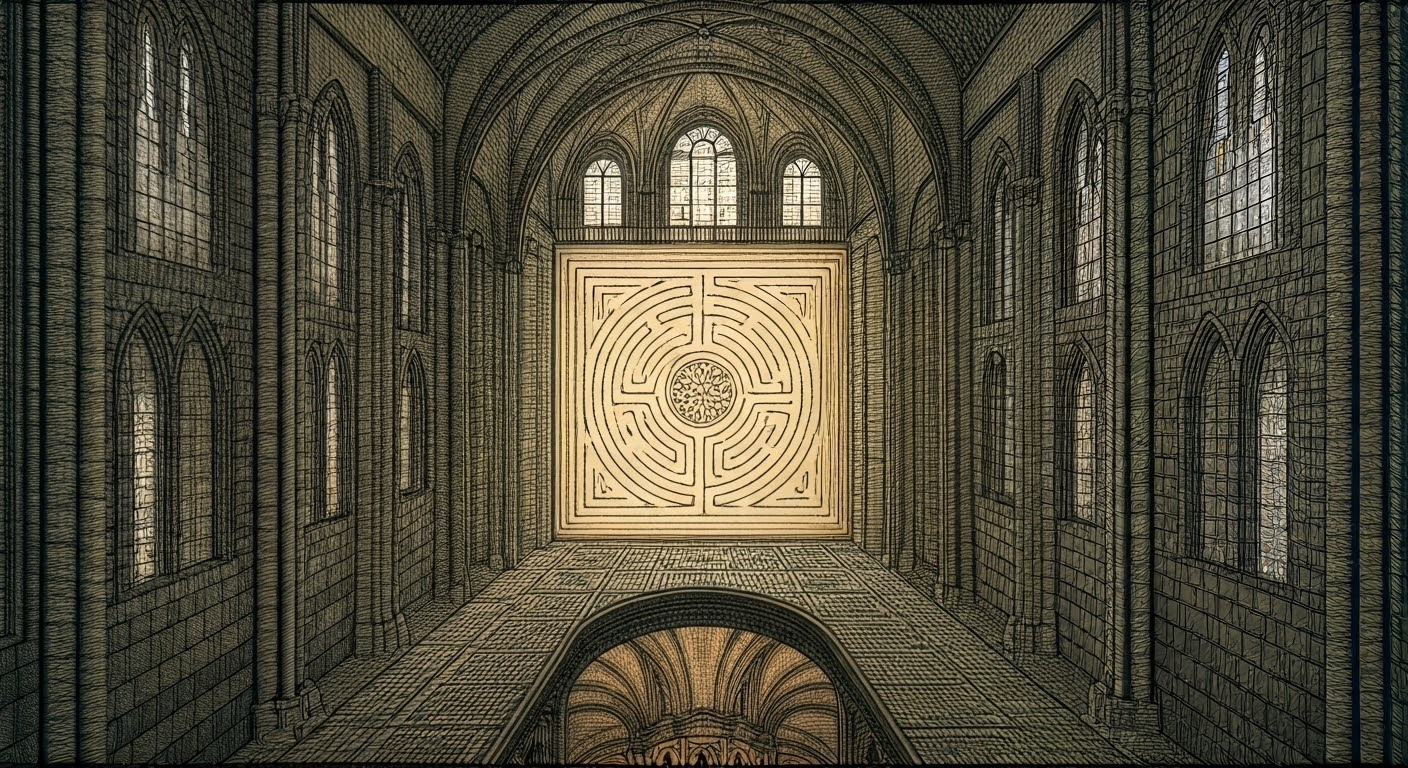
The Christian tradition also employed the square in its iconography. The nimbus (halo) behind the heads of saints is traditionally circular, representing their spiritual nature. However, when depicting living holy figures, artists often used a square nimbus instead, indicating that these individuals still inhabited the material world despite their spiritual advancement. This distinction reflects the square's association with physical existence and the circle's connection to spiritual perfection.
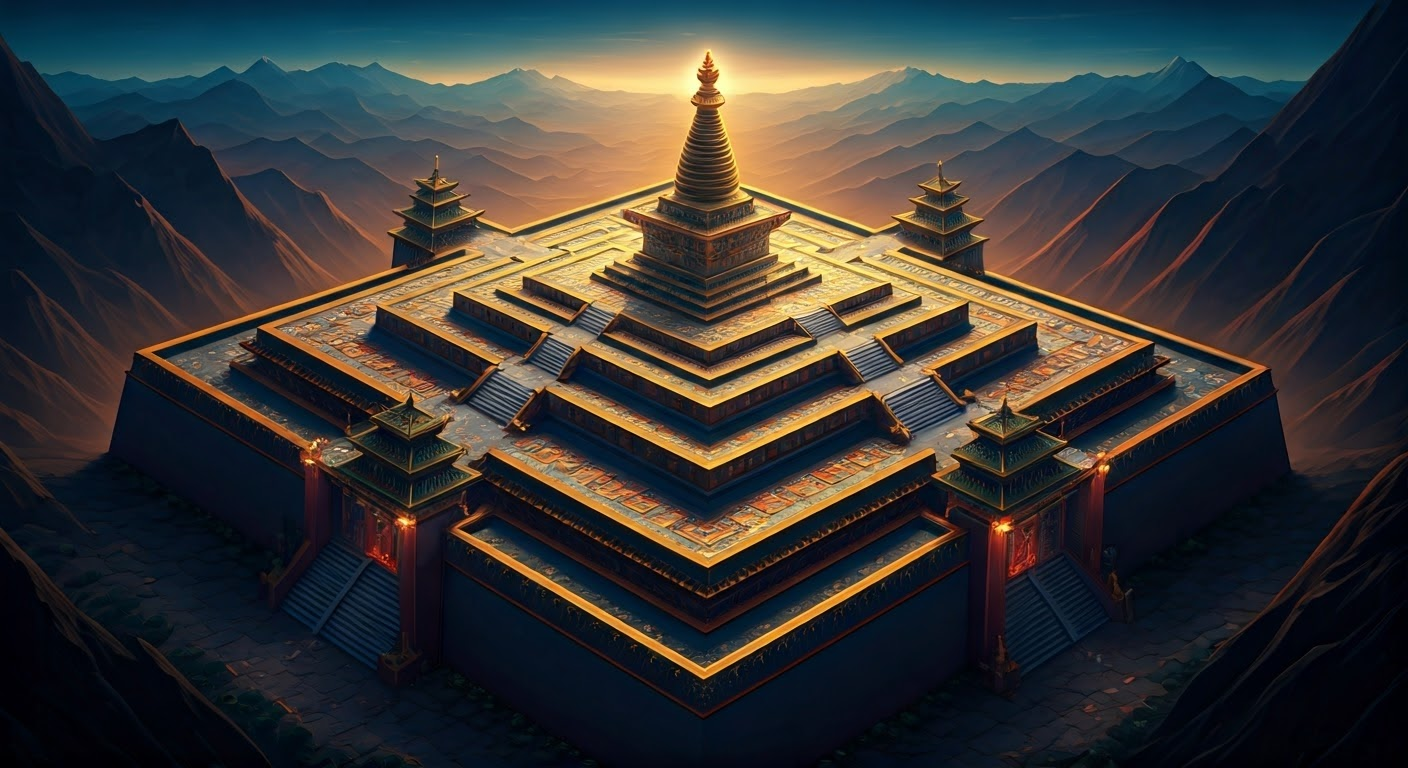
In Tibetan Buddhist tradition, the mandala—a cosmological diagram used for meditation and ritual—typically features a square temple structure with four gates opening to the four cardinal directions. This square represents the ordered universe with Mount Meru at its center. The square's four gates symbolize the four immeasurables: loving-kindness, compassion, sympathetic joy, and equanimity. Practitioners mentally enter this square structure during visualization practices, moving from the outer world of ordinary perception to increasingly subtle levels of spiritual reality toward the center.
The stupa—Buddhism's most characteristic architectural form—often rises from a square base through progressively more circular levels, culminating in a spire. This architectural progression from square to circle physically embodies the spiritual journey from material existence to enlightenment. The square base grounds the structure firmly in the physical world while supporting the transcendent forms above, symbolizing how mundane reality serves as the necessary foundation for spiritual attainment.
Pythagorean number philosophy viewed the square with special reverence. The number four (tetrad) represented justice because of its equal division into equal parts—a mathematical expression of fairness and balance. The square number (a number multiplied by itself) represented the principle of justice applied to itself, creating perfect stability and order. This mathematical understanding influenced Western philosophical traditions for centuries, establishing the square as a symbol of cosmic justice and proper proportion.
Perhaps the square's most profound significance emerges through its relationship with the circle. These two primary forms—the square representing earth and the circle representing heaven—appear together across diverse spiritual traditions. Their relationship symbolizes the fundamental dynamic between matter and spirit, limitation and infinity, time and eternity.
In Chinese cosmology, the square earth and round heaven represent complementary cosmic principles. The Temple of Heaven in Beijing embodies this concept architecturally: its circular Hall of Prayer for Good Harvests sits on a square foundation. The square base represents the earth that receives heaven's blessings, while the circular upper structure represents the divine realm from which those blessings flow. This arrangement visually depicts the harmonious relationship between heaven and earth—a central concept in Chinese spiritual understanding.
The challenge of "squaring the circle"—constructing a square with the same area as a given circle—fascinated mathematicians and mystics for centuries. Though proven mathematically impossible (requiring the square root of π, which is transcendental), this geometric problem symbolized the spiritual quest to reconcile material and divine realities. The impossibility of perfect resolution through rational means suggests that the ultimate harmony between square and circle—matter and spirit—requires transcending ordinary consciousness rather than intellectual calculation.
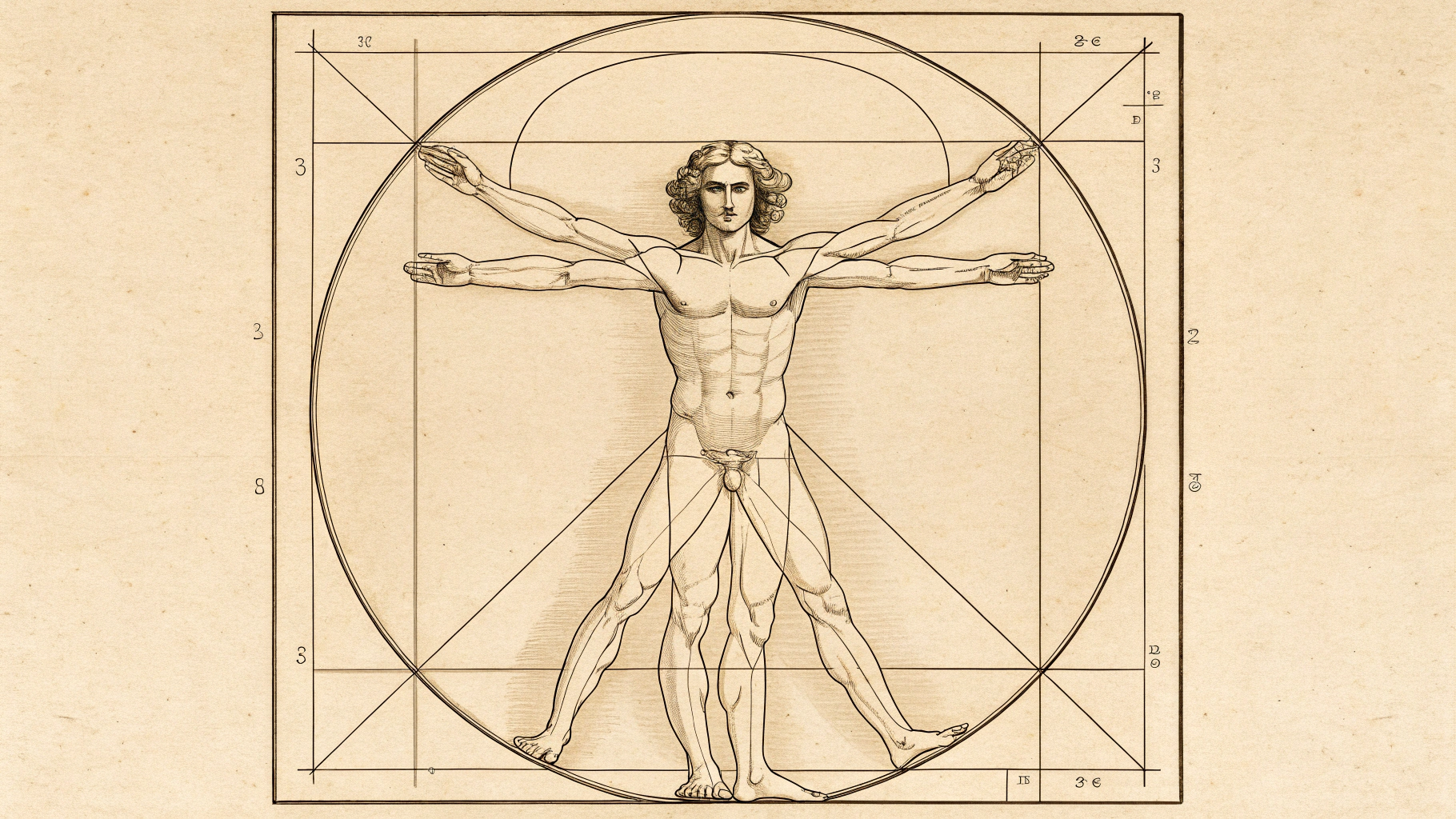
Leonardo da Vinci's famous Vitruvian Man illustrates the relationship between square and circle through human proportion. The human figure—with navel at the center—is shown inscribed within both a circle and a square. This image powerfully suggests that humanity stands at the intersection of material and spiritual realms, capable of understanding and embodying both principles. The human body itself serves as the mediator between square and circle, between earth and heaven—a living bridge between worlds.
As we conclude our exploration of these four fundamental shapes—the point, circle, triangle, and square—we recognize them not merely as mathematical constructs but as visual keys that unlock deeper understanding of existence itself. These primal forms reveal themselves across scales and dimensions, from the microscopic architecture of crystals to the vast movements of celestial bodies, from ancient temples to modern physics equations. Their relationships and proportions speak a universal language that transcends cultural boundaries and historical epochs. When we contemplate these sacred forms, we engage in a meditation practiced by seekers throughout human history—recognizing how the visible world of form points toward invisible principles that govern both matter and consciousness.
The square grounds us in material reality while the circle connects us to eternity; the triangle demonstrates how relation creates stability while the point reminds us of our origin in unity. Through sacred geometry, we discover that mathematics is not merely calculation but revelation—a pathway to perceiving the elegant simplicity underlying the magnificent complexity of creation. In studying these forms, we don't just observe external patterns but recognize reflections of the internal architecture of awareness itself, finding ourselves simultaneously at the center and the circumference of a universe ordered by profound mathematical harmony.


